Research Project: CRM and Customer Satisfaction in Australian Retail
VerifiedAdded on 2021/05/31
|34
|10891
|126
Report
AI Summary
This research project investigates the effectiveness of Customer Relationship Management (CRM) in enhancing customer satisfaction within the Australian retail industry. The study explores the implementation of CRM systems, examining their impact on customer experience, business focus, and acquisition of new customers. The paper addresses key research questions, including the increasing attention CRM receives, the relationship between CRM and customer satisfaction, and CRM's overall effect on customer satisfaction. The literature review covers various aspects of CRM, including analytical and behavioral CRM, and highlights the importance of customer satisfaction and loyalty. The research draws on previous studies that explore the relationship between CRM, customer satisfaction, customer loyalty, and word-of-mouth, providing insights into the mechanisms that influence customer behavior. The study emphasizes the challenges faced by Australian retail businesses due to technological advancements, globalization, and increased competition, concluding that effective CRM strategies are essential for achieving high customer satisfaction and building lasting relationships.
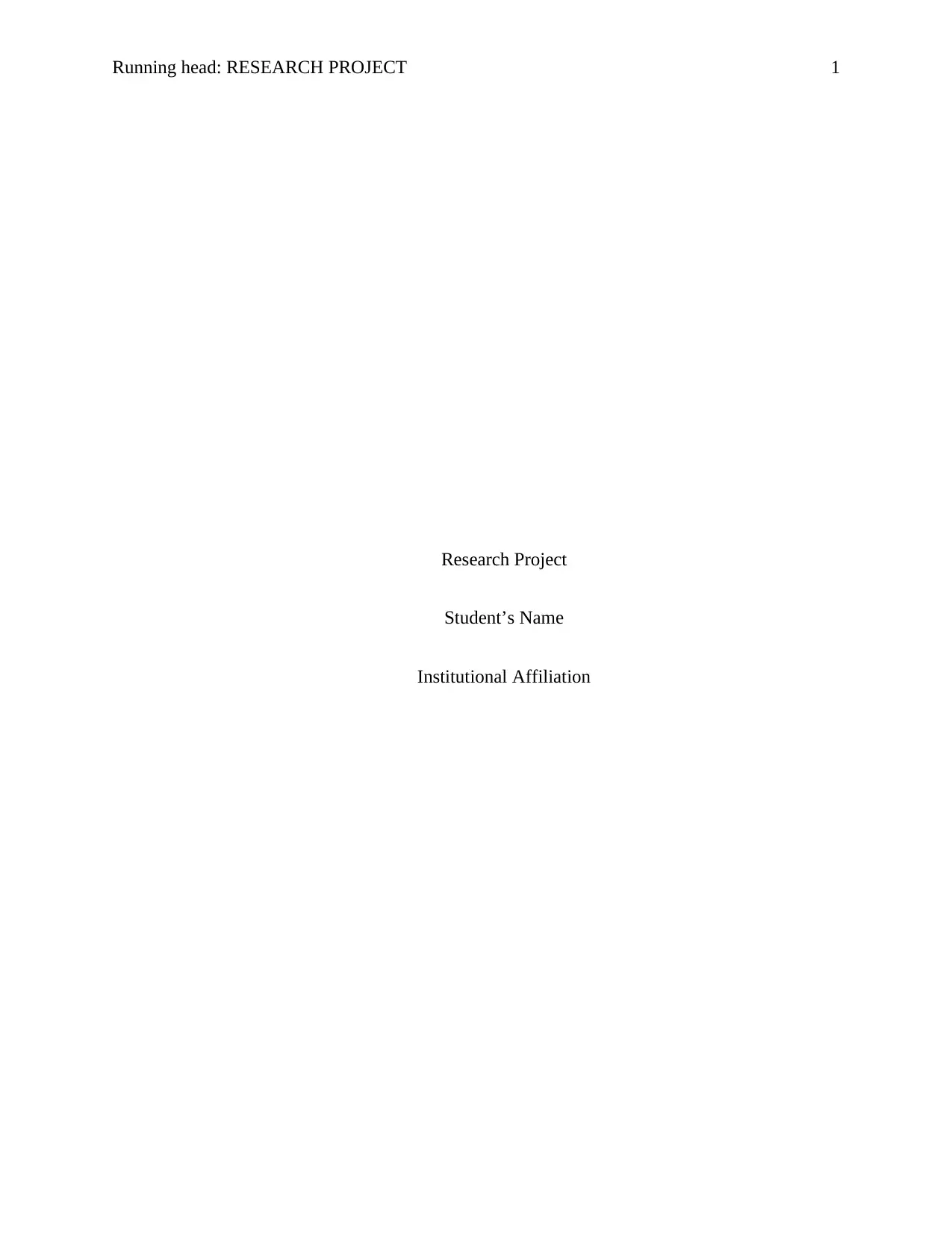
Running head: RESEARCH PROJECT 1
Research Project
Student’s Name
Institutional Affiliation
Research Project
Student’s Name
Institutional Affiliation
Secure Best Marks with AI Grader
Need help grading? Try our AI Grader for instant feedback on your assignments.
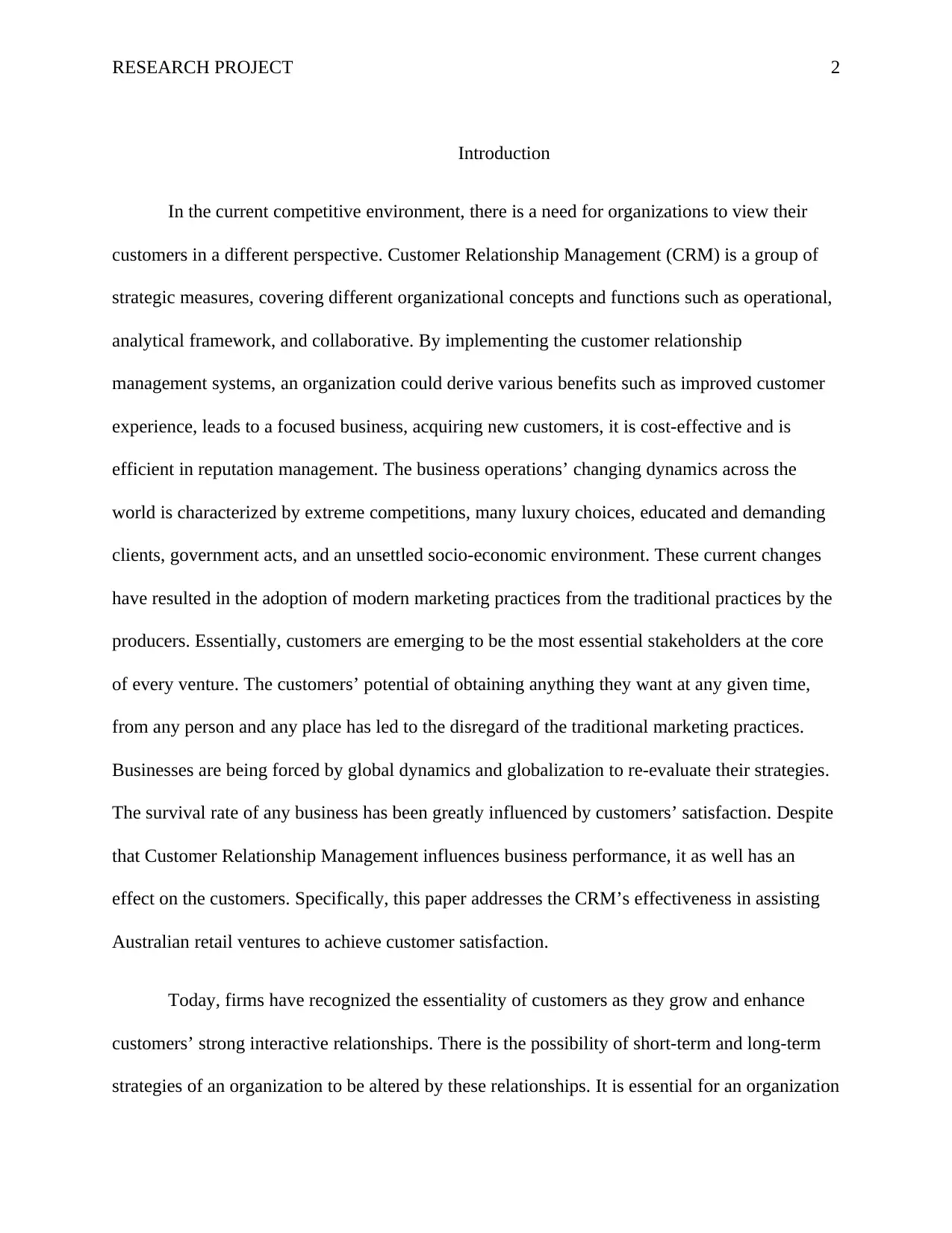
RESEARCH PROJECT 2
Introduction
In the current competitive environment, there is a need for organizations to view their
customers in a different perspective. Customer Relationship Management (CRM) is a group of
strategic measures, covering different organizational concepts and functions such as operational,
analytical framework, and collaborative. By implementing the customer relationship
management systems, an organization could derive various benefits such as improved customer
experience, leads to a focused business, acquiring new customers, it is cost-effective and is
efficient in reputation management. The business operations’ changing dynamics across the
world is characterized by extreme competitions, many luxury choices, educated and demanding
clients, government acts, and an unsettled socio-economic environment. These current changes
have resulted in the adoption of modern marketing practices from the traditional practices by the
producers. Essentially, customers are emerging to be the most essential stakeholders at the core
of every venture. The customers’ potential of obtaining anything they want at any given time,
from any person and any place has led to the disregard of the traditional marketing practices.
Businesses are being forced by global dynamics and globalization to re-evaluate their strategies.
The survival rate of any business has been greatly influenced by customers’ satisfaction. Despite
that Customer Relationship Management influences business performance, it as well has an
effect on the customers. Specifically, this paper addresses the CRM’s effectiveness in assisting
Australian retail ventures to achieve customer satisfaction.
Today, firms have recognized the essentiality of customers as they grow and enhance
customers’ strong interactive relationships. There is the possibility of short-term and long-term
strategies of an organization to be altered by these relationships. It is essential for an organization
Introduction
In the current competitive environment, there is a need for organizations to view their
customers in a different perspective. Customer Relationship Management (CRM) is a group of
strategic measures, covering different organizational concepts and functions such as operational,
analytical framework, and collaborative. By implementing the customer relationship
management systems, an organization could derive various benefits such as improved customer
experience, leads to a focused business, acquiring new customers, it is cost-effective and is
efficient in reputation management. The business operations’ changing dynamics across the
world is characterized by extreme competitions, many luxury choices, educated and demanding
clients, government acts, and an unsettled socio-economic environment. These current changes
have resulted in the adoption of modern marketing practices from the traditional practices by the
producers. Essentially, customers are emerging to be the most essential stakeholders at the core
of every venture. The customers’ potential of obtaining anything they want at any given time,
from any person and any place has led to the disregard of the traditional marketing practices.
Businesses are being forced by global dynamics and globalization to re-evaluate their strategies.
The survival rate of any business has been greatly influenced by customers’ satisfaction. Despite
that Customer Relationship Management influences business performance, it as well has an
effect on the customers. Specifically, this paper addresses the CRM’s effectiveness in assisting
Australian retail ventures to achieve customer satisfaction.
Today, firms have recognized the essentiality of customers as they grow and enhance
customers’ strong interactive relationships. There is the possibility of short-term and long-term
strategies of an organization to be altered by these relationships. It is essential for an organization
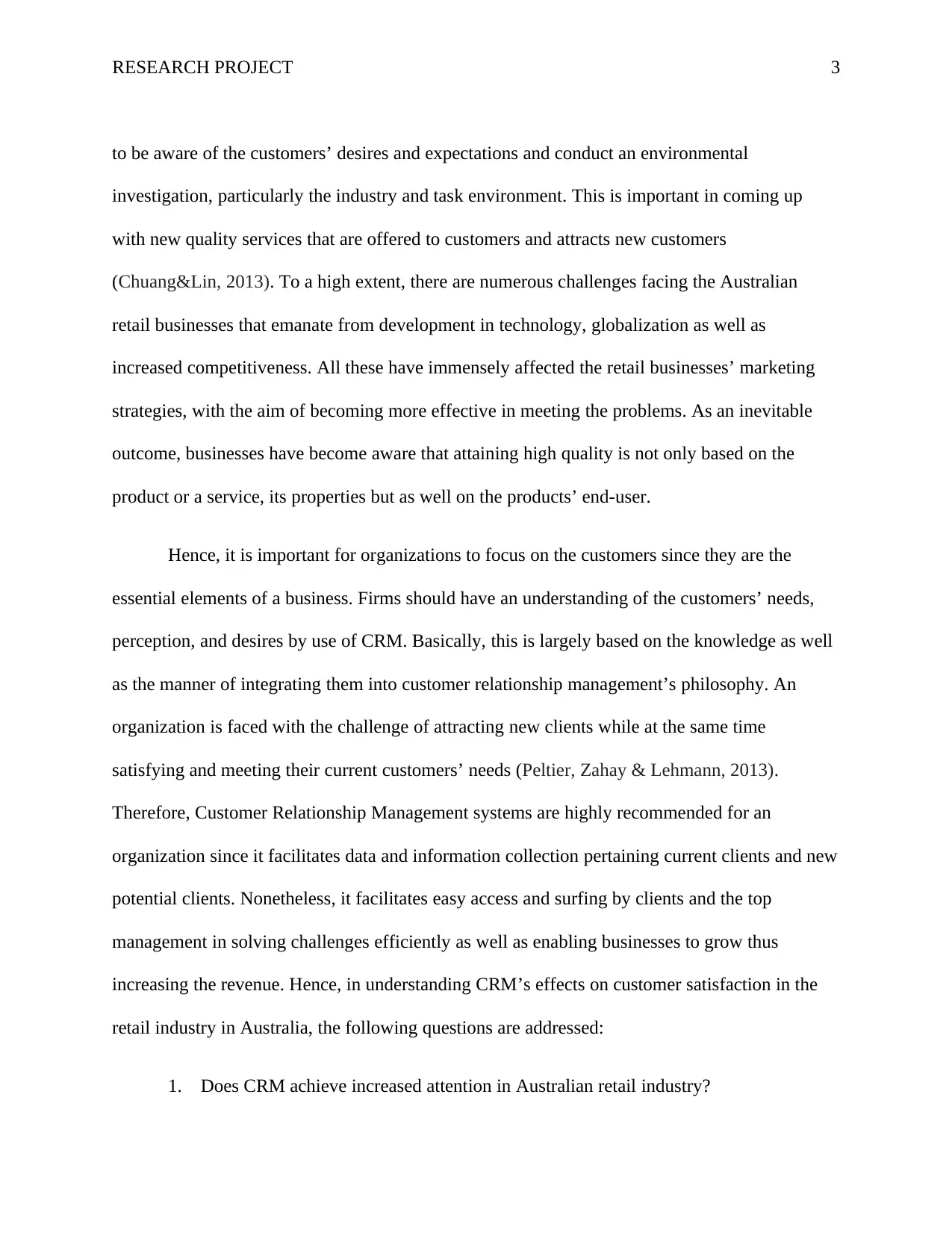
RESEARCH PROJECT 3
to be aware of the customers’ desires and expectations and conduct an environmental
investigation, particularly the industry and task environment. This is important in coming up
with new quality services that are offered to customers and attracts new customers
(Chuang&Lin, 2013). To a high extent, there are numerous challenges facing the Australian
retail businesses that emanate from development in technology, globalization as well as
increased competitiveness. All these have immensely affected the retail businesses’ marketing
strategies, with the aim of becoming more effective in meeting the problems. As an inevitable
outcome, businesses have become aware that attaining high quality is not only based on the
product or a service, its properties but as well on the products’ end-user.
Hence, it is important for organizations to focus on the customers since they are the
essential elements of a business. Firms should have an understanding of the customers’ needs,
perception, and desires by use of CRM. Basically, this is largely based on the knowledge as well
as the manner of integrating them into customer relationship management’s philosophy. An
organization is faced with the challenge of attracting new clients while at the same time
satisfying and meeting their current customers’ needs (Peltier, Zahay & Lehmann, 2013).
Therefore, Customer Relationship Management systems are highly recommended for an
organization since it facilitates data and information collection pertaining current clients and new
potential clients. Nonetheless, it facilitates easy access and surfing by clients and the top
management in solving challenges efficiently as well as enabling businesses to grow thus
increasing the revenue. Hence, in understanding CRM’s effects on customer satisfaction in the
retail industry in Australia, the following questions are addressed:
1. Does CRM achieve increased attention in Australian retail industry?
to be aware of the customers’ desires and expectations and conduct an environmental
investigation, particularly the industry and task environment. This is important in coming up
with new quality services that are offered to customers and attracts new customers
(Chuang&Lin, 2013). To a high extent, there are numerous challenges facing the Australian
retail businesses that emanate from development in technology, globalization as well as
increased competitiveness. All these have immensely affected the retail businesses’ marketing
strategies, with the aim of becoming more effective in meeting the problems. As an inevitable
outcome, businesses have become aware that attaining high quality is not only based on the
product or a service, its properties but as well on the products’ end-user.
Hence, it is important for organizations to focus on the customers since they are the
essential elements of a business. Firms should have an understanding of the customers’ needs,
perception, and desires by use of CRM. Basically, this is largely based on the knowledge as well
as the manner of integrating them into customer relationship management’s philosophy. An
organization is faced with the challenge of attracting new clients while at the same time
satisfying and meeting their current customers’ needs (Peltier, Zahay & Lehmann, 2013).
Therefore, Customer Relationship Management systems are highly recommended for an
organization since it facilitates data and information collection pertaining current clients and new
potential clients. Nonetheless, it facilitates easy access and surfing by clients and the top
management in solving challenges efficiently as well as enabling businesses to grow thus
increasing the revenue. Hence, in understanding CRM’s effects on customer satisfaction in the
retail industry in Australia, the following questions are addressed:
1. Does CRM achieve increased attention in Australian retail industry?
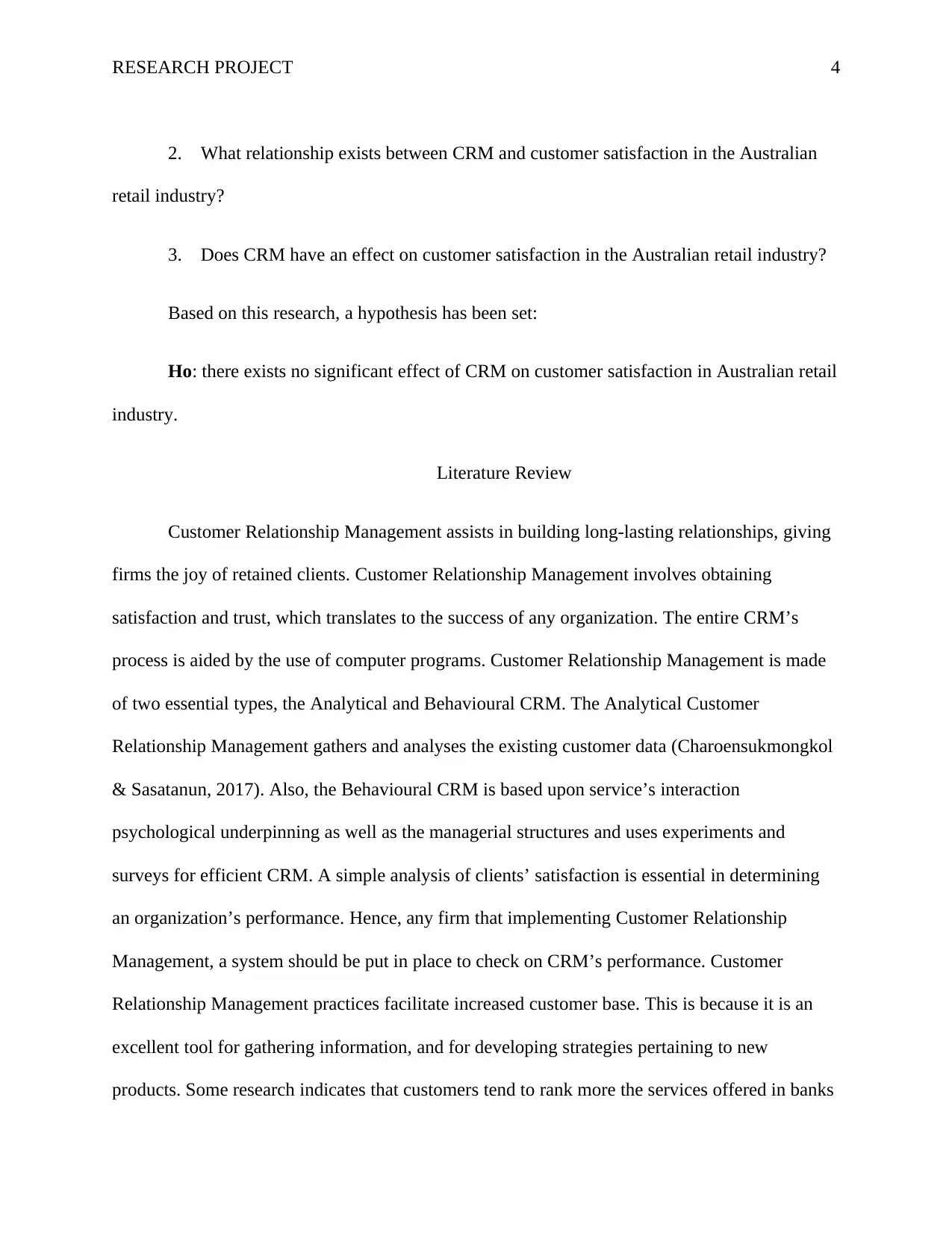
RESEARCH PROJECT 4
2. What relationship exists between CRM and customer satisfaction in the Australian
retail industry?
3. Does CRM have an effect on customer satisfaction in the Australian retail industry?
Based on this research, a hypothesis has been set:
Ho: there exists no significant effect of CRM on customer satisfaction in Australian retail
industry.
Literature Review
Customer Relationship Management assists in building long-lasting relationships, giving
firms the joy of retained clients. Customer Relationship Management involves obtaining
satisfaction and trust, which translates to the success of any organization. The entire CRM’s
process is aided by the use of computer programs. Customer Relationship Management is made
of two essential types, the Analytical and Behavioural CRM. The Analytical Customer
Relationship Management gathers and analyses the existing customer data (Charoensukmongkol
& Sasatanun, 2017). Also, the Behavioural CRM is based upon service’s interaction
psychological underpinning as well as the managerial structures and uses experiments and
surveys for efficient CRM. A simple analysis of clients’ satisfaction is essential in determining
an organization’s performance. Hence, any firm that implementing Customer Relationship
Management, a system should be put in place to check on CRM’s performance. Customer
Relationship Management practices facilitate increased customer base. This is because it is an
excellent tool for gathering information, and for developing strategies pertaining to new
products. Some research indicates that customers tend to rank more the services offered in banks
2. What relationship exists between CRM and customer satisfaction in the Australian
retail industry?
3. Does CRM have an effect on customer satisfaction in the Australian retail industry?
Based on this research, a hypothesis has been set:
Ho: there exists no significant effect of CRM on customer satisfaction in Australian retail
industry.
Literature Review
Customer Relationship Management assists in building long-lasting relationships, giving
firms the joy of retained clients. Customer Relationship Management involves obtaining
satisfaction and trust, which translates to the success of any organization. The entire CRM’s
process is aided by the use of computer programs. Customer Relationship Management is made
of two essential types, the Analytical and Behavioural CRM. The Analytical Customer
Relationship Management gathers and analyses the existing customer data (Charoensukmongkol
& Sasatanun, 2017). Also, the Behavioural CRM is based upon service’s interaction
psychological underpinning as well as the managerial structures and uses experiments and
surveys for efficient CRM. A simple analysis of clients’ satisfaction is essential in determining
an organization’s performance. Hence, any firm that implementing Customer Relationship
Management, a system should be put in place to check on CRM’s performance. Customer
Relationship Management practices facilitate increased customer base. This is because it is an
excellent tool for gathering information, and for developing strategies pertaining to new
products. Some research indicates that customers tend to rank more the services offered in banks
Secure Best Marks with AI Grader
Need help grading? Try our AI Grader for instant feedback on your assignments.
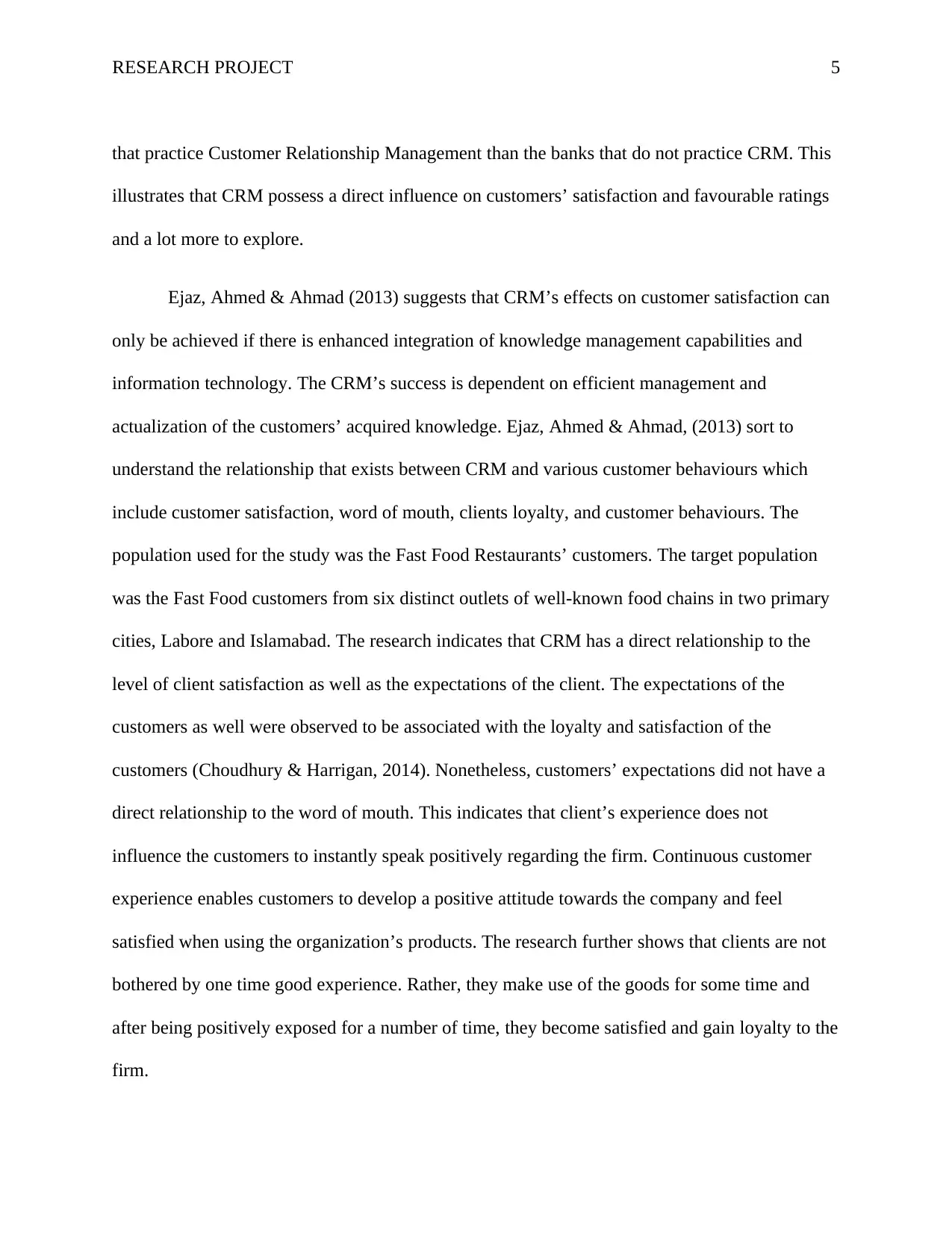
RESEARCH PROJECT 5
that practice Customer Relationship Management than the banks that do not practice CRM. This
illustrates that CRM possess a direct influence on customers’ satisfaction and favourable ratings
and a lot more to explore.
Ejaz, Ahmed & Ahmad (2013) suggests that CRM’s effects on customer satisfaction can
only be achieved if there is enhanced integration of knowledge management capabilities and
information technology. The CRM’s success is dependent on efficient management and
actualization of the customers’ acquired knowledge. Ejaz, Ahmed & Ahmad, (2013) sort to
understand the relationship that exists between CRM and various customer behaviours which
include customer satisfaction, word of mouth, clients loyalty, and customer behaviours. The
population used for the study was the Fast Food Restaurants’ customers. The target population
was the Fast Food customers from six distinct outlets of well-known food chains in two primary
cities, Labore and Islamabad. The research indicates that CRM has a direct relationship to the
level of client satisfaction as well as the expectations of the client. The expectations of the
customers as well were observed to be associated with the loyalty and satisfaction of the
customers (Choudhury & Harrigan, 2014). Nonetheless, customers’ expectations did not have a
direct relationship to the word of mouth. This indicates that client’s experience does not
influence the customers to instantly speak positively regarding the firm. Continuous customer
experience enables customers to develop a positive attitude towards the company and feel
satisfied when using the organization’s products. The research further shows that clients are not
bothered by one time good experience. Rather, they make use of the goods for some time and
after being positively exposed for a number of time, they become satisfied and gain loyalty to the
firm.
that practice Customer Relationship Management than the banks that do not practice CRM. This
illustrates that CRM possess a direct influence on customers’ satisfaction and favourable ratings
and a lot more to explore.
Ejaz, Ahmed & Ahmad (2013) suggests that CRM’s effects on customer satisfaction can
only be achieved if there is enhanced integration of knowledge management capabilities and
information technology. The CRM’s success is dependent on efficient management and
actualization of the customers’ acquired knowledge. Ejaz, Ahmed & Ahmad, (2013) sort to
understand the relationship that exists between CRM and various customer behaviours which
include customer satisfaction, word of mouth, clients loyalty, and customer behaviours. The
population used for the study was the Fast Food Restaurants’ customers. The target population
was the Fast Food customers from six distinct outlets of well-known food chains in two primary
cities, Labore and Islamabad. The research indicates that CRM has a direct relationship to the
level of client satisfaction as well as the expectations of the client. The expectations of the
customers as well were observed to be associated with the loyalty and satisfaction of the
customers (Choudhury & Harrigan, 2014). Nonetheless, customers’ expectations did not have a
direct relationship to the word of mouth. This indicates that client’s experience does not
influence the customers to instantly speak positively regarding the firm. Continuous customer
experience enables customers to develop a positive attitude towards the company and feel
satisfied when using the organization’s products. The research further shows that clients are not
bothered by one time good experience. Rather, they make use of the goods for some time and
after being positively exposed for a number of time, they become satisfied and gain loyalty to the
firm.
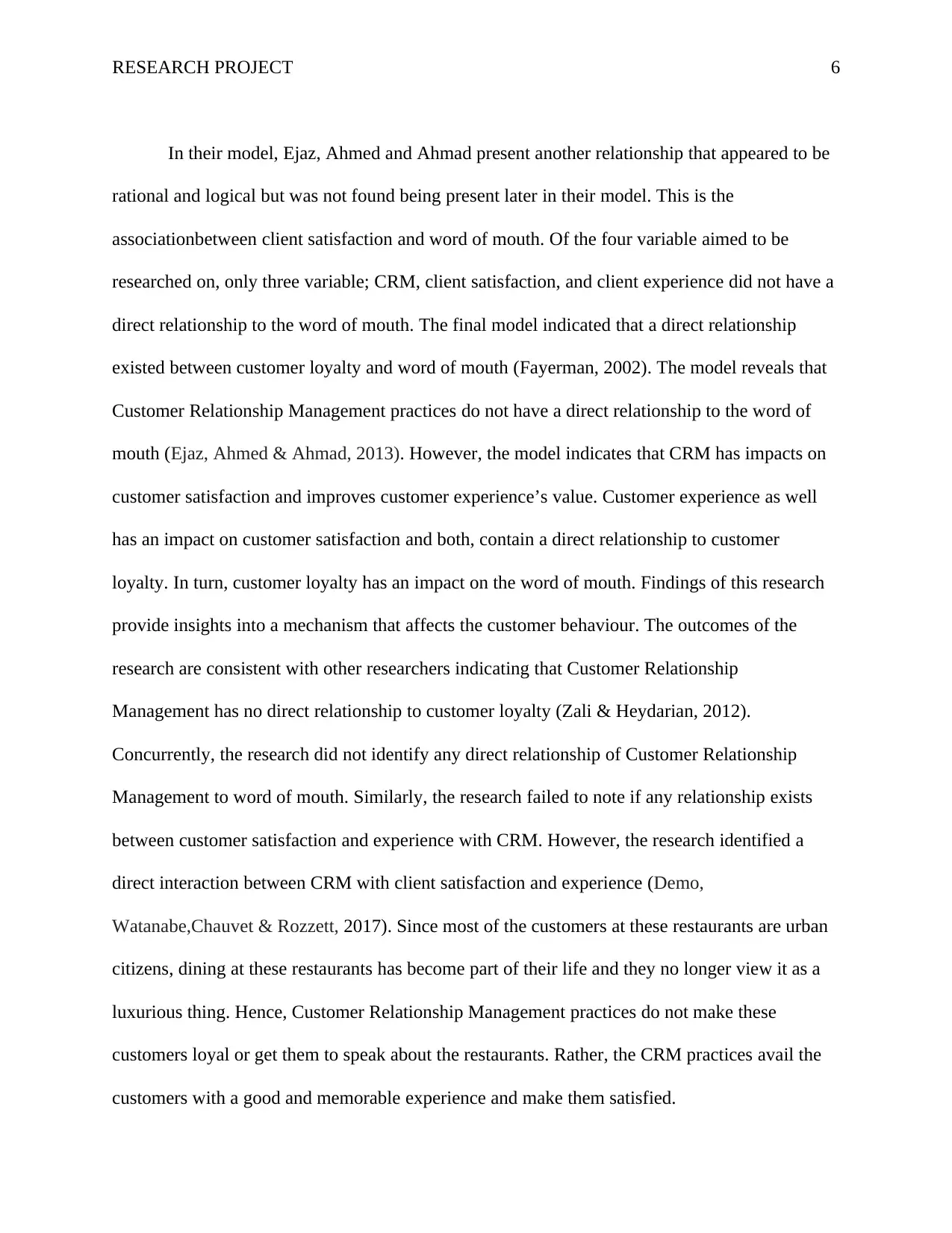
RESEARCH PROJECT 6
In their model, Ejaz, Ahmed and Ahmad present another relationship that appeared to be
rational and logical but was not found being present later in their model. This is the
associationbetween client satisfaction and word of mouth. Of the four variable aimed to be
researched on, only three variable; CRM, client satisfaction, and client experience did not have a
direct relationship to the word of mouth. The final model indicated that a direct relationship
existed between customer loyalty and word of mouth (Fayerman, 2002). The model reveals that
Customer Relationship Management practices do not have a direct relationship to the word of
mouth (Ejaz, Ahmed & Ahmad, 2013). However, the model indicates that CRM has impacts on
customer satisfaction and improves customer experience’s value. Customer experience as well
has an impact on customer satisfaction and both, contain a direct relationship to customer
loyalty. In turn, customer loyalty has an impact on the word of mouth. Findings of this research
provide insights into a mechanism that affects the customer behaviour. The outcomes of the
research are consistent with other researchers indicating that Customer Relationship
Management has no direct relationship to customer loyalty (Zali & Heydarian, 2012).
Concurrently, the research did not identify any direct relationship of Customer Relationship
Management to word of mouth. Similarly, the research failed to note if any relationship exists
between customer satisfaction and experience with CRM. However, the research identified a
direct interaction between CRM with client satisfaction and experience (Demo,
Watanabe,Chauvet & Rozzett, 2017). Since most of the customers at these restaurants are urban
citizens, dining at these restaurants has become part of their life and they no longer view it as a
luxurious thing. Hence, Customer Relationship Management practices do not make these
customers loyal or get them to speak about the restaurants. Rather, the CRM practices avail the
customers with a good and memorable experience and make them satisfied.
In their model, Ejaz, Ahmed and Ahmad present another relationship that appeared to be
rational and logical but was not found being present later in their model. This is the
associationbetween client satisfaction and word of mouth. Of the four variable aimed to be
researched on, only three variable; CRM, client satisfaction, and client experience did not have a
direct relationship to the word of mouth. The final model indicated that a direct relationship
existed between customer loyalty and word of mouth (Fayerman, 2002). The model reveals that
Customer Relationship Management practices do not have a direct relationship to the word of
mouth (Ejaz, Ahmed & Ahmad, 2013). However, the model indicates that CRM has impacts on
customer satisfaction and improves customer experience’s value. Customer experience as well
has an impact on customer satisfaction and both, contain a direct relationship to customer
loyalty. In turn, customer loyalty has an impact on the word of mouth. Findings of this research
provide insights into a mechanism that affects the customer behaviour. The outcomes of the
research are consistent with other researchers indicating that Customer Relationship
Management has no direct relationship to customer loyalty (Zali & Heydarian, 2012).
Concurrently, the research did not identify any direct relationship of Customer Relationship
Management to word of mouth. Similarly, the research failed to note if any relationship exists
between customer satisfaction and experience with CRM. However, the research identified a
direct interaction between CRM with client satisfaction and experience (Demo,
Watanabe,Chauvet & Rozzett, 2017). Since most of the customers at these restaurants are urban
citizens, dining at these restaurants has become part of their life and they no longer view it as a
luxurious thing. Hence, Customer Relationship Management practices do not make these
customers loyal or get them to speak about the restaurants. Rather, the CRM practices avail the
customers with a good and memorable experience and make them satisfied.
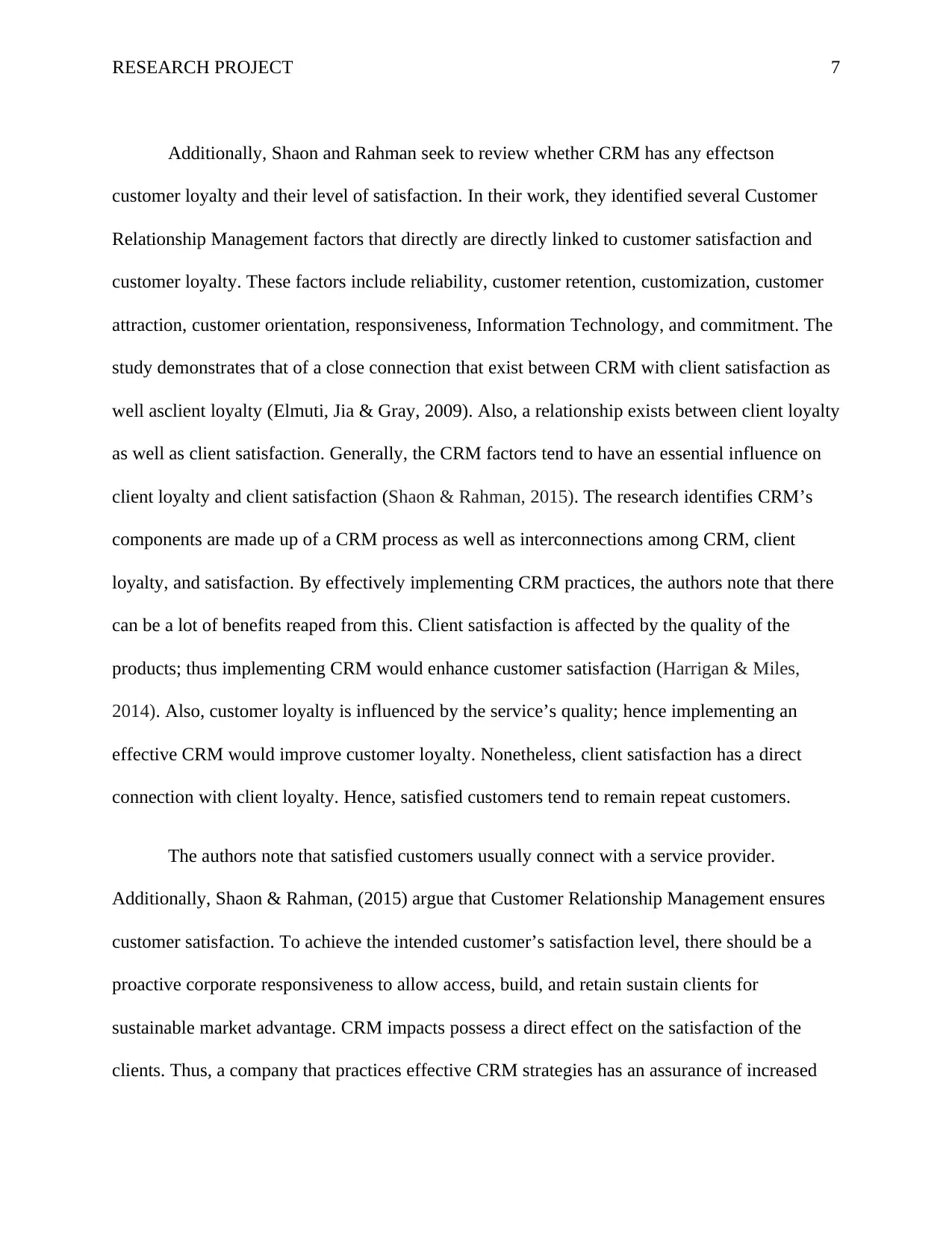
RESEARCH PROJECT 7
Additionally, Shaon and Rahman seek to review whether CRM has any effectson
customer loyalty and their level of satisfaction. In their work, they identified several Customer
Relationship Management factors that directly are directly linked to customer satisfaction and
customer loyalty. These factors include reliability, customer retention, customization, customer
attraction, customer orientation, responsiveness, Information Technology, and commitment. The
study demonstrates that of a close connection that exist between CRM with client satisfaction as
well asclient loyalty (Elmuti, Jia & Gray, 2009). Also, a relationship exists between client loyalty
as well as client satisfaction. Generally, the CRM factors tend to have an essential influence on
client loyalty and client satisfaction (Shaon & Rahman, 2015). The research identifies CRM’s
components are made up of a CRM process as well as interconnections among CRM, client
loyalty, and satisfaction. By effectively implementing CRM practices, the authors note that there
can be a lot of benefits reaped from this. Client satisfaction is affected by the quality of the
products; thus implementing CRM would enhance customer satisfaction (Harrigan & Miles,
2014). Also, customer loyalty is influenced by the service’s quality; hence implementing an
effective CRM would improve customer loyalty. Nonetheless, client satisfaction has a direct
connection with client loyalty. Hence, satisfied customers tend to remain repeat customers.
The authors note that satisfied customers usually connect with a service provider.
Additionally, Shaon & Rahman, (2015) argue that Customer Relationship Management ensures
customer satisfaction. To achieve the intended customer’s satisfaction level, there should be a
proactive corporate responsiveness to allow access, build, and retain sustain clients for
sustainable market advantage. CRM impacts possess a direct effect on the satisfaction of the
clients. Thus, a company that practices effective CRM strategies has an assurance of increased
Additionally, Shaon and Rahman seek to review whether CRM has any effectson
customer loyalty and their level of satisfaction. In their work, they identified several Customer
Relationship Management factors that directly are directly linked to customer satisfaction and
customer loyalty. These factors include reliability, customer retention, customization, customer
attraction, customer orientation, responsiveness, Information Technology, and commitment. The
study demonstrates that of a close connection that exist between CRM with client satisfaction as
well asclient loyalty (Elmuti, Jia & Gray, 2009). Also, a relationship exists between client loyalty
as well as client satisfaction. Generally, the CRM factors tend to have an essential influence on
client loyalty and client satisfaction (Shaon & Rahman, 2015). The research identifies CRM’s
components are made up of a CRM process as well as interconnections among CRM, client
loyalty, and satisfaction. By effectively implementing CRM practices, the authors note that there
can be a lot of benefits reaped from this. Client satisfaction is affected by the quality of the
products; thus implementing CRM would enhance customer satisfaction (Harrigan & Miles,
2014). Also, customer loyalty is influenced by the service’s quality; hence implementing an
effective CRM would improve customer loyalty. Nonetheless, client satisfaction has a direct
connection with client loyalty. Hence, satisfied customers tend to remain repeat customers.
The authors note that satisfied customers usually connect with a service provider.
Additionally, Shaon & Rahman, (2015) argue that Customer Relationship Management ensures
customer satisfaction. To achieve the intended customer’s satisfaction level, there should be a
proactive corporate responsiveness to allow access, build, and retain sustain clients for
sustainable market advantage. CRM impacts possess a direct effect on the satisfaction of the
clients. Thus, a company that practices effective CRM strategies has an assurance of increased
Paraphrase This Document
Need a fresh take? Get an instant paraphrase of this document with our AI Paraphraser
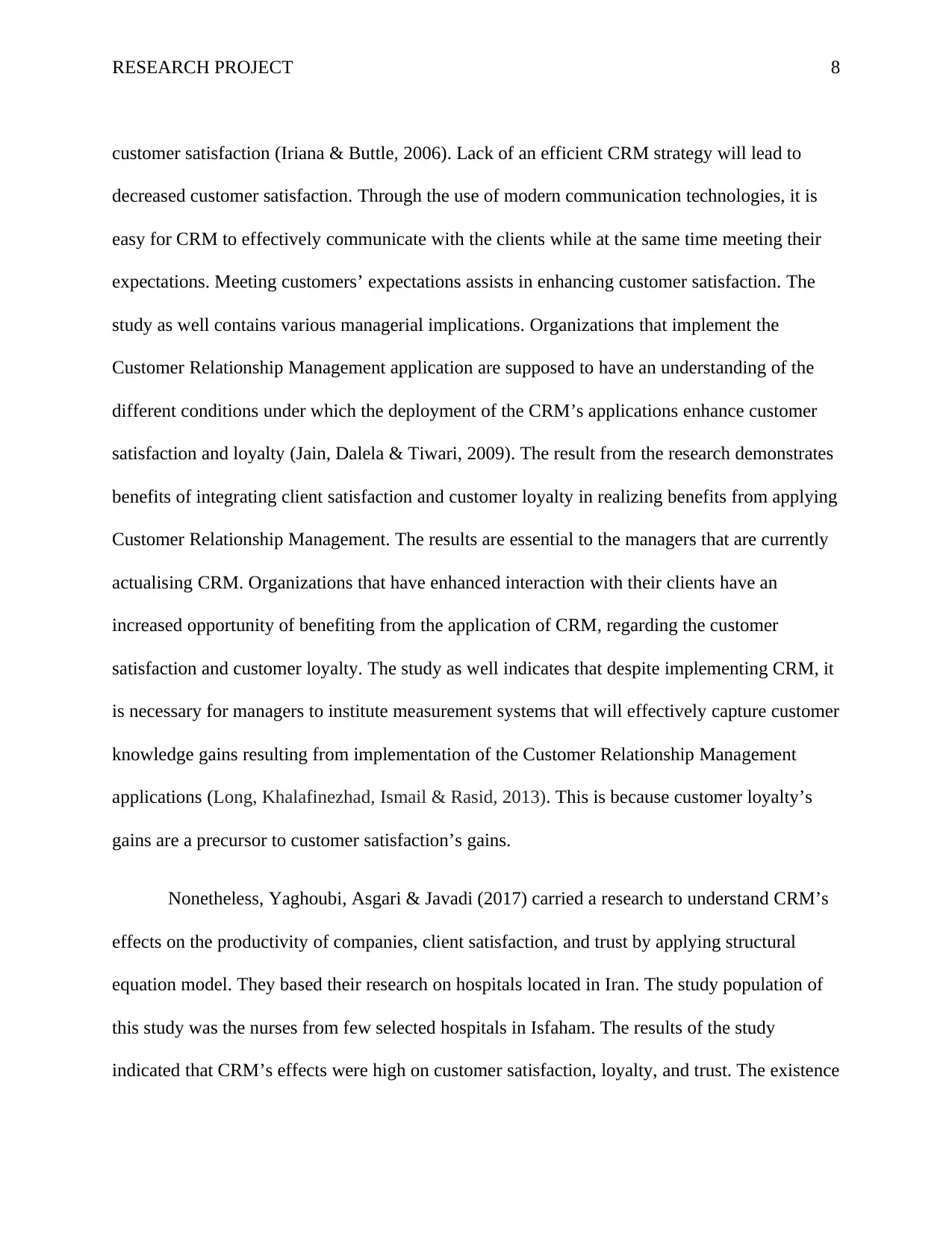
RESEARCH PROJECT 8
customer satisfaction (Iriana & Buttle, 2006). Lack of an efficient CRM strategy will lead to
decreased customer satisfaction. Through the use of modern communication technologies, it is
easy for CRM to effectively communicate with the clients while at the same time meeting their
expectations. Meeting customers’ expectations assists in enhancing customer satisfaction. The
study as well contains various managerial implications. Organizations that implement the
Customer Relationship Management application are supposed to have an understanding of the
different conditions under which the deployment of the CRM’s applications enhance customer
satisfaction and loyalty (Jain, Dalela & Tiwari, 2009). The result from the research demonstrates
benefits of integrating client satisfaction and customer loyalty in realizing benefits from applying
Customer Relationship Management. The results are essential to the managers that are currently
actualising CRM. Organizations that have enhanced interaction with their clients have an
increased opportunity of benefiting from the application of CRM, regarding the customer
satisfaction and customer loyalty. The study as well indicates that despite implementing CRM, it
is necessary for managers to institute measurement systems that will effectively capture customer
knowledge gains resulting from implementation of the Customer Relationship Management
applications (Long, Khalafinezhad, Ismail & Rasid, 2013). This is because customer loyalty’s
gains are a precursor to customer satisfaction’s gains.
Nonetheless, Yaghoubi, Asgari & Javadi (2017) carried a research to understand CRM’s
effects on the productivity of companies, client satisfaction, and trust by applying structural
equation model. They based their research on hospitals located in Iran. The study population of
this study was the nurses from few selected hospitals in Isfaham. The results of the study
indicated that CRM’s effects were high on customer satisfaction, loyalty, and trust. The existence
customer satisfaction (Iriana & Buttle, 2006). Lack of an efficient CRM strategy will lead to
decreased customer satisfaction. Through the use of modern communication technologies, it is
easy for CRM to effectively communicate with the clients while at the same time meeting their
expectations. Meeting customers’ expectations assists in enhancing customer satisfaction. The
study as well contains various managerial implications. Organizations that implement the
Customer Relationship Management application are supposed to have an understanding of the
different conditions under which the deployment of the CRM’s applications enhance customer
satisfaction and loyalty (Jain, Dalela & Tiwari, 2009). The result from the research demonstrates
benefits of integrating client satisfaction and customer loyalty in realizing benefits from applying
Customer Relationship Management. The results are essential to the managers that are currently
actualising CRM. Organizations that have enhanced interaction with their clients have an
increased opportunity of benefiting from the application of CRM, regarding the customer
satisfaction and customer loyalty. The study as well indicates that despite implementing CRM, it
is necessary for managers to institute measurement systems that will effectively capture customer
knowledge gains resulting from implementation of the Customer Relationship Management
applications (Long, Khalafinezhad, Ismail & Rasid, 2013). This is because customer loyalty’s
gains are a precursor to customer satisfaction’s gains.
Nonetheless, Yaghoubi, Asgari & Javadi (2017) carried a research to understand CRM’s
effects on the productivity of companies, client satisfaction, and trust by applying structural
equation model. They based their research on hospitals located in Iran. The study population of
this study was the nurses from few selected hospitals in Isfaham. The results of the study
indicated that CRM’s effects were high on customer satisfaction, loyalty, and trust. The existence
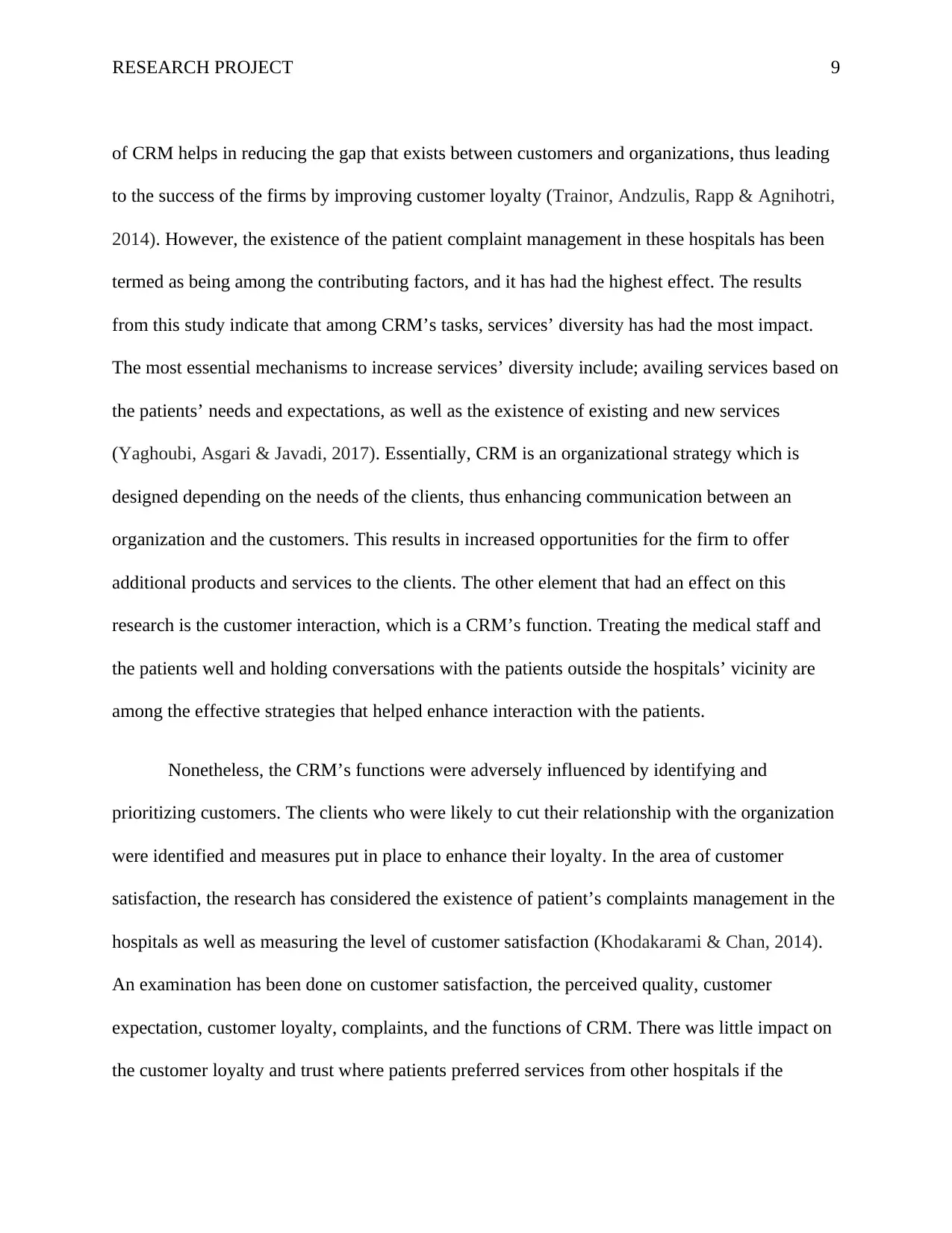
RESEARCH PROJECT 9
of CRM helps in reducing the gap that exists between customers and organizations, thus leading
to the success of the firms by improving customer loyalty (Trainor, Andzulis, Rapp & Agnihotri,
2014). However, the existence of the patient complaint management in these hospitals has been
termed as being among the contributing factors, and it has had the highest effect. The results
from this study indicate that among CRM’s tasks, services’ diversity has had the most impact.
The most essential mechanisms to increase services’ diversity include; availing services based on
the patients’ needs and expectations, as well as the existence of existing and new services
(Yaghoubi, Asgari & Javadi, 2017). Essentially, CRM is an organizational strategy which is
designed depending on the needs of the clients, thus enhancing communication between an
organization and the customers. This results in increased opportunities for the firm to offer
additional products and services to the clients. The other element that had an effect on this
research is the customer interaction, which is a CRM’s function. Treating the medical staff and
the patients well and holding conversations with the patients outside the hospitals’ vicinity are
among the effective strategies that helped enhance interaction with the patients.
Nonetheless, the CRM’s functions were adversely influenced by identifying and
prioritizing customers. The clients who were likely to cut their relationship with the organization
were identified and measures put in place to enhance their loyalty. In the area of customer
satisfaction, the research has considered the existence of patient’s complaints management in the
hospitals as well as measuring the level of customer satisfaction (Khodakarami & Chan, 2014).
An examination has been done on customer satisfaction, the perceived quality, customer
expectation, customer loyalty, complaints, and the functions of CRM. There was little impact on
the customer loyalty and trust where patients preferred services from other hospitals if the
of CRM helps in reducing the gap that exists between customers and organizations, thus leading
to the success of the firms by improving customer loyalty (Trainor, Andzulis, Rapp & Agnihotri,
2014). However, the existence of the patient complaint management in these hospitals has been
termed as being among the contributing factors, and it has had the highest effect. The results
from this study indicate that among CRM’s tasks, services’ diversity has had the most impact.
The most essential mechanisms to increase services’ diversity include; availing services based on
the patients’ needs and expectations, as well as the existence of existing and new services
(Yaghoubi, Asgari & Javadi, 2017). Essentially, CRM is an organizational strategy which is
designed depending on the needs of the clients, thus enhancing communication between an
organization and the customers. This results in increased opportunities for the firm to offer
additional products and services to the clients. The other element that had an effect on this
research is the customer interaction, which is a CRM’s function. Treating the medical staff and
the patients well and holding conversations with the patients outside the hospitals’ vicinity are
among the effective strategies that helped enhance interaction with the patients.
Nonetheless, the CRM’s functions were adversely influenced by identifying and
prioritizing customers. The clients who were likely to cut their relationship with the organization
were identified and measures put in place to enhance their loyalty. In the area of customer
satisfaction, the research has considered the existence of patient’s complaints management in the
hospitals as well as measuring the level of customer satisfaction (Khodakarami & Chan, 2014).
An examination has been done on customer satisfaction, the perceived quality, customer
expectation, customer loyalty, complaints, and the functions of CRM. There was little impact on
the customer loyalty and trust where patients preferred services from other hospitals if the
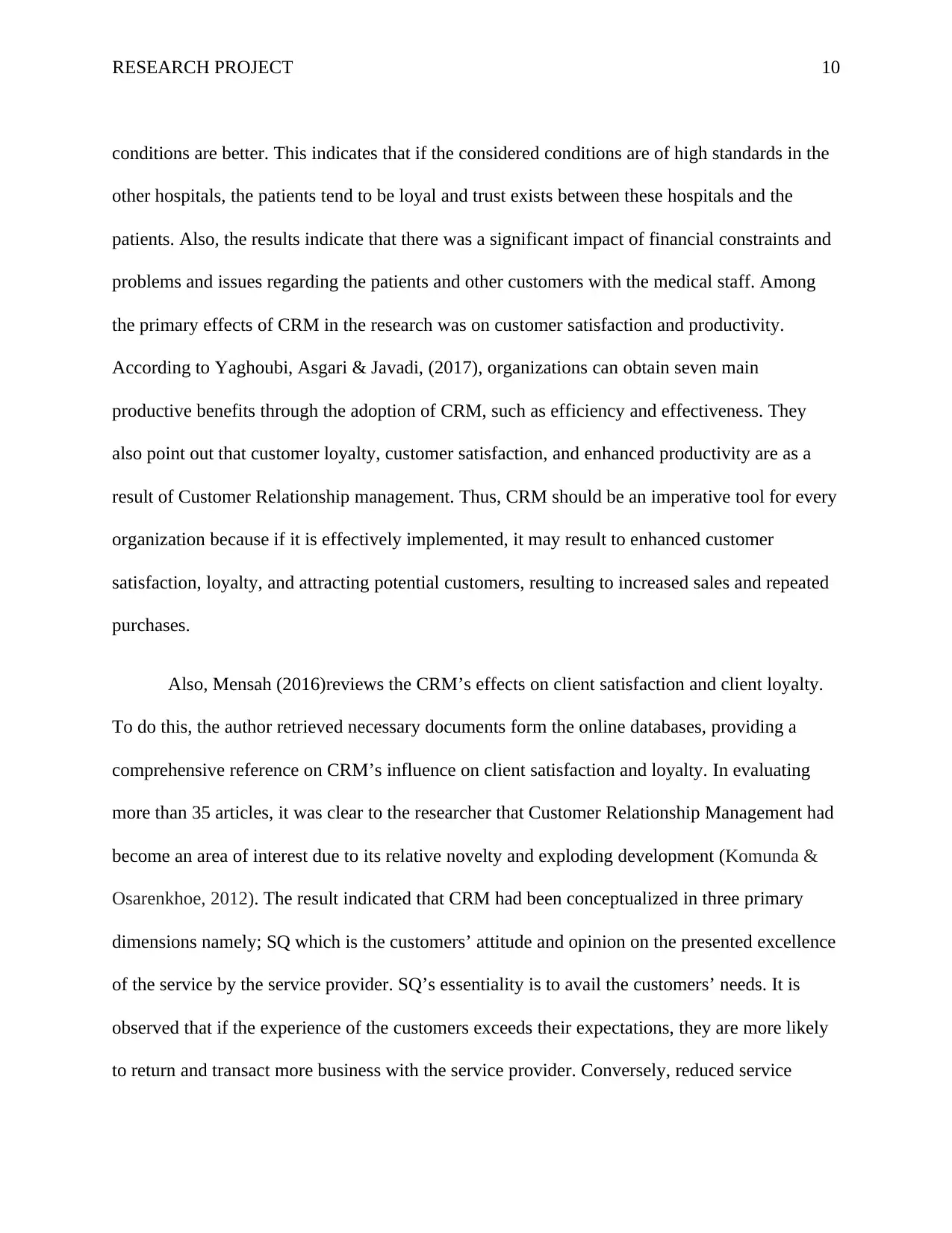
RESEARCH PROJECT 10
conditions are better. This indicates that if the considered conditions are of high standards in the
other hospitals, the patients tend to be loyal and trust exists between these hospitals and the
patients. Also, the results indicate that there was a significant impact of financial constraints and
problems and issues regarding the patients and other customers with the medical staff. Among
the primary effects of CRM in the research was on customer satisfaction and productivity.
According to Yaghoubi, Asgari & Javadi, (2017), organizations can obtain seven main
productive benefits through the adoption of CRM, such as efficiency and effectiveness. They
also point out that customer loyalty, customer satisfaction, and enhanced productivity are as a
result of Customer Relationship management. Thus, CRM should be an imperative tool for every
organization because if it is effectively implemented, it may result to enhanced customer
satisfaction, loyalty, and attracting potential customers, resulting to increased sales and repeated
purchases.
Also, Mensah (2016)reviews the CRM’s effects on client satisfaction and client loyalty.
To do this, the author retrieved necessary documents form the online databases, providing a
comprehensive reference on CRM’s influence on client satisfaction and loyalty. In evaluating
more than 35 articles, it was clear to the researcher that Customer Relationship Management had
become an area of interest due to its relative novelty and exploding development (Komunda &
Osarenkhoe, 2012). The result indicated that CRM had been conceptualized in three primary
dimensions namely; SQ which is the customers’ attitude and opinion on the presented excellence
of the service by the service provider. SQ’s essentiality is to avail the customers’ needs. It is
observed that if the experience of the customers exceeds their expectations, they are more likely
to return and transact more business with the service provider. Conversely, reduced service
conditions are better. This indicates that if the considered conditions are of high standards in the
other hospitals, the patients tend to be loyal and trust exists between these hospitals and the
patients. Also, the results indicate that there was a significant impact of financial constraints and
problems and issues regarding the patients and other customers with the medical staff. Among
the primary effects of CRM in the research was on customer satisfaction and productivity.
According to Yaghoubi, Asgari & Javadi, (2017), organizations can obtain seven main
productive benefits through the adoption of CRM, such as efficiency and effectiveness. They
also point out that customer loyalty, customer satisfaction, and enhanced productivity are as a
result of Customer Relationship management. Thus, CRM should be an imperative tool for every
organization because if it is effectively implemented, it may result to enhanced customer
satisfaction, loyalty, and attracting potential customers, resulting to increased sales and repeated
purchases.
Also, Mensah (2016)reviews the CRM’s effects on client satisfaction and client loyalty.
To do this, the author retrieved necessary documents form the online databases, providing a
comprehensive reference on CRM’s influence on client satisfaction and loyalty. In evaluating
more than 35 articles, it was clear to the researcher that Customer Relationship Management had
become an area of interest due to its relative novelty and exploding development (Komunda &
Osarenkhoe, 2012). The result indicated that CRM had been conceptualized in three primary
dimensions namely; SQ which is the customers’ attitude and opinion on the presented excellence
of the service by the service provider. SQ’s essentiality is to avail the customers’ needs. It is
observed that if the experience of the customers exceeds their expectations, they are more likely
to return and transact more business with the service provider. Conversely, reduced service
Secure Best Marks with AI Grader
Need help grading? Try our AI Grader for instant feedback on your assignments.
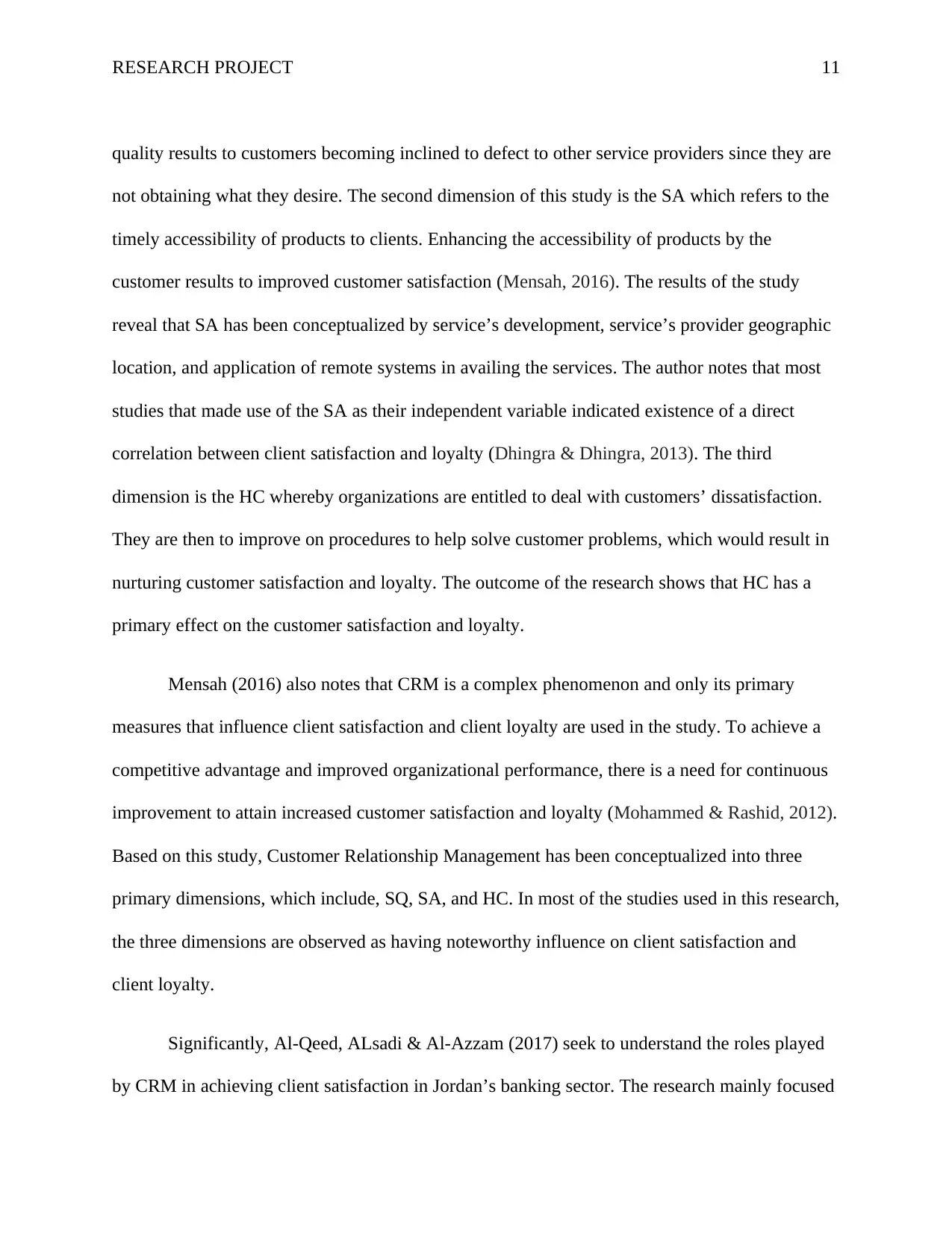
RESEARCH PROJECT 11
quality results to customers becoming inclined to defect to other service providers since they are
not obtaining what they desire. The second dimension of this study is the SA which refers to the
timely accessibility of products to clients. Enhancing the accessibility of products by the
customer results to improved customer satisfaction (Mensah, 2016). The results of the study
reveal that SA has been conceptualized by service’s development, service’s provider geographic
location, and application of remote systems in availing the services. The author notes that most
studies that made use of the SA as their independent variable indicated existence of a direct
correlation between client satisfaction and loyalty (Dhingra & Dhingra, 2013). The third
dimension is the HC whereby organizations are entitled to deal with customers’ dissatisfaction.
They are then to improve on procedures to help solve customer problems, which would result in
nurturing customer satisfaction and loyalty. The outcome of the research shows that HC has a
primary effect on the customer satisfaction and loyalty.
Mensah (2016) also notes that CRM is a complex phenomenon and only its primary
measures that influence client satisfaction and client loyalty are used in the study. To achieve a
competitive advantage and improved organizational performance, there is a need for continuous
improvement to attain increased customer satisfaction and loyalty (Mohammed & Rashid, 2012).
Based on this study, Customer Relationship Management has been conceptualized into three
primary dimensions, which include, SQ, SA, and HC. In most of the studies used in this research,
the three dimensions are observed as having noteworthy influence on client satisfaction and
client loyalty.
Significantly, Al-Qeed, ALsadi & Al-Azzam (2017) seek to understand the roles played
by CRM in achieving client satisfaction in Jordan’s banking sector. The research mainly focused
quality results to customers becoming inclined to defect to other service providers since they are
not obtaining what they desire. The second dimension of this study is the SA which refers to the
timely accessibility of products to clients. Enhancing the accessibility of products by the
customer results to improved customer satisfaction (Mensah, 2016). The results of the study
reveal that SA has been conceptualized by service’s development, service’s provider geographic
location, and application of remote systems in availing the services. The author notes that most
studies that made use of the SA as their independent variable indicated existence of a direct
correlation between client satisfaction and loyalty (Dhingra & Dhingra, 2013). The third
dimension is the HC whereby organizations are entitled to deal with customers’ dissatisfaction.
They are then to improve on procedures to help solve customer problems, which would result in
nurturing customer satisfaction and loyalty. The outcome of the research shows that HC has a
primary effect on the customer satisfaction and loyalty.
Mensah (2016) also notes that CRM is a complex phenomenon and only its primary
measures that influence client satisfaction and client loyalty are used in the study. To achieve a
competitive advantage and improved organizational performance, there is a need for continuous
improvement to attain increased customer satisfaction and loyalty (Mohammed & Rashid, 2012).
Based on this study, Customer Relationship Management has been conceptualized into three
primary dimensions, which include, SQ, SA, and HC. In most of the studies used in this research,
the three dimensions are observed as having noteworthy influence on client satisfaction and
client loyalty.
Significantly, Al-Qeed, ALsadi & Al-Azzam (2017) seek to understand the roles played
by CRM in achieving client satisfaction in Jordan’s banking sector. The research mainly focused
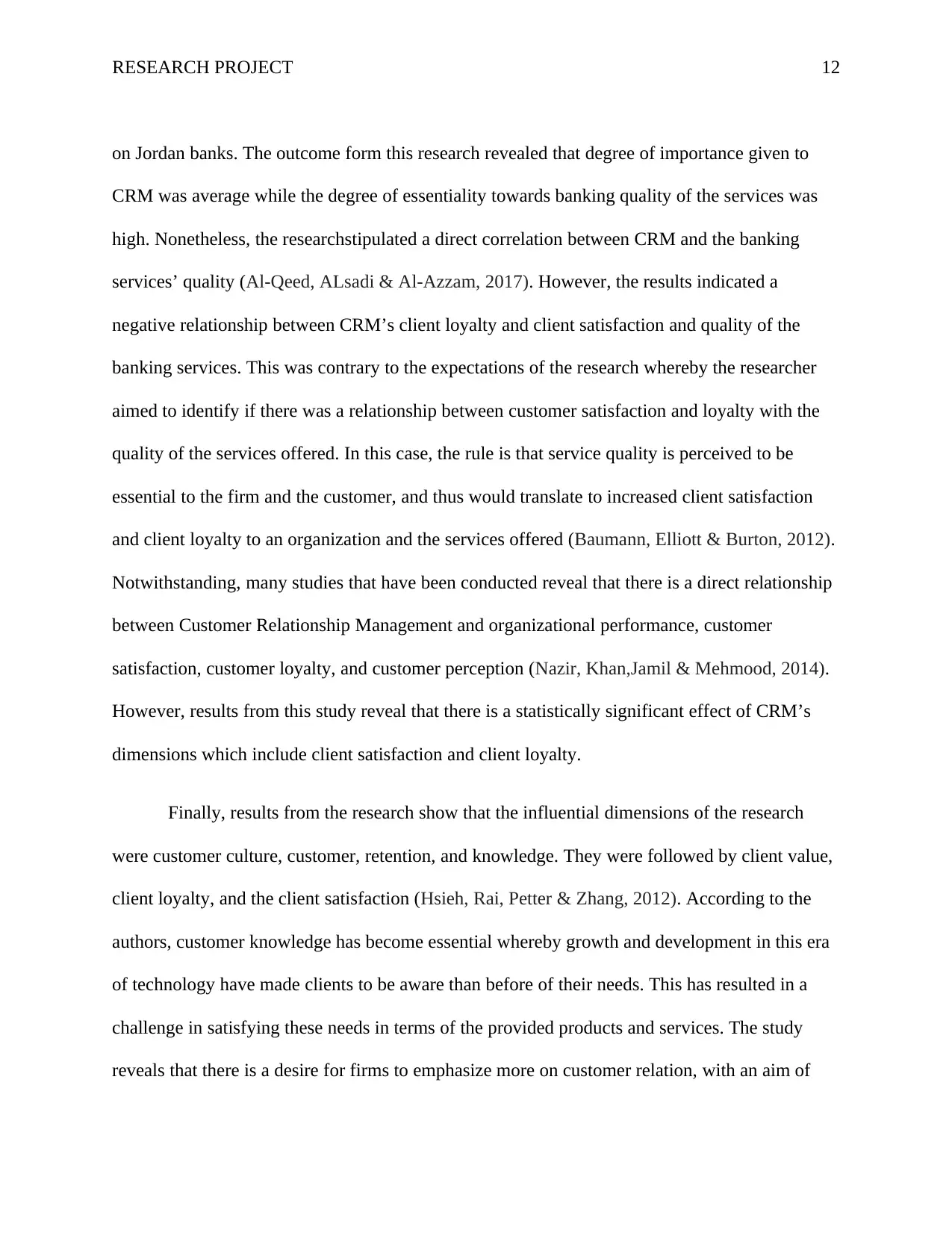
RESEARCH PROJECT 12
on Jordan banks. The outcome form this research revealed that degree of importance given to
CRM was average while the degree of essentiality towards banking quality of the services was
high. Nonetheless, the researchstipulated a direct correlation between CRM and the banking
services’ quality (Al-Qeed, ALsadi & Al-Azzam, 2017). However, the results indicated a
negative relationship between CRM’s client loyalty and client satisfaction and quality of the
banking services. This was contrary to the expectations of the research whereby the researcher
aimed to identify if there was a relationship between customer satisfaction and loyalty with the
quality of the services offered. In this case, the rule is that service quality is perceived to be
essential to the firm and the customer, and thus would translate to increased client satisfaction
and client loyalty to an organization and the services offered (Baumann, Elliott & Burton, 2012).
Notwithstanding, many studies that have been conducted reveal that there is a direct relationship
between Customer Relationship Management and organizational performance, customer
satisfaction, customer loyalty, and customer perception (Nazir, Khan,Jamil & Mehmood, 2014).
However, results from this study reveal that there is a statistically significant effect of CRM’s
dimensions which include client satisfaction and client loyalty.
Finally, results from the research show that the influential dimensions of the research
were customer culture, customer, retention, and knowledge. They were followed by client value,
client loyalty, and the client satisfaction (Hsieh, Rai, Petter & Zhang, 2012). According to the
authors, customer knowledge has become essential whereby growth and development in this era
of technology have made clients to be aware than before of their needs. This has resulted in a
challenge in satisfying these needs in terms of the provided products and services. The study
reveals that there is a desire for firms to emphasize more on customer relation, with an aim of
on Jordan banks. The outcome form this research revealed that degree of importance given to
CRM was average while the degree of essentiality towards banking quality of the services was
high. Nonetheless, the researchstipulated a direct correlation between CRM and the banking
services’ quality (Al-Qeed, ALsadi & Al-Azzam, 2017). However, the results indicated a
negative relationship between CRM’s client loyalty and client satisfaction and quality of the
banking services. This was contrary to the expectations of the research whereby the researcher
aimed to identify if there was a relationship between customer satisfaction and loyalty with the
quality of the services offered. In this case, the rule is that service quality is perceived to be
essential to the firm and the customer, and thus would translate to increased client satisfaction
and client loyalty to an organization and the services offered (Baumann, Elliott & Burton, 2012).
Notwithstanding, many studies that have been conducted reveal that there is a direct relationship
between Customer Relationship Management and organizational performance, customer
satisfaction, customer loyalty, and customer perception (Nazir, Khan,Jamil & Mehmood, 2014).
However, results from this study reveal that there is a statistically significant effect of CRM’s
dimensions which include client satisfaction and client loyalty.
Finally, results from the research show that the influential dimensions of the research
were customer culture, customer, retention, and knowledge. They were followed by client value,
client loyalty, and the client satisfaction (Hsieh, Rai, Petter & Zhang, 2012). According to the
authors, customer knowledge has become essential whereby growth and development in this era
of technology have made clients to be aware than before of their needs. This has resulted in a
challenge in satisfying these needs in terms of the provided products and services. The study
reveals that there is a desire for firms to emphasize more on customer relation, with an aim of
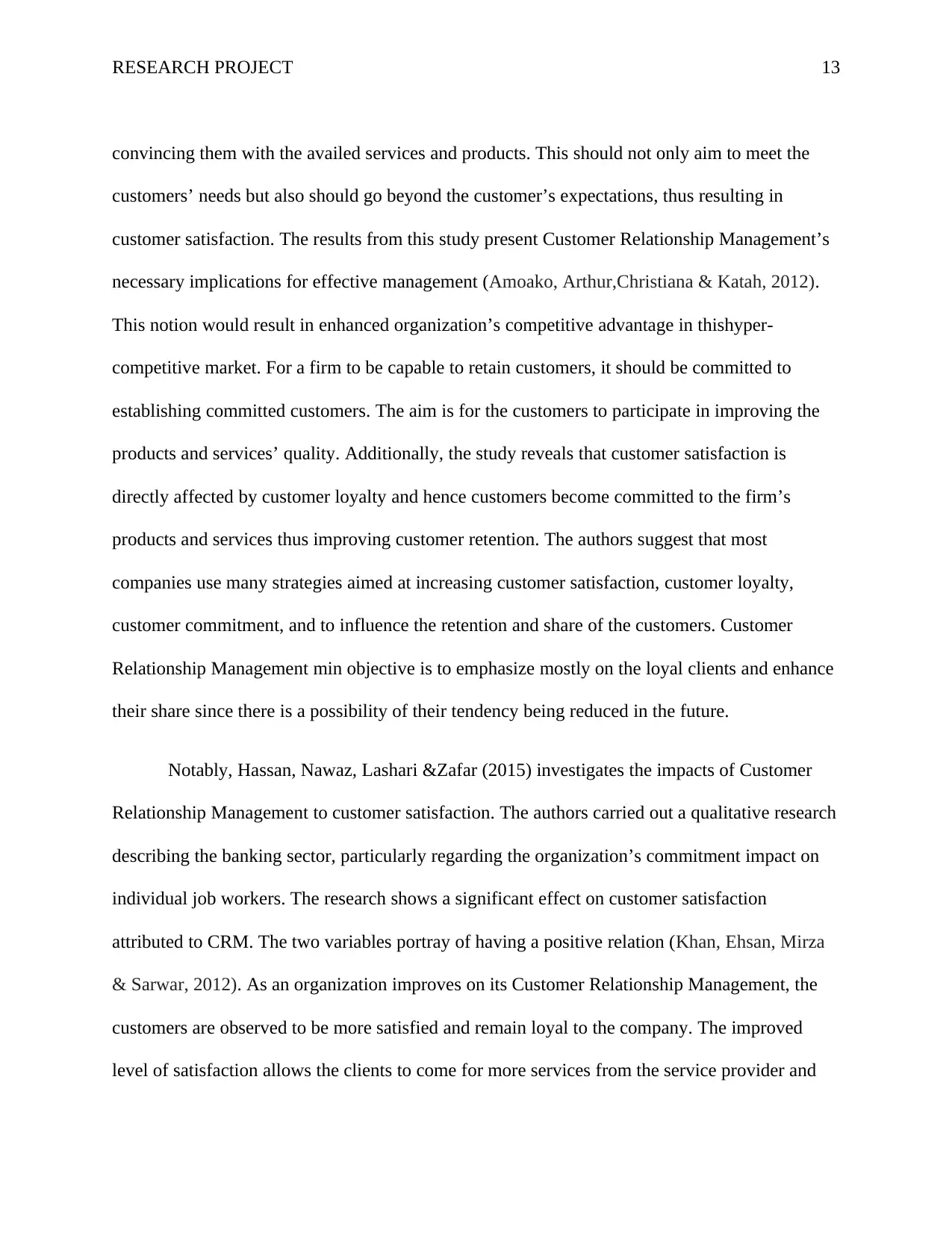
RESEARCH PROJECT 13
convincing them with the availed services and products. This should not only aim to meet the
customers’ needs but also should go beyond the customer’s expectations, thus resulting in
customer satisfaction. The results from this study present Customer Relationship Management’s
necessary implications for effective management (Amoako, Arthur,Christiana & Katah, 2012).
This notion would result in enhanced organization’s competitive advantage in thishyper-
competitive market. For a firm to be capable to retain customers, it should be committed to
establishing committed customers. The aim is for the customers to participate in improving the
products and services’ quality. Additionally, the study reveals that customer satisfaction is
directly affected by customer loyalty and hence customers become committed to the firm’s
products and services thus improving customer retention. The authors suggest that most
companies use many strategies aimed at increasing customer satisfaction, customer loyalty,
customer commitment, and to influence the retention and share of the customers. Customer
Relationship Management min objective is to emphasize mostly on the loyal clients and enhance
their share since there is a possibility of their tendency being reduced in the future.
Notably, Hassan, Nawaz, Lashari &Zafar (2015) investigates the impacts of Customer
Relationship Management to customer satisfaction. The authors carried out a qualitative research
describing the banking sector, particularly regarding the organization’s commitment impact on
individual job workers. The research shows a significant effect on customer satisfaction
attributed to CRM. The two variables portray of having a positive relation (Khan, Ehsan, Mirza
& Sarwar, 2012). As an organization improves on its Customer Relationship Management, the
customers are observed to be more satisfied and remain loyal to the company. The improved
level of satisfaction allows the clients to come for more services from the service provider and
convincing them with the availed services and products. This should not only aim to meet the
customers’ needs but also should go beyond the customer’s expectations, thus resulting in
customer satisfaction. The results from this study present Customer Relationship Management’s
necessary implications for effective management (Amoako, Arthur,Christiana & Katah, 2012).
This notion would result in enhanced organization’s competitive advantage in thishyper-
competitive market. For a firm to be capable to retain customers, it should be committed to
establishing committed customers. The aim is for the customers to participate in improving the
products and services’ quality. Additionally, the study reveals that customer satisfaction is
directly affected by customer loyalty and hence customers become committed to the firm’s
products and services thus improving customer retention. The authors suggest that most
companies use many strategies aimed at increasing customer satisfaction, customer loyalty,
customer commitment, and to influence the retention and share of the customers. Customer
Relationship Management min objective is to emphasize mostly on the loyal clients and enhance
their share since there is a possibility of their tendency being reduced in the future.
Notably, Hassan, Nawaz, Lashari &Zafar (2015) investigates the impacts of Customer
Relationship Management to customer satisfaction. The authors carried out a qualitative research
describing the banking sector, particularly regarding the organization’s commitment impact on
individual job workers. The research shows a significant effect on customer satisfaction
attributed to CRM. The two variables portray of having a positive relation (Khan, Ehsan, Mirza
& Sarwar, 2012). As an organization improves on its Customer Relationship Management, the
customers are observed to be more satisfied and remain loyal to the company. The improved
level of satisfaction allows the clients to come for more services from the service provider and
Paraphrase This Document
Need a fresh take? Get an instant paraphrase of this document with our AI Paraphraser
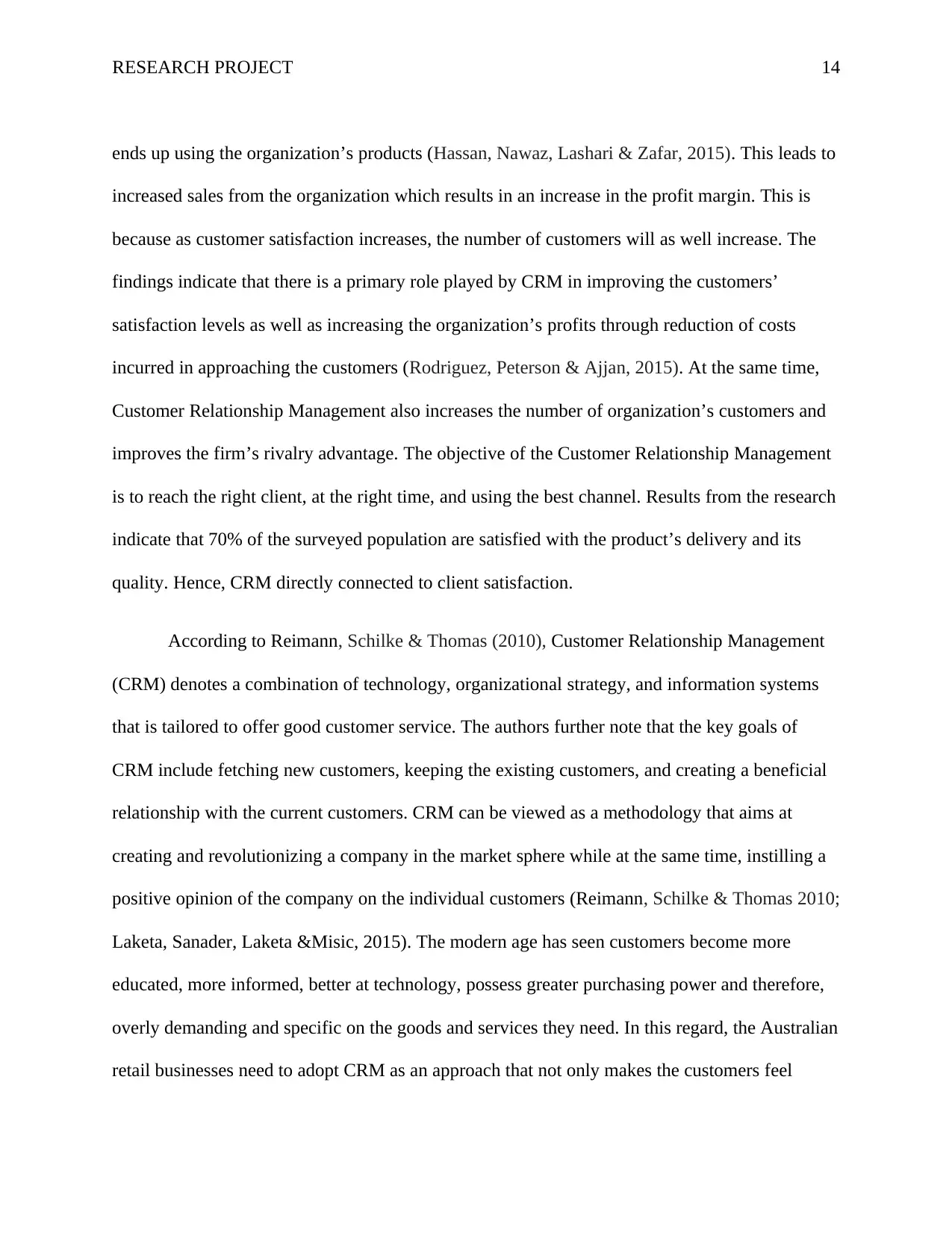
RESEARCH PROJECT 14
ends up using the organization’s products (Hassan, Nawaz, Lashari & Zafar, 2015). This leads to
increased sales from the organization which results in an increase in the profit margin. This is
because as customer satisfaction increases, the number of customers will as well increase. The
findings indicate that there is a primary role played by CRM in improving the customers’
satisfaction levels as well as increasing the organization’s profits through reduction of costs
incurred in approaching the customers (Rodriguez, Peterson & Ajjan, 2015). At the same time,
Customer Relationship Management also increases the number of organization’s customers and
improves the firm’s rivalry advantage. The objective of the Customer Relationship Management
is to reach the right client, at the right time, and using the best channel. Results from the research
indicate that 70% of the surveyed population are satisfied with the product’s delivery and its
quality. Hence, CRM directly connected to client satisfaction.
According to Reimann, Schilke & Thomas (2010), Customer Relationship Management
(CRM) denotes a combination of technology, organizational strategy, and information systems
that is tailored to offer good customer service. The authors further note that the key goals of
CRM include fetching new customers, keeping the existing customers, and creating a beneficial
relationship with the current customers. CRM can be viewed as a methodology that aims at
creating and revolutionizing a company in the market sphere while at the same time, instilling a
positive opinion of the company on the individual customers (Reimann, Schilke & Thomas 2010;
Laketa, Sanader, Laketa &Misic, 2015). The modern age has seen customers become more
educated, more informed, better at technology, possess greater purchasing power and therefore,
overly demanding and specific on the goods and services they need. In this regard, the Australian
retail businesses need to adopt CRM as an approach that not only makes the customers feel
ends up using the organization’s products (Hassan, Nawaz, Lashari & Zafar, 2015). This leads to
increased sales from the organization which results in an increase in the profit margin. This is
because as customer satisfaction increases, the number of customers will as well increase. The
findings indicate that there is a primary role played by CRM in improving the customers’
satisfaction levels as well as increasing the organization’s profits through reduction of costs
incurred in approaching the customers (Rodriguez, Peterson & Ajjan, 2015). At the same time,
Customer Relationship Management also increases the number of organization’s customers and
improves the firm’s rivalry advantage. The objective of the Customer Relationship Management
is to reach the right client, at the right time, and using the best channel. Results from the research
indicate that 70% of the surveyed population are satisfied with the product’s delivery and its
quality. Hence, CRM directly connected to client satisfaction.
According to Reimann, Schilke & Thomas (2010), Customer Relationship Management
(CRM) denotes a combination of technology, organizational strategy, and information systems
that is tailored to offer good customer service. The authors further note that the key goals of
CRM include fetching new customers, keeping the existing customers, and creating a beneficial
relationship with the current customers. CRM can be viewed as a methodology that aims at
creating and revolutionizing a company in the market sphere while at the same time, instilling a
positive opinion of the company on the individual customers (Reimann, Schilke & Thomas 2010;
Laketa, Sanader, Laketa &Misic, 2015). The modern age has seen customers become more
educated, more informed, better at technology, possess greater purchasing power and therefore,
overly demanding and specific on the goods and services they need. In this regard, the Australian
retail businesses need to adopt CRM as an approach that not only makes the customers feel
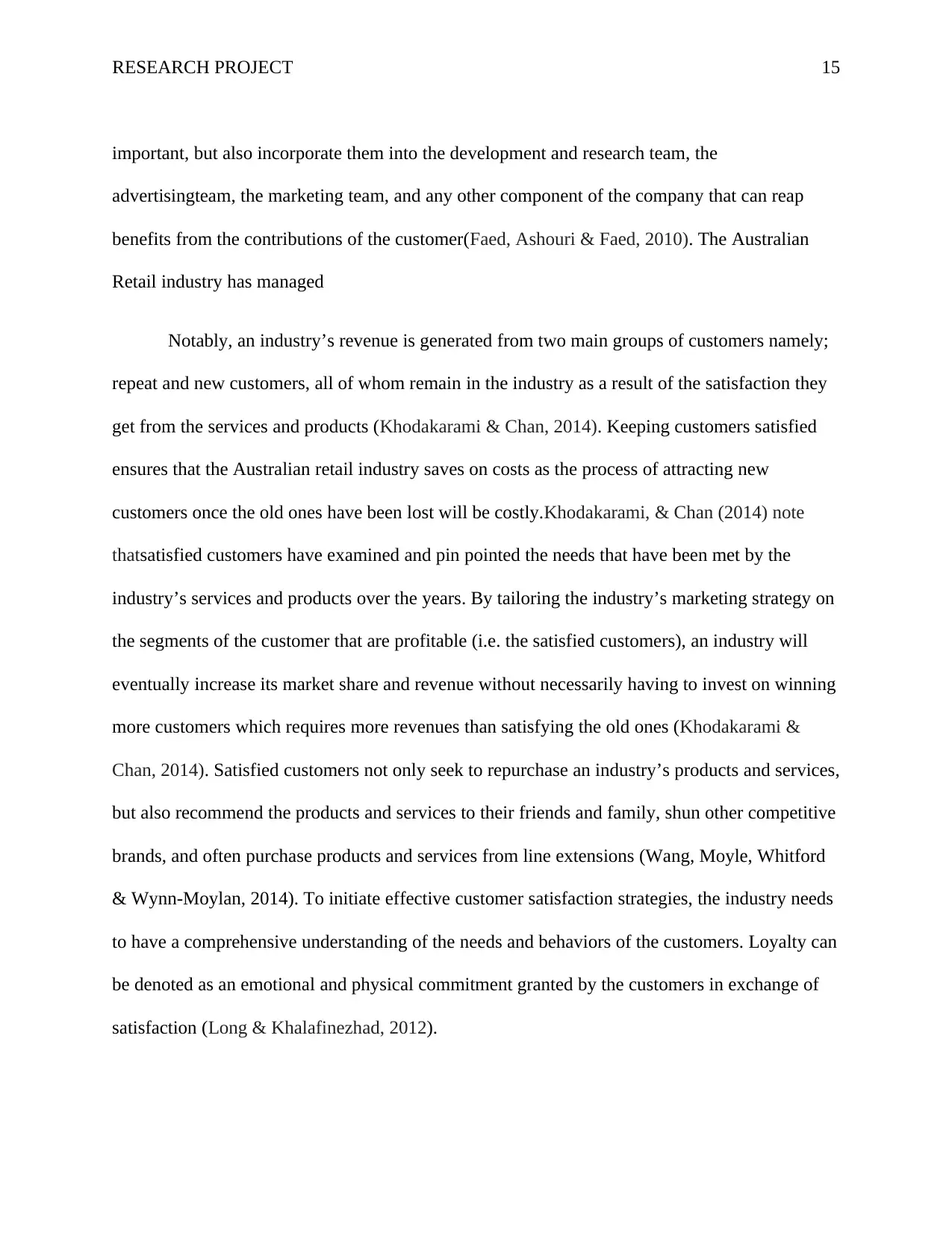
RESEARCH PROJECT 15
important, but also incorporate them into the development and research team, the
advertisingteam, the marketing team, and any other component of the company that can reap
benefits from the contributions of the customer(Faed, Ashouri & Faed, 2010). The Australian
Retail industry has managed
Notably, an industry’s revenue is generated from two main groups of customers namely;
repeat and new customers, all of whom remain in the industry as a result of the satisfaction they
get from the services and products (Khodakarami & Chan, 2014). Keeping customers satisfied
ensures that the Australian retail industry saves on costs as the process of attracting new
customers once the old ones have been lost will be costly.Khodakarami, & Chan (2014) note
thatsatisfied customers have examined and pin pointed the needs that have been met by the
industry’s services and products over the years. By tailoring the industry’s marketing strategy on
the segments of the customer that are profitable (i.e. the satisfied customers), an industry will
eventually increase its market share and revenue without necessarily having to invest on winning
more customers which requires more revenues than satisfying the old ones (Khodakarami &
Chan, 2014). Satisfied customers not only seek to repurchase an industry’s products and services,
but also recommend the products and services to their friends and family, shun other competitive
brands, and often purchase products and services from line extensions (Wang, Moyle, Whitford
& Wynn-Moylan, 2014). To initiate effective customer satisfaction strategies, the industry needs
to have a comprehensive understanding of the needs and behaviors of the customers. Loyalty can
be denoted as an emotional and physical commitment granted by the customers in exchange of
satisfaction (Long & Khalafinezhad, 2012).
important, but also incorporate them into the development and research team, the
advertisingteam, the marketing team, and any other component of the company that can reap
benefits from the contributions of the customer(Faed, Ashouri & Faed, 2010). The Australian
Retail industry has managed
Notably, an industry’s revenue is generated from two main groups of customers namely;
repeat and new customers, all of whom remain in the industry as a result of the satisfaction they
get from the services and products (Khodakarami & Chan, 2014). Keeping customers satisfied
ensures that the Australian retail industry saves on costs as the process of attracting new
customers once the old ones have been lost will be costly.Khodakarami, & Chan (2014) note
thatsatisfied customers have examined and pin pointed the needs that have been met by the
industry’s services and products over the years. By tailoring the industry’s marketing strategy on
the segments of the customer that are profitable (i.e. the satisfied customers), an industry will
eventually increase its market share and revenue without necessarily having to invest on winning
more customers which requires more revenues than satisfying the old ones (Khodakarami &
Chan, 2014). Satisfied customers not only seek to repurchase an industry’s products and services,
but also recommend the products and services to their friends and family, shun other competitive
brands, and often purchase products and services from line extensions (Wang, Moyle, Whitford
& Wynn-Moylan, 2014). To initiate effective customer satisfaction strategies, the industry needs
to have a comprehensive understanding of the needs and behaviors of the customers. Loyalty can
be denoted as an emotional and physical commitment granted by the customers in exchange of
satisfaction (Long & Khalafinezhad, 2012).
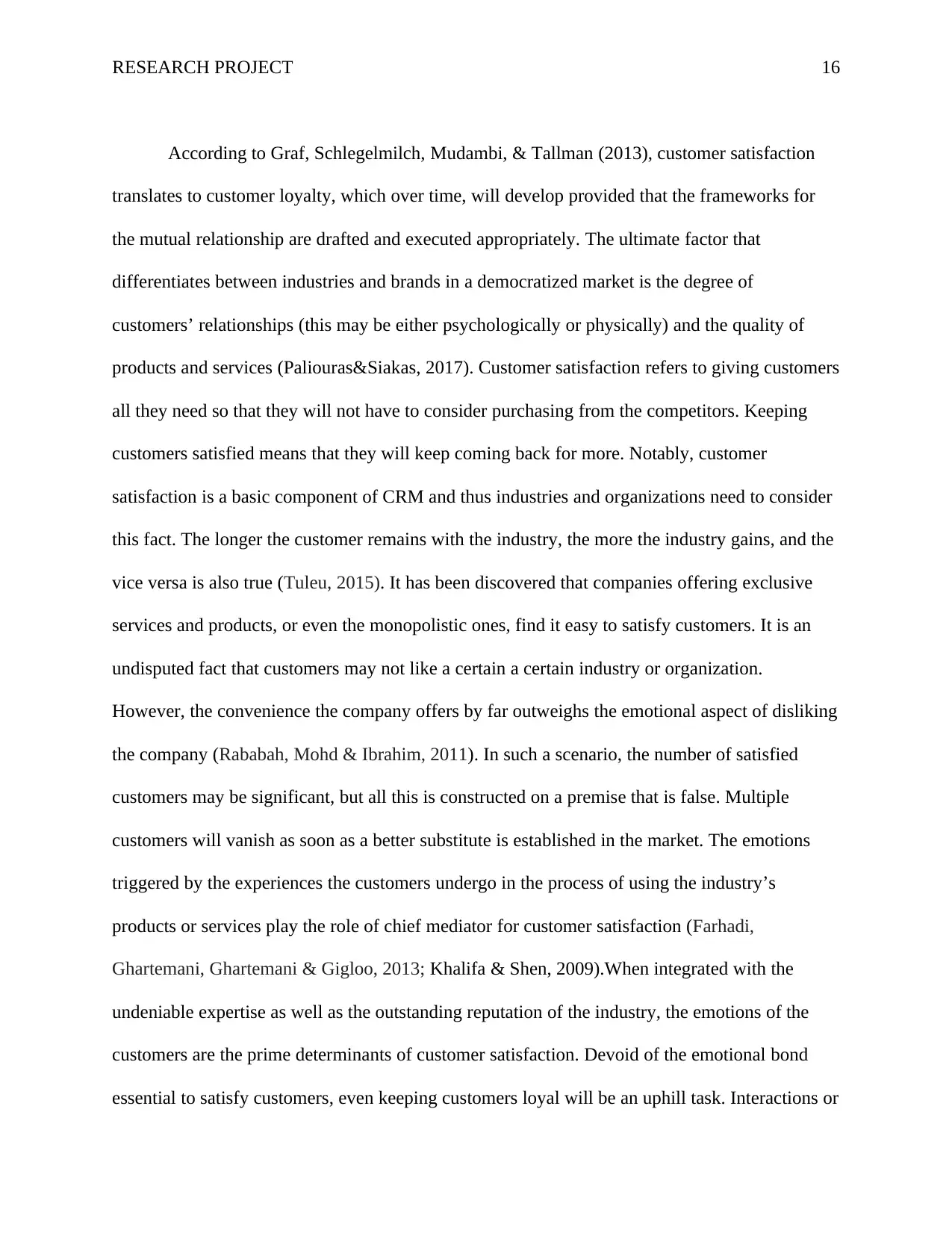
RESEARCH PROJECT 16
According to Graf, Schlegelmilch, Mudambi, & Tallman (2013), customer satisfaction
translates to customer loyalty, which over time, will develop provided that the frameworks for
the mutual relationship are drafted and executed appropriately. The ultimate factor that
differentiates between industries and brands in a democratized market is the degree of
customers’ relationships (this may be either psychologically or physically) and the quality of
products and services (Paliouras&Siakas, 2017). Customer satisfaction refers to giving customers
all they need so that they will not have to consider purchasing from the competitors. Keeping
customers satisfied means that they will keep coming back for more. Notably, customer
satisfaction is a basic component of CRM and thus industries and organizations need to consider
this fact. The longer the customer remains with the industry, the more the industry gains, and the
vice versa is also true (Tuleu, 2015). It has been discovered that companies offering exclusive
services and products, or even the monopolistic ones, find it easy to satisfy customers. It is an
undisputed fact that customers may not like a certain a certain industry or organization.
However, the convenience the company offers by far outweighs the emotional aspect of disliking
the company (Rababah, Mohd & Ibrahim, 2011). In such a scenario, the number of satisfied
customers may be significant, but all this is constructed on a premise that is false. Multiple
customers will vanish as soon as a better substitute is established in the market. The emotions
triggered by the experiences the customers undergo in the process of using the industry’s
products or services play the role of chief mediator for customer satisfaction (Farhadi,
Ghartemani, Ghartemani & Gigloo, 2013; Khalifa & Shen, 2009).When integrated with the
undeniable expertise as well as the outstanding reputation of the industry, the emotions of the
customers are the prime determinants of customer satisfaction. Devoid of the emotional bond
essential to satisfy customers, even keeping customers loyal will be an uphill task. Interactions or
According to Graf, Schlegelmilch, Mudambi, & Tallman (2013), customer satisfaction
translates to customer loyalty, which over time, will develop provided that the frameworks for
the mutual relationship are drafted and executed appropriately. The ultimate factor that
differentiates between industries and brands in a democratized market is the degree of
customers’ relationships (this may be either psychologically or physically) and the quality of
products and services (Paliouras&Siakas, 2017). Customer satisfaction refers to giving customers
all they need so that they will not have to consider purchasing from the competitors. Keeping
customers satisfied means that they will keep coming back for more. Notably, customer
satisfaction is a basic component of CRM and thus industries and organizations need to consider
this fact. The longer the customer remains with the industry, the more the industry gains, and the
vice versa is also true (Tuleu, 2015). It has been discovered that companies offering exclusive
services and products, or even the monopolistic ones, find it easy to satisfy customers. It is an
undisputed fact that customers may not like a certain a certain industry or organization.
However, the convenience the company offers by far outweighs the emotional aspect of disliking
the company (Rababah, Mohd & Ibrahim, 2011). In such a scenario, the number of satisfied
customers may be significant, but all this is constructed on a premise that is false. Multiple
customers will vanish as soon as a better substitute is established in the market. The emotions
triggered by the experiences the customers undergo in the process of using the industry’s
products or services play the role of chief mediator for customer satisfaction (Farhadi,
Ghartemani, Ghartemani & Gigloo, 2013; Khalifa & Shen, 2009).When integrated with the
undeniable expertise as well as the outstanding reputation of the industry, the emotions of the
customers are the prime determinants of customer satisfaction. Devoid of the emotional bond
essential to satisfy customers, even keeping customers loyal will be an uphill task. Interactions or
Secure Best Marks with AI Grader
Need help grading? Try our AI Grader for instant feedback on your assignments.
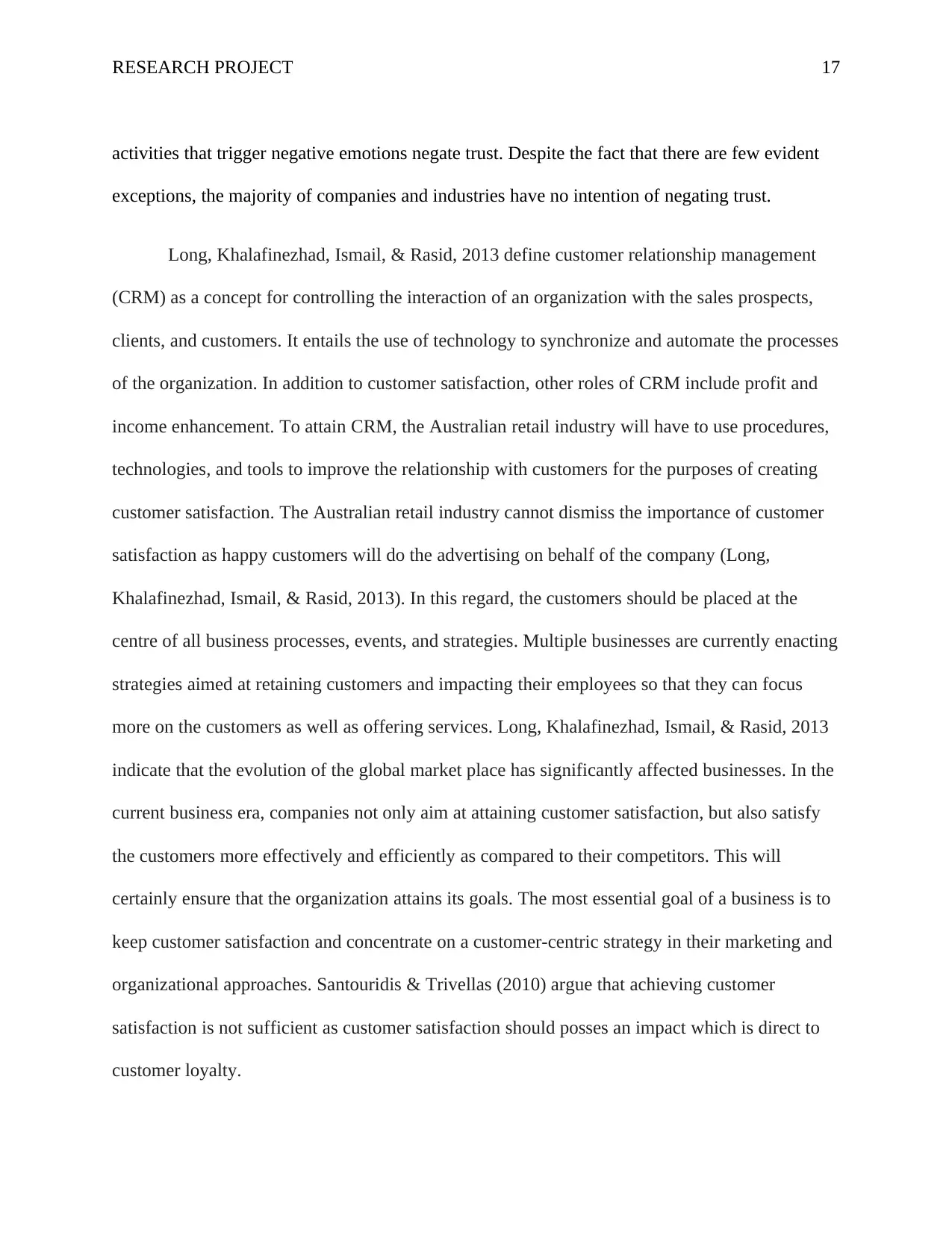
RESEARCH PROJECT 17
activities that trigger negative emotions negate trust. Despite the fact that there are few evident
exceptions, the majority of companies and industries have no intention of negating trust.
Long, Khalafinezhad, Ismail, & Rasid, 2013 define customer relationship management
(CRM) as a concept for controlling the interaction of an organization with the sales prospects,
clients, and customers. It entails the use of technology to synchronize and automate the processes
of the organization. In addition to customer satisfaction, other roles of CRM include profit and
income enhancement. To attain CRM, the Australian retail industry will have to use procedures,
technologies, and tools to improve the relationship with customers for the purposes of creating
customer satisfaction. The Australian retail industry cannot dismiss the importance of customer
satisfaction as happy customers will do the advertising on behalf of the company (Long,
Khalafinezhad, Ismail, & Rasid, 2013). In this regard, the customers should be placed at the
centre of all business processes, events, and strategies. Multiple businesses are currently enacting
strategies aimed at retaining customers and impacting their employees so that they can focus
more on the customers as well as offering services. Long, Khalafinezhad, Ismail, & Rasid, 2013
indicate that the evolution of the global market place has significantly affected businesses. In the
current business era, companies not only aim at attaining customer satisfaction, but also satisfy
the customers more effectively and efficiently as compared to their competitors. This will
certainly ensure that the organization attains its goals. The most essential goal of a business is to
keep customer satisfaction and concentrate on a customer-centric strategy in their marketing and
organizational approaches. Santouridis & Trivellas (2010) argue that achieving customer
satisfaction is not sufficient as customer satisfaction should posses an impact which is direct to
customer loyalty.
activities that trigger negative emotions negate trust. Despite the fact that there are few evident
exceptions, the majority of companies and industries have no intention of negating trust.
Long, Khalafinezhad, Ismail, & Rasid, 2013 define customer relationship management
(CRM) as a concept for controlling the interaction of an organization with the sales prospects,
clients, and customers. It entails the use of technology to synchronize and automate the processes
of the organization. In addition to customer satisfaction, other roles of CRM include profit and
income enhancement. To attain CRM, the Australian retail industry will have to use procedures,
technologies, and tools to improve the relationship with customers for the purposes of creating
customer satisfaction. The Australian retail industry cannot dismiss the importance of customer
satisfaction as happy customers will do the advertising on behalf of the company (Long,
Khalafinezhad, Ismail, & Rasid, 2013). In this regard, the customers should be placed at the
centre of all business processes, events, and strategies. Multiple businesses are currently enacting
strategies aimed at retaining customers and impacting their employees so that they can focus
more on the customers as well as offering services. Long, Khalafinezhad, Ismail, & Rasid, 2013
indicate that the evolution of the global market place has significantly affected businesses. In the
current business era, companies not only aim at attaining customer satisfaction, but also satisfy
the customers more effectively and efficiently as compared to their competitors. This will
certainly ensure that the organization attains its goals. The most essential goal of a business is to
keep customer satisfaction and concentrate on a customer-centric strategy in their marketing and
organizational approaches. Santouridis & Trivellas (2010) argue that achieving customer
satisfaction is not sufficient as customer satisfaction should posses an impact which is direct to
customer loyalty.
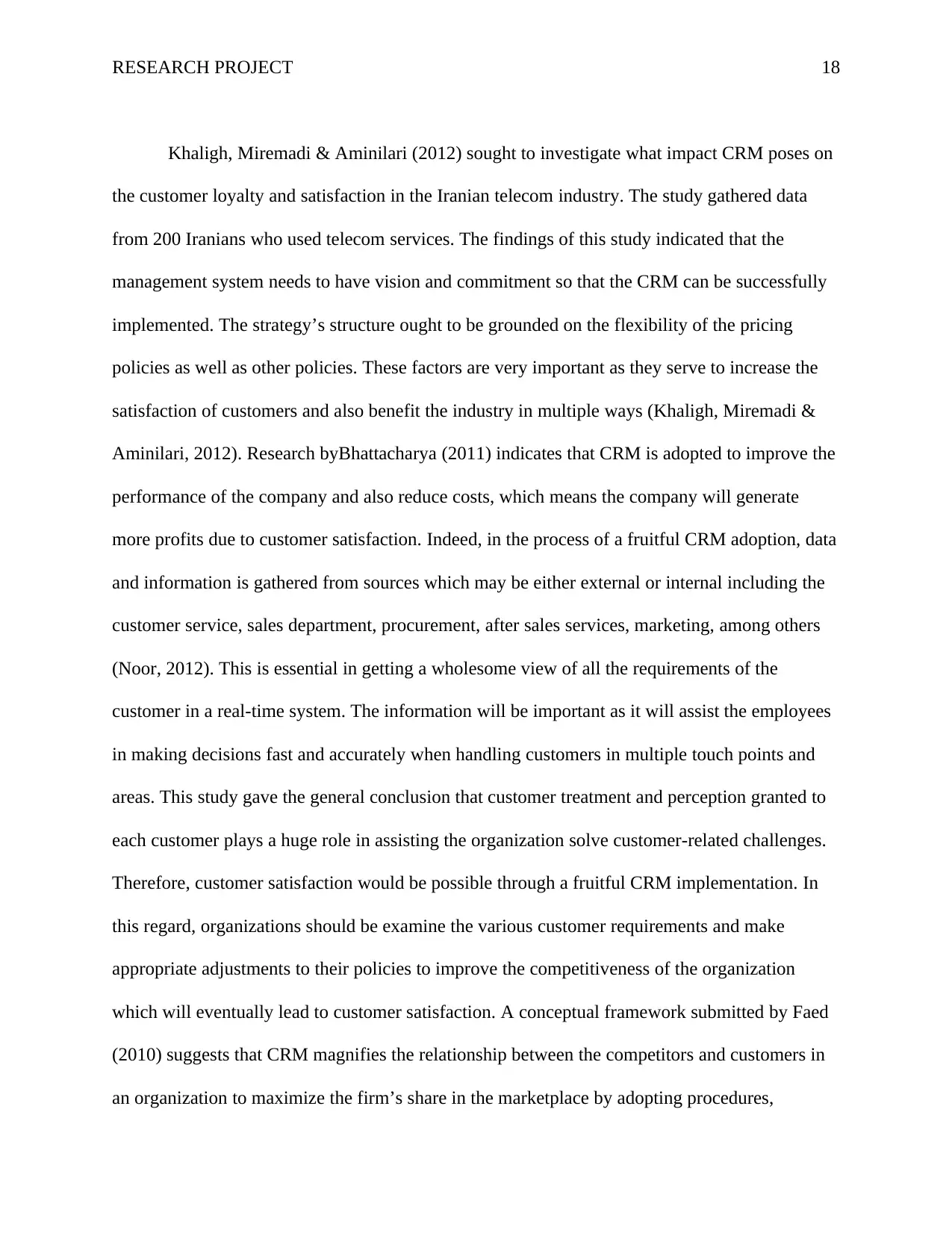
RESEARCH PROJECT 18
Khaligh, Miremadi & Aminilari (2012) sought to investigate what impact CRM poses on
the customer loyalty and satisfaction in the Iranian telecom industry. The study gathered data
from 200 Iranians who used telecom services. The findings of this study indicated that the
management system needs to have vision and commitment so that the CRM can be successfully
implemented. The strategy’s structure ought to be grounded on the flexibility of the pricing
policies as well as other policies. These factors are very important as they serve to increase the
satisfaction of customers and also benefit the industry in multiple ways (Khaligh, Miremadi &
Aminilari, 2012). Research byBhattacharya (2011) indicates that CRM is adopted to improve the
performance of the company and also reduce costs, which means the company will generate
more profits due to customer satisfaction. Indeed, in the process of a fruitful CRM adoption, data
and information is gathered from sources which may be either external or internal including the
customer service, sales department, procurement, after sales services, marketing, among others
(Noor, 2012). This is essential in getting a wholesome view of all the requirements of the
customer in a real-time system. The information will be important as it will assist the employees
in making decisions fast and accurately when handling customers in multiple touch points and
areas. This study gave the general conclusion that customer treatment and perception granted to
each customer plays a huge role in assisting the organization solve customer-related challenges.
Therefore, customer satisfaction would be possible through a fruitful CRM implementation. In
this regard, organizations should be examine the various customer requirements and make
appropriate adjustments to their policies to improve the competitiveness of the organization
which will eventually lead to customer satisfaction. A conceptual framework submitted by Faed
(2010) suggests that CRM magnifies the relationship between the competitors and customers in
an organization to maximize the firm’s share in the marketplace by adopting procedures,
Khaligh, Miremadi & Aminilari (2012) sought to investigate what impact CRM poses on
the customer loyalty and satisfaction in the Iranian telecom industry. The study gathered data
from 200 Iranians who used telecom services. The findings of this study indicated that the
management system needs to have vision and commitment so that the CRM can be successfully
implemented. The strategy’s structure ought to be grounded on the flexibility of the pricing
policies as well as other policies. These factors are very important as they serve to increase the
satisfaction of customers and also benefit the industry in multiple ways (Khaligh, Miremadi &
Aminilari, 2012). Research byBhattacharya (2011) indicates that CRM is adopted to improve the
performance of the company and also reduce costs, which means the company will generate
more profits due to customer satisfaction. Indeed, in the process of a fruitful CRM adoption, data
and information is gathered from sources which may be either external or internal including the
customer service, sales department, procurement, after sales services, marketing, among others
(Noor, 2012). This is essential in getting a wholesome view of all the requirements of the
customer in a real-time system. The information will be important as it will assist the employees
in making decisions fast and accurately when handling customers in multiple touch points and
areas. This study gave the general conclusion that customer treatment and perception granted to
each customer plays a huge role in assisting the organization solve customer-related challenges.
Therefore, customer satisfaction would be possible through a fruitful CRM implementation. In
this regard, organizations should be examine the various customer requirements and make
appropriate adjustments to their policies to improve the competitiveness of the organization
which will eventually lead to customer satisfaction. A conceptual framework submitted by Faed
(2010) suggests that CRM magnifies the relationship between the competitors and customers in
an organization to maximize the firm’s share in the marketplace by adopting procedures,
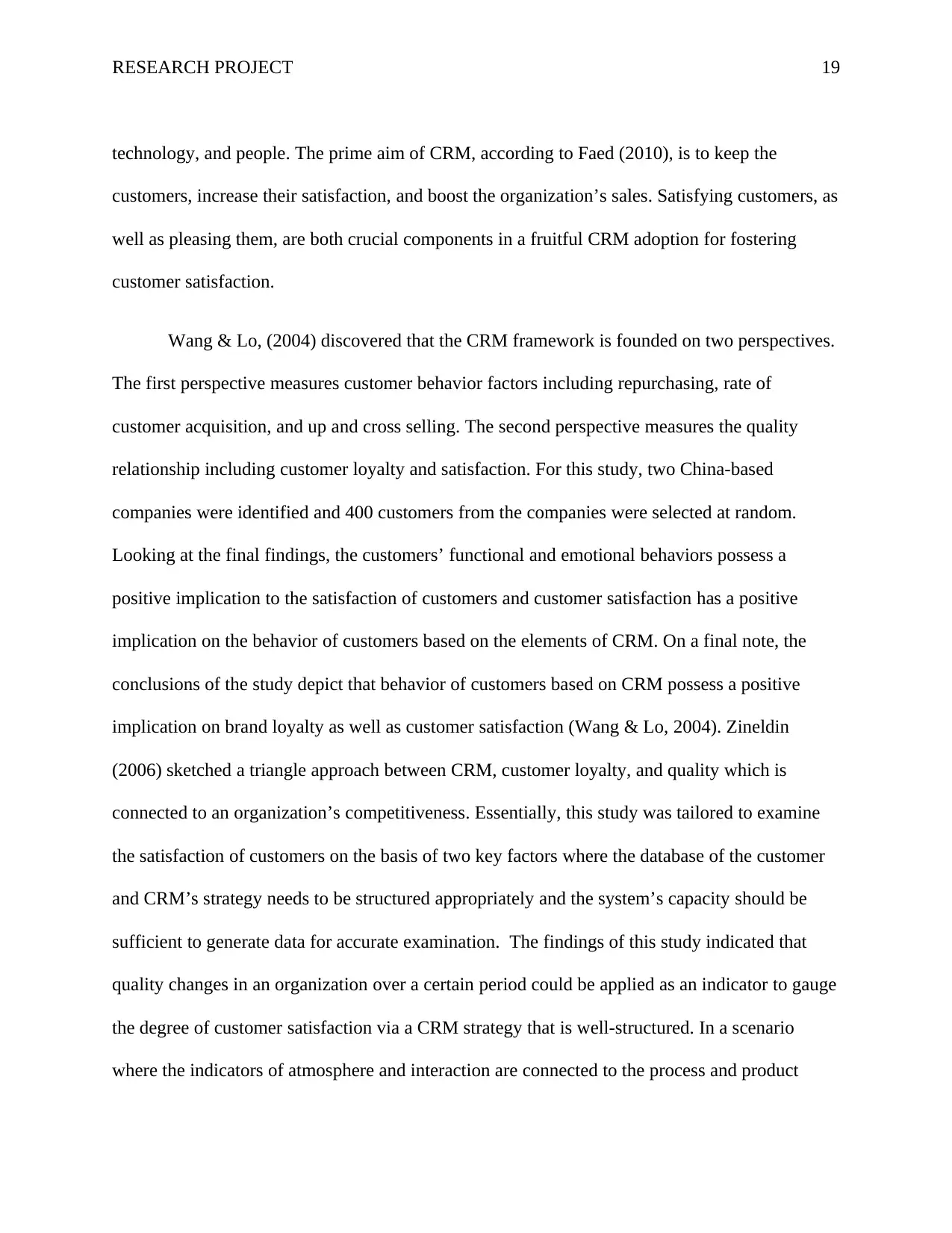
RESEARCH PROJECT 19
technology, and people. The prime aim of CRM, according to Faed (2010), is to keep the
customers, increase their satisfaction, and boost the organization’s sales. Satisfying customers, as
well as pleasing them, are both crucial components in a fruitful CRM adoption for fostering
customer satisfaction.
Wang & Lo, (2004) discovered that the CRM framework is founded on two perspectives.
The first perspective measures customer behavior factors including repurchasing, rate of
customer acquisition, and up and cross selling. The second perspective measures the quality
relationship including customer loyalty and satisfaction. For this study, two China-based
companies were identified and 400 customers from the companies were selected at random.
Looking at the final findings, the customers’ functional and emotional behaviors possess a
positive implication to the satisfaction of customers and customer satisfaction has a positive
implication on the behavior of customers based on the elements of CRM. On a final note, the
conclusions of the study depict that behavior of customers based on CRM possess a positive
implication on brand loyalty as well as customer satisfaction (Wang & Lo, 2004). Zineldin
(2006) sketched a triangle approach between CRM, customer loyalty, and quality which is
connected to an organization’s competitiveness. Essentially, this study was tailored to examine
the satisfaction of customers on the basis of two key factors where the database of the customer
and CRM’s strategy needs to be structured appropriately and the system’s capacity should be
sufficient to generate data for accurate examination. The findings of this study indicated that
quality changes in an organization over a certain period could be applied as an indicator to gauge
the degree of customer satisfaction via a CRM strategy that is well-structured. In a scenario
where the indicators of atmosphere and interaction are connected to the process and product
technology, and people. The prime aim of CRM, according to Faed (2010), is to keep the
customers, increase their satisfaction, and boost the organization’s sales. Satisfying customers, as
well as pleasing them, are both crucial components in a fruitful CRM adoption for fostering
customer satisfaction.
Wang & Lo, (2004) discovered that the CRM framework is founded on two perspectives.
The first perspective measures customer behavior factors including repurchasing, rate of
customer acquisition, and up and cross selling. The second perspective measures the quality
relationship including customer loyalty and satisfaction. For this study, two China-based
companies were identified and 400 customers from the companies were selected at random.
Looking at the final findings, the customers’ functional and emotional behaviors possess a
positive implication to the satisfaction of customers and customer satisfaction has a positive
implication on the behavior of customers based on the elements of CRM. On a final note, the
conclusions of the study depict that behavior of customers based on CRM possess a positive
implication on brand loyalty as well as customer satisfaction (Wang & Lo, 2004). Zineldin
(2006) sketched a triangle approach between CRM, customer loyalty, and quality which is
connected to an organization’s competitiveness. Essentially, this study was tailored to examine
the satisfaction of customers on the basis of two key factors where the database of the customer
and CRM’s strategy needs to be structured appropriately and the system’s capacity should be
sufficient to generate data for accurate examination. The findings of this study indicated that
quality changes in an organization over a certain period could be applied as an indicator to gauge
the degree of customer satisfaction via a CRM strategy that is well-structured. In a scenario
where the indicators of atmosphere and interaction are connected to the process and product
Paraphrase This Document
Need a fresh take? Get an instant paraphrase of this document with our AI Paraphraser
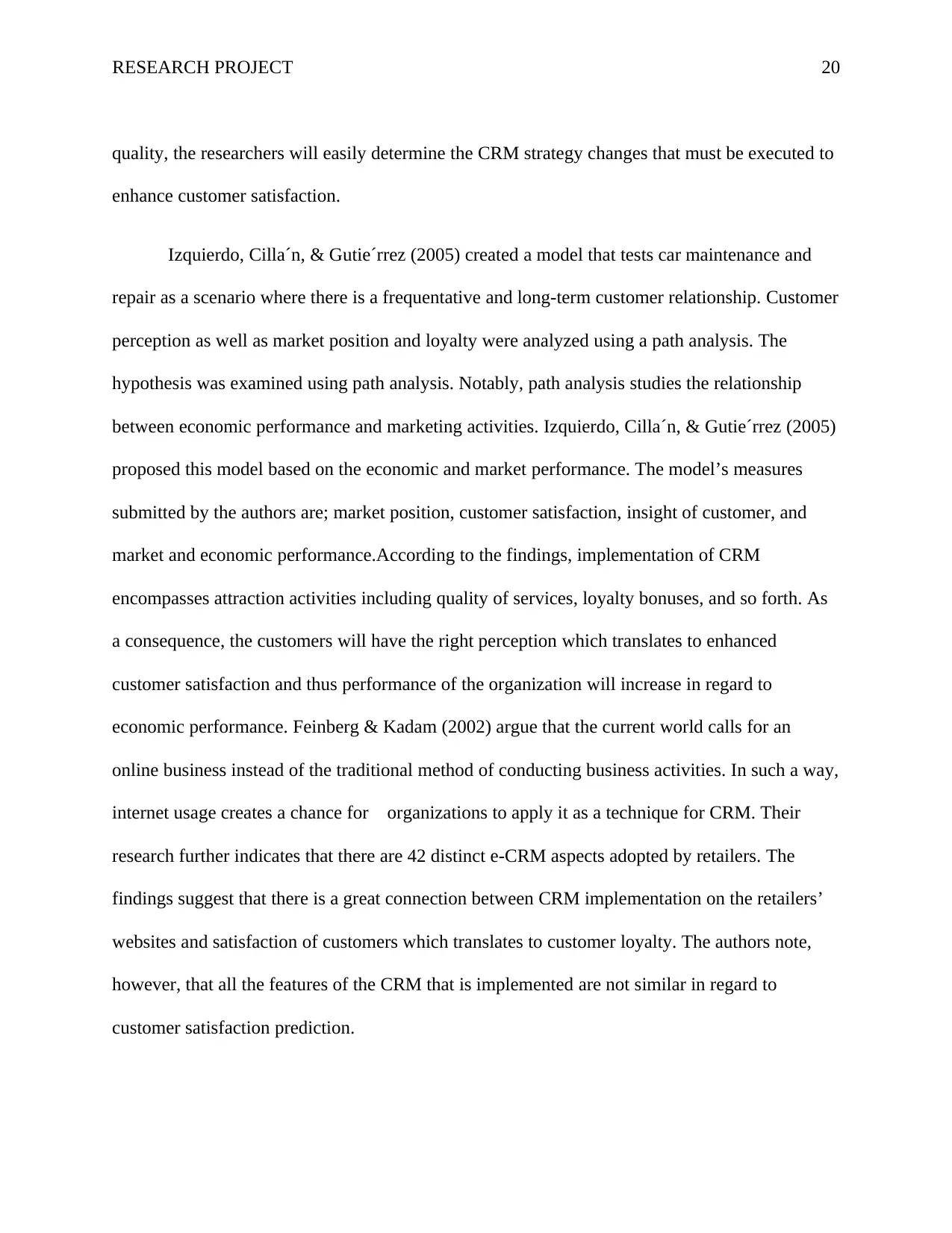
RESEARCH PROJECT 20
quality, the researchers will easily determine the CRM strategy changes that must be executed to
enhance customer satisfaction.
Izquierdo, Cilla´n, & Gutie´rrez (2005) created a model that tests car maintenance and
repair as a scenario where there is a frequentative and long-term customer relationship. Customer
perception as well as market position and loyalty were analyzed using a path analysis. The
hypothesis was examined using path analysis. Notably, path analysis studies the relationship
between economic performance and marketing activities. Izquierdo, Cilla´n, & Gutie´rrez (2005)
proposed this model based on the economic and market performance. The model’s measures
submitted by the authors are; market position, customer satisfaction, insight of customer, and
market and economic performance.According to the findings, implementation of CRM
encompasses attraction activities including quality of services, loyalty bonuses, and so forth. As
a consequence, the customers will have the right perception which translates to enhanced
customer satisfaction and thus performance of the organization will increase in regard to
economic performance. Feinberg & Kadam (2002) argue that the current world calls for an
online business instead of the traditional method of conducting business activities. In such a way,
internet usage creates a chance for organizations to apply it as a technique for CRM. Their
research further indicates that there are 42 distinct e-CRM aspects adopted by retailers. The
findings suggest that there is a great connection between CRM implementation on the retailers’
websites and satisfaction of customers which translates to customer loyalty. The authors note,
however, that all the features of the CRM that is implemented are not similar in regard to
customer satisfaction prediction.
quality, the researchers will easily determine the CRM strategy changes that must be executed to
enhance customer satisfaction.
Izquierdo, Cilla´n, & Gutie´rrez (2005) created a model that tests car maintenance and
repair as a scenario where there is a frequentative and long-term customer relationship. Customer
perception as well as market position and loyalty were analyzed using a path analysis. The
hypothesis was examined using path analysis. Notably, path analysis studies the relationship
between economic performance and marketing activities. Izquierdo, Cilla´n, & Gutie´rrez (2005)
proposed this model based on the economic and market performance. The model’s measures
submitted by the authors are; market position, customer satisfaction, insight of customer, and
market and economic performance.According to the findings, implementation of CRM
encompasses attraction activities including quality of services, loyalty bonuses, and so forth. As
a consequence, the customers will have the right perception which translates to enhanced
customer satisfaction and thus performance of the organization will increase in regard to
economic performance. Feinberg & Kadam (2002) argue that the current world calls for an
online business instead of the traditional method of conducting business activities. In such a way,
internet usage creates a chance for organizations to apply it as a technique for CRM. Their
research further indicates that there are 42 distinct e-CRM aspects adopted by retailers. The
findings suggest that there is a great connection between CRM implementation on the retailers’
websites and satisfaction of customers which translates to customer loyalty. The authors note,
however, that all the features of the CRM that is implemented are not similar in regard to
customer satisfaction prediction.
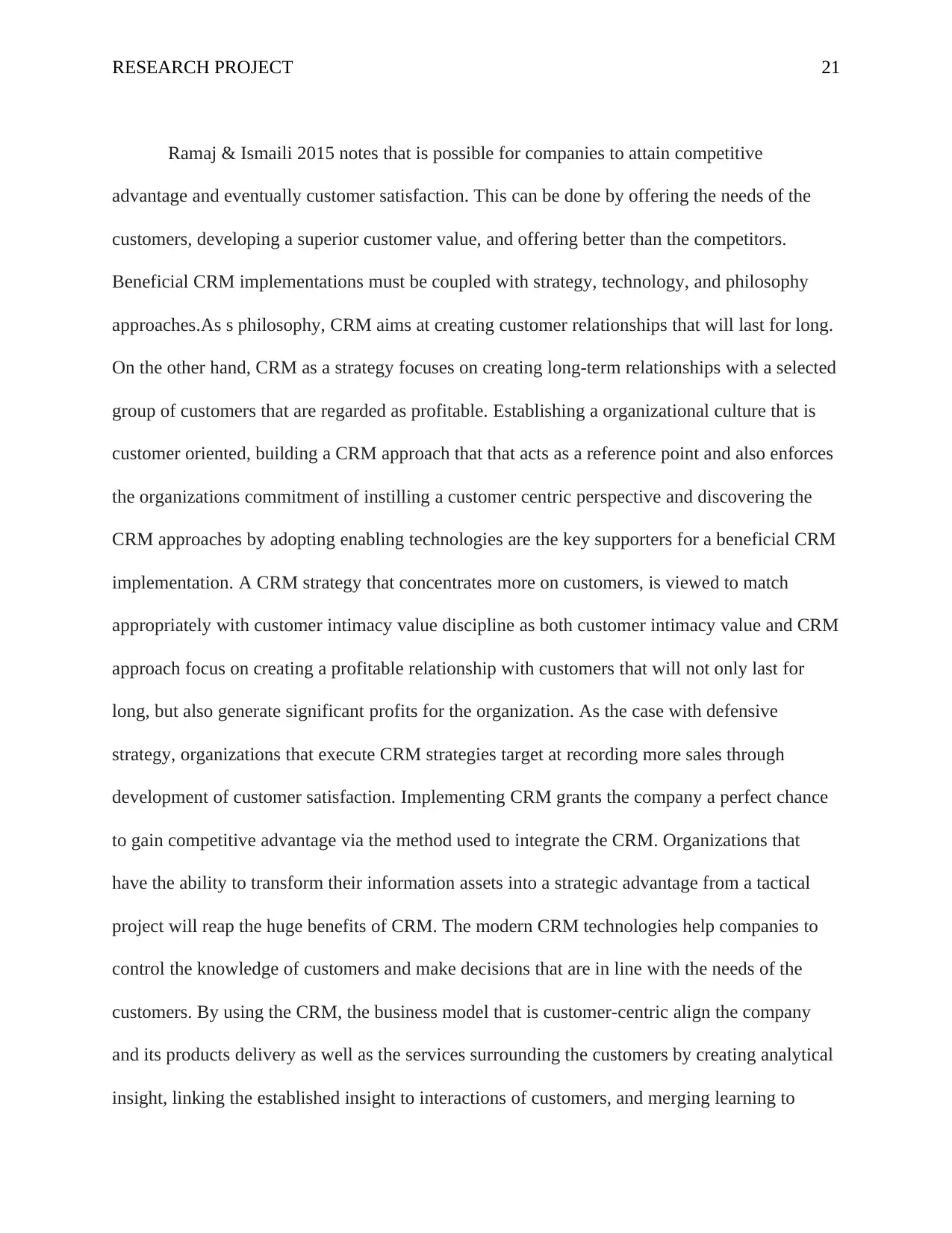
RESEARCH PROJECT 21
Ramaj & Ismaili 2015 notes that is possible for companies to attain competitive
advantage and eventually customer satisfaction. This can be done by offering the needs of the
customers, developing a superior customer value, and offering better than the competitors.
Beneficial CRM implementations must be coupled with strategy, technology, and philosophy
approaches.As s philosophy, CRM aims at creating customer relationships that will last for long.
On the other hand, CRM as a strategy focuses on creating long-term relationships with a selected
group of customers that are regarded as profitable. Establishing a organizational culture that is
customer oriented, building a CRM approach that that acts as a reference point and also enforces
the organizations commitment of instilling a customer centric perspective and discovering the
CRM approaches by adopting enabling technologies are the key supporters for a beneficial CRM
implementation. A CRM strategy that concentrates more on customers, is viewed to match
appropriately with customer intimacy value discipline as both customer intimacy value and CRM
approach focus on creating a profitable relationship with customers that will not only last for
long, but also generate significant profits for the organization. As the case with defensive
strategy, organizations that execute CRM strategies target at recording more sales through
development of customer satisfaction. Implementing CRM grants the company a perfect chance
to gain competitive advantage via the method used to integrate the CRM. Organizations that
have the ability to transform their information assets into a strategic advantage from a tactical
project will reap the huge benefits of CRM. The modern CRM technologies help companies to
control the knowledge of customers and make decisions that are in line with the needs of the
customers. By using the CRM, the business model that is customer-centric align the company
and its products delivery as well as the services surrounding the customers by creating analytical
insight, linking the established insight to interactions of customers, and merging learning to
Ramaj & Ismaili 2015 notes that is possible for companies to attain competitive
advantage and eventually customer satisfaction. This can be done by offering the needs of the
customers, developing a superior customer value, and offering better than the competitors.
Beneficial CRM implementations must be coupled with strategy, technology, and philosophy
approaches.As s philosophy, CRM aims at creating customer relationships that will last for long.
On the other hand, CRM as a strategy focuses on creating long-term relationships with a selected
group of customers that are regarded as profitable. Establishing a organizational culture that is
customer oriented, building a CRM approach that that acts as a reference point and also enforces
the organizations commitment of instilling a customer centric perspective and discovering the
CRM approaches by adopting enabling technologies are the key supporters for a beneficial CRM
implementation. A CRM strategy that concentrates more on customers, is viewed to match
appropriately with customer intimacy value discipline as both customer intimacy value and CRM
approach focus on creating a profitable relationship with customers that will not only last for
long, but also generate significant profits for the organization. As the case with defensive
strategy, organizations that execute CRM strategies target at recording more sales through
development of customer satisfaction. Implementing CRM grants the company a perfect chance
to gain competitive advantage via the method used to integrate the CRM. Organizations that
have the ability to transform their information assets into a strategic advantage from a tactical
project will reap the huge benefits of CRM. The modern CRM technologies help companies to
control the knowledge of customers and make decisions that are in line with the needs of the
customers. By using the CRM, the business model that is customer-centric align the company
and its products delivery as well as the services surrounding the customers by creating analytical
insight, linking the established insight to interactions of customers, and merging learning to
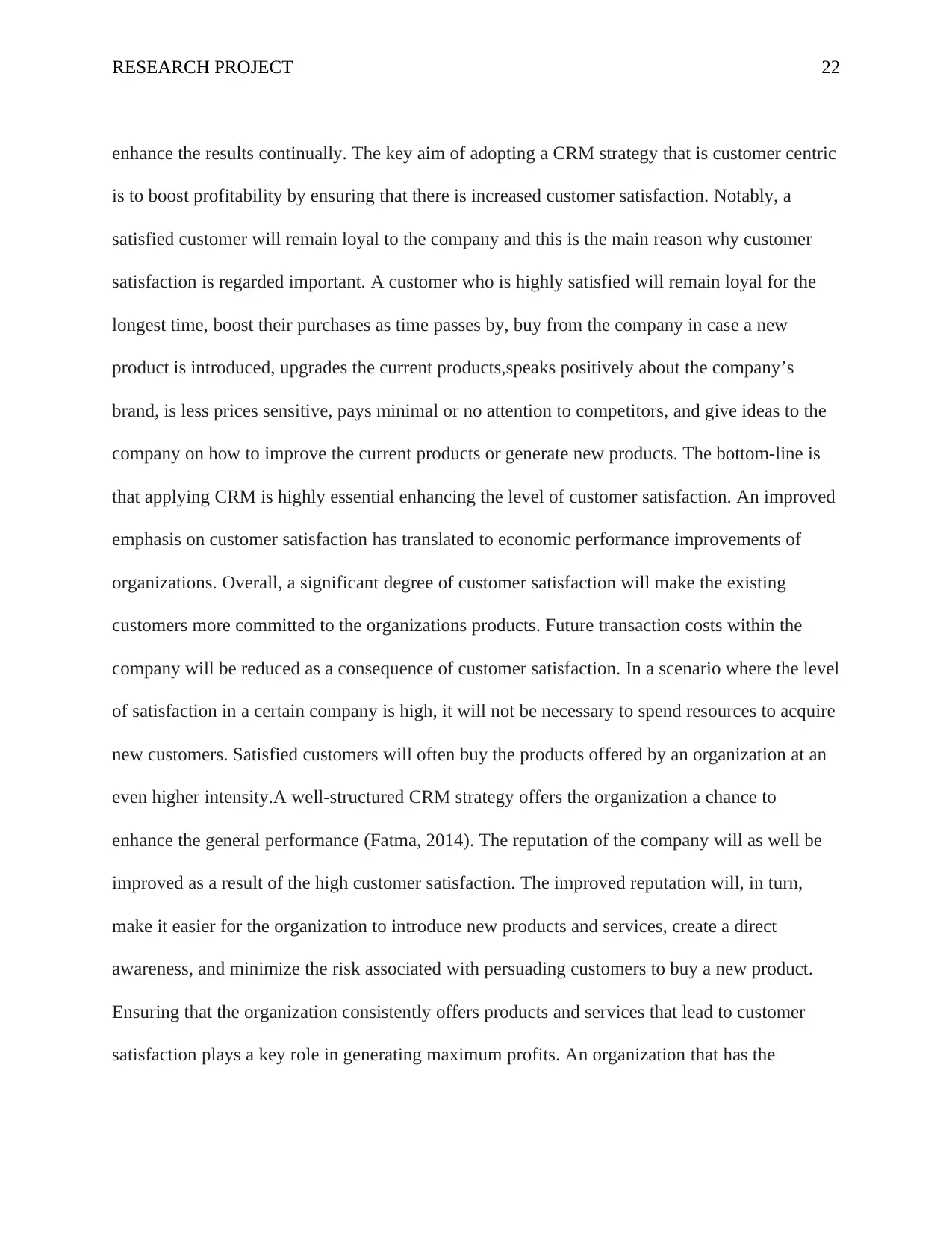
RESEARCH PROJECT 22
enhance the results continually. The key aim of adopting a CRM strategy that is customer centric
is to boost profitability by ensuring that there is increased customer satisfaction. Notably, a
satisfied customer will remain loyal to the company and this is the main reason why customer
satisfaction is regarded important. A customer who is highly satisfied will remain loyal for the
longest time, boost their purchases as time passes by, buy from the company in case a new
product is introduced, upgrades the current products,speaks positively about the company’s
brand, is less prices sensitive, pays minimal or no attention to competitors, and give ideas to the
company on how to improve the current products or generate new products. The bottom-line is
that applying CRM is highly essential enhancing the level of customer satisfaction. An improved
emphasis on customer satisfaction has translated to economic performance improvements of
organizations. Overall, a significant degree of customer satisfaction will make the existing
customers more committed to the organizations products. Future transaction costs within the
company will be reduced as a consequence of customer satisfaction. In a scenario where the level
of satisfaction in a certain company is high, it will not be necessary to spend resources to acquire
new customers. Satisfied customers will often buy the products offered by an organization at an
even higher intensity.A well-structured CRM strategy offers the organization a chance to
enhance the general performance (Fatma, 2014). The reputation of the company will as well be
improved as a result of the high customer satisfaction. The improved reputation will, in turn,
make it easier for the organization to introduce new products and services, create a direct
awareness, and minimize the risk associated with persuading customers to buy a new product.
Ensuring that the organization consistently offers products and services that lead to customer
satisfaction plays a key role in generating maximum profits. An organization that has the
enhance the results continually. The key aim of adopting a CRM strategy that is customer centric
is to boost profitability by ensuring that there is increased customer satisfaction. Notably, a
satisfied customer will remain loyal to the company and this is the main reason why customer
satisfaction is regarded important. A customer who is highly satisfied will remain loyal for the
longest time, boost their purchases as time passes by, buy from the company in case a new
product is introduced, upgrades the current products,speaks positively about the company’s
brand, is less prices sensitive, pays minimal or no attention to competitors, and give ideas to the
company on how to improve the current products or generate new products. The bottom-line is
that applying CRM is highly essential enhancing the level of customer satisfaction. An improved
emphasis on customer satisfaction has translated to economic performance improvements of
organizations. Overall, a significant degree of customer satisfaction will make the existing
customers more committed to the organizations products. Future transaction costs within the
company will be reduced as a consequence of customer satisfaction. In a scenario where the level
of satisfaction in a certain company is high, it will not be necessary to spend resources to acquire
new customers. Satisfied customers will often buy the products offered by an organization at an
even higher intensity.A well-structured CRM strategy offers the organization a chance to
enhance the general performance (Fatma, 2014). The reputation of the company will as well be
improved as a result of the high customer satisfaction. The improved reputation will, in turn,
make it easier for the organization to introduce new products and services, create a direct
awareness, and minimize the risk associated with persuading customers to buy a new product.
Ensuring that the organization consistently offers products and services that lead to customer
satisfaction plays a key role in generating maximum profits. An organization that has the
Secure Best Marks with AI Grader
Need help grading? Try our AI Grader for instant feedback on your assignments.
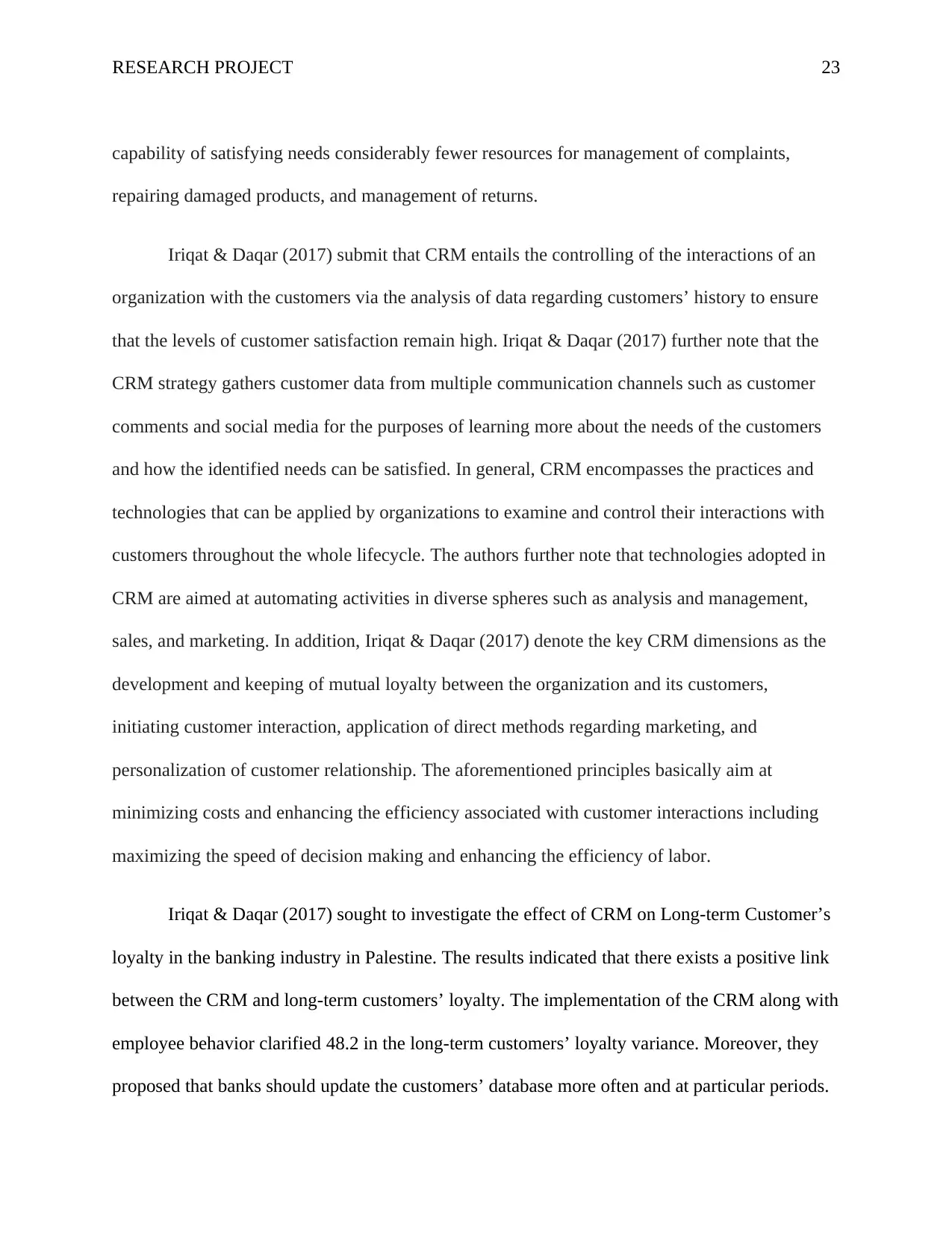
RESEARCH PROJECT 23
capability of satisfying needs considerably fewer resources for management of complaints,
repairing damaged products, and management of returns.
Iriqat & Daqar (2017) submit that CRM entails the controlling of the interactions of an
organization with the customers via the analysis of data regarding customers’ history to ensure
that the levels of customer satisfaction remain high. Iriqat & Daqar (2017) further note that the
CRM strategy gathers customer data from multiple communication channels such as customer
comments and social media for the purposes of learning more about the needs of the customers
and how the identified needs can be satisfied. In general, CRM encompasses the practices and
technologies that can be applied by organizations to examine and control their interactions with
customers throughout the whole lifecycle. The authors further note that technologies adopted in
CRM are aimed at automating activities in diverse spheres such as analysis and management,
sales, and marketing. In addition, Iriqat & Daqar (2017) denote the key CRM dimensions as the
development and keeping of mutual loyalty between the organization and its customers,
initiating customer interaction, application of direct methods regarding marketing, and
personalization of customer relationship. The aforementioned principles basically aim at
minimizing costs and enhancing the efficiency associated with customer interactions including
maximizing the speed of decision making and enhancing the efficiency of labor.
Iriqat & Daqar (2017) sought to investigate the effect of CRM on Long-term Customer’s
loyalty in the banking industry in Palestine. The results indicated that there exists a positive link
between the CRM and long-term customers’ loyalty. The implementation of the CRM along with
employee behavior clarified 48.2 in the long-term customers’ loyalty variance. Moreover, they
proposed that banks should update the customers’ database more often and at particular periods.
capability of satisfying needs considerably fewer resources for management of complaints,
repairing damaged products, and management of returns.
Iriqat & Daqar (2017) submit that CRM entails the controlling of the interactions of an
organization with the customers via the analysis of data regarding customers’ history to ensure
that the levels of customer satisfaction remain high. Iriqat & Daqar (2017) further note that the
CRM strategy gathers customer data from multiple communication channels such as customer
comments and social media for the purposes of learning more about the needs of the customers
and how the identified needs can be satisfied. In general, CRM encompasses the practices and
technologies that can be applied by organizations to examine and control their interactions with
customers throughout the whole lifecycle. The authors further note that technologies adopted in
CRM are aimed at automating activities in diverse spheres such as analysis and management,
sales, and marketing. In addition, Iriqat & Daqar (2017) denote the key CRM dimensions as the
development and keeping of mutual loyalty between the organization and its customers,
initiating customer interaction, application of direct methods regarding marketing, and
personalization of customer relationship. The aforementioned principles basically aim at
minimizing costs and enhancing the efficiency associated with customer interactions including
maximizing the speed of decision making and enhancing the efficiency of labor.
Iriqat & Daqar (2017) sought to investigate the effect of CRM on Long-term Customer’s
loyalty in the banking industry in Palestine. The results indicated that there exists a positive link
between the CRM and long-term customers’ loyalty. The implementation of the CRM along with
employee behavior clarified 48.2 in the long-term customers’ loyalty variance. Moreover, they
proposed that banks should update the customers’ database more often and at particular periods.
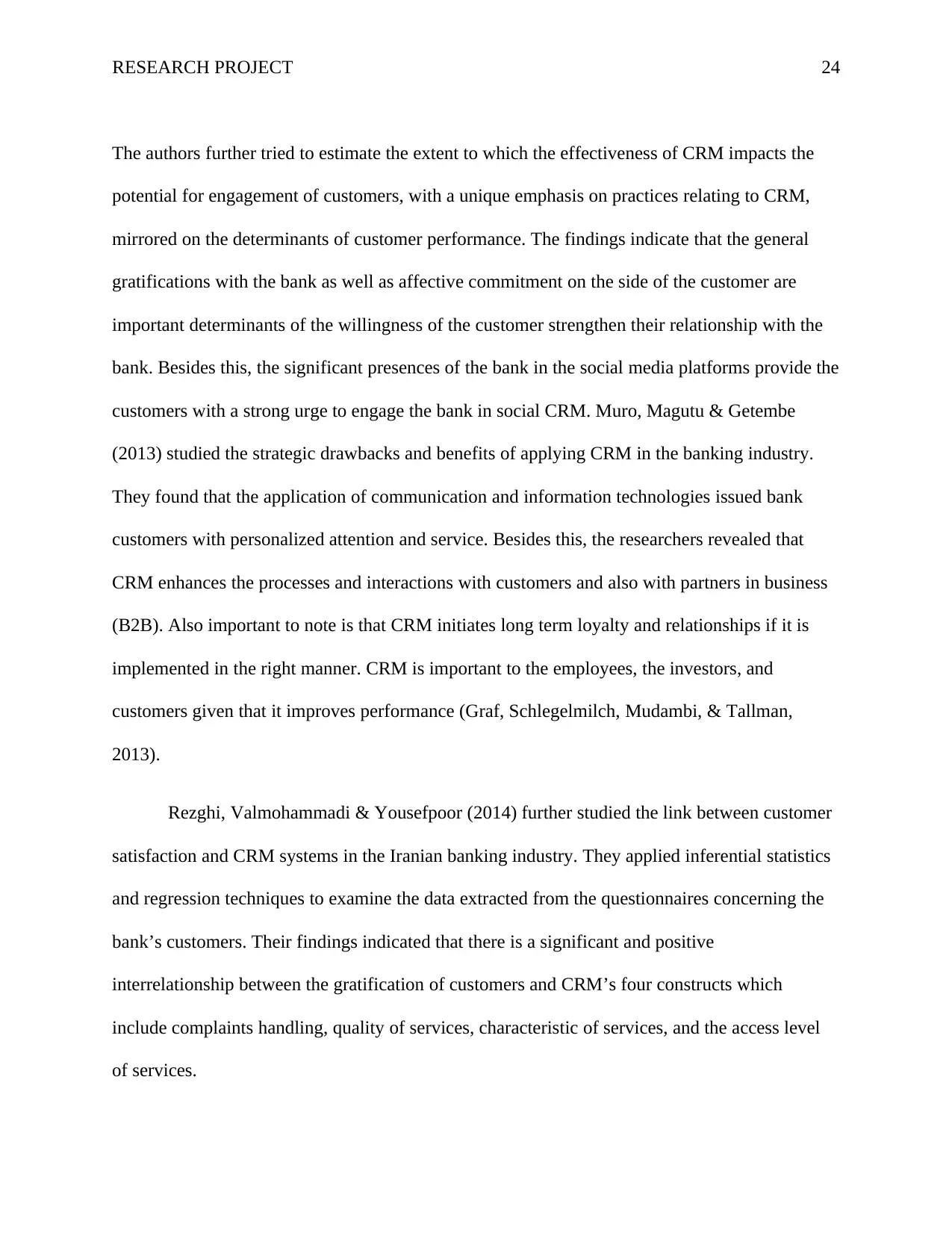
RESEARCH PROJECT 24
The authors further tried to estimate the extent to which the effectiveness of CRM impacts the
potential for engagement of customers, with a unique emphasis on practices relating to CRM,
mirrored on the determinants of customer performance. The findings indicate that the general
gratifications with the bank as well as affective commitment on the side of the customer are
important determinants of the willingness of the customer strengthen their relationship with the
bank. Besides this, the significant presences of the bank in the social media platforms provide the
customers with a strong urge to engage the bank in social CRM. Muro, Magutu & Getembe
(2013) studied the strategic drawbacks and benefits of applying CRM in the banking industry.
They found that the application of communication and information technologies issued bank
customers with personalized attention and service. Besides this, the researchers revealed that
CRM enhances the processes and interactions with customers and also with partners in business
(B2B). Also important to note is that CRM initiates long term loyalty and relationships if it is
implemented in the right manner. CRM is important to the employees, the investors, and
customers given that it improves performance (Graf, Schlegelmilch, Mudambi, & Tallman,
2013).
Rezghi, Valmohammadi & Yousefpoor (2014) further studied the link between customer
satisfaction and CRM systems in the Iranian banking industry. They applied inferential statistics
and regression techniques to examine the data extracted from the questionnaires concerning the
bank’s customers. Their findings indicated that there is a significant and positive
interrelationship between the gratification of customers and CRM’s four constructs which
include complaints handling, quality of services, characteristic of services, and the access level
of services.
The authors further tried to estimate the extent to which the effectiveness of CRM impacts the
potential for engagement of customers, with a unique emphasis on practices relating to CRM,
mirrored on the determinants of customer performance. The findings indicate that the general
gratifications with the bank as well as affective commitment on the side of the customer are
important determinants of the willingness of the customer strengthen their relationship with the
bank. Besides this, the significant presences of the bank in the social media platforms provide the
customers with a strong urge to engage the bank in social CRM. Muro, Magutu & Getembe
(2013) studied the strategic drawbacks and benefits of applying CRM in the banking industry.
They found that the application of communication and information technologies issued bank
customers with personalized attention and service. Besides this, the researchers revealed that
CRM enhances the processes and interactions with customers and also with partners in business
(B2B). Also important to note is that CRM initiates long term loyalty and relationships if it is
implemented in the right manner. CRM is important to the employees, the investors, and
customers given that it improves performance (Graf, Schlegelmilch, Mudambi, & Tallman,
2013).
Rezghi, Valmohammadi & Yousefpoor (2014) further studied the link between customer
satisfaction and CRM systems in the Iranian banking industry. They applied inferential statistics
and regression techniques to examine the data extracted from the questionnaires concerning the
bank’s customers. Their findings indicated that there is a significant and positive
interrelationship between the gratification of customers and CRM’s four constructs which
include complaints handling, quality of services, characteristic of services, and the access level
of services.
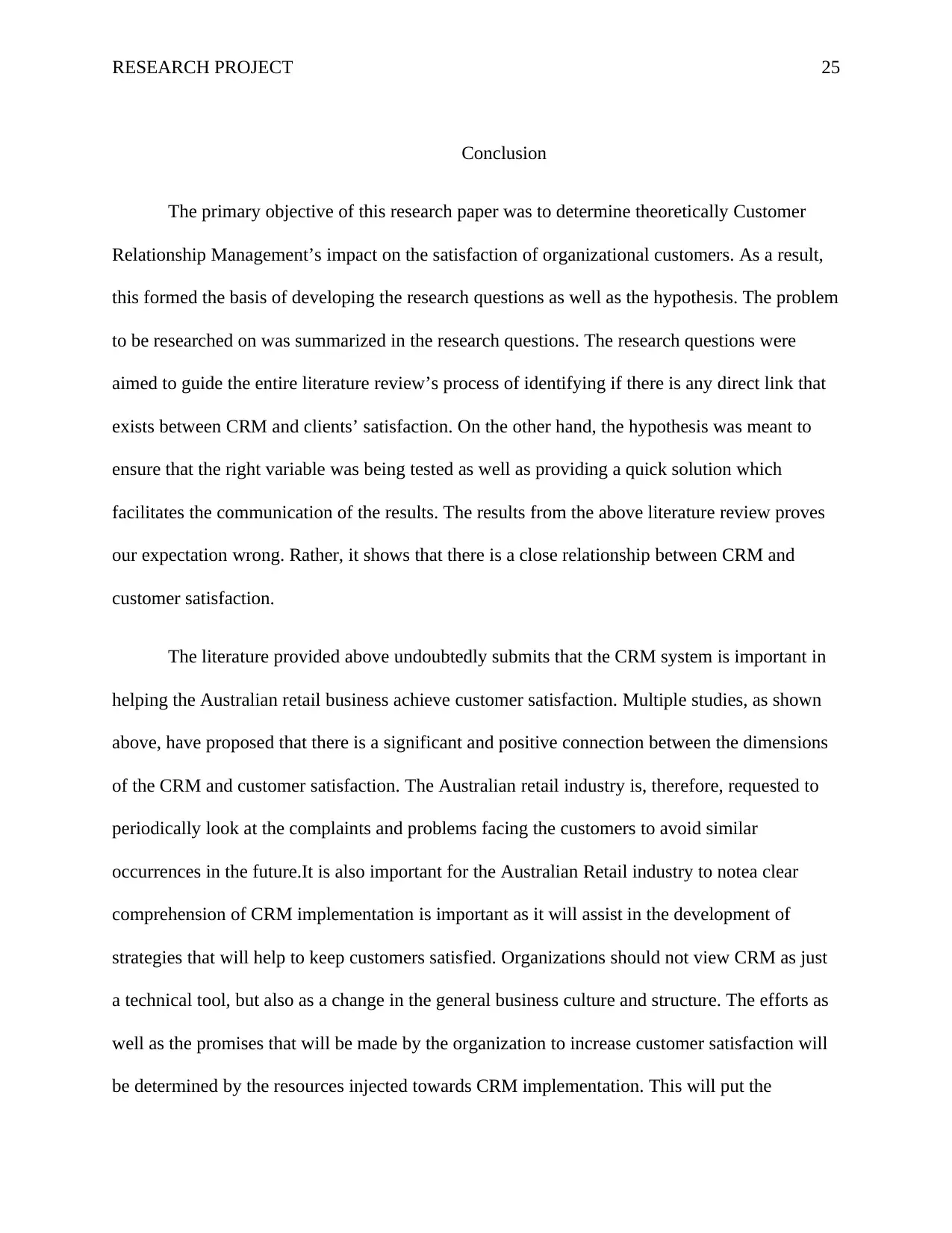
RESEARCH PROJECT 25
Conclusion
The primary objective of this research paper was to determine theoretically Customer
Relationship Management’s impact on the satisfaction of organizational customers. As a result,
this formed the basis of developing the research questions as well as the hypothesis. The problem
to be researched on was summarized in the research questions. The research questions were
aimed to guide the entire literature review’s process of identifying if there is any direct link that
exists between CRM and clients’ satisfaction. On the other hand, the hypothesis was meant to
ensure that the right variable was being tested as well as providing a quick solution which
facilitates the communication of the results. The results from the above literature review proves
our expectation wrong. Rather, it shows that there is a close relationship between CRM and
customer satisfaction.
The literature provided above undoubtedly submits that the CRM system is important in
helping the Australian retail business achieve customer satisfaction. Multiple studies, as shown
above, have proposed that there is a significant and positive connection between the dimensions
of the CRM and customer satisfaction. The Australian retail industry is, therefore, requested to
periodically look at the complaints and problems facing the customers to avoid similar
occurrences in the future.It is also important for the Australian Retail industry to notea clear
comprehension of CRM implementation is important as it will assist in the development of
strategies that will help to keep customers satisfied. Organizations should not view CRM as just
a technical tool, but also as a change in the general business culture and structure. The efforts as
well as the promises that will be made by the organization to increase customer satisfaction will
be determined by the resources injected towards CRM implementation. This will put the
Conclusion
The primary objective of this research paper was to determine theoretically Customer
Relationship Management’s impact on the satisfaction of organizational customers. As a result,
this formed the basis of developing the research questions as well as the hypothesis. The problem
to be researched on was summarized in the research questions. The research questions were
aimed to guide the entire literature review’s process of identifying if there is any direct link that
exists between CRM and clients’ satisfaction. On the other hand, the hypothesis was meant to
ensure that the right variable was being tested as well as providing a quick solution which
facilitates the communication of the results. The results from the above literature review proves
our expectation wrong. Rather, it shows that there is a close relationship between CRM and
customer satisfaction.
The literature provided above undoubtedly submits that the CRM system is important in
helping the Australian retail business achieve customer satisfaction. Multiple studies, as shown
above, have proposed that there is a significant and positive connection between the dimensions
of the CRM and customer satisfaction. The Australian retail industry is, therefore, requested to
periodically look at the complaints and problems facing the customers to avoid similar
occurrences in the future.It is also important for the Australian Retail industry to notea clear
comprehension of CRM implementation is important as it will assist in the development of
strategies that will help to keep customers satisfied. Organizations should not view CRM as just
a technical tool, but also as a change in the general business culture and structure. The efforts as
well as the promises that will be made by the organization to increase customer satisfaction will
be determined by the resources injected towards CRM implementation. This will put the
Paraphrase This Document
Need a fresh take? Get an instant paraphrase of this document with our AI Paraphraser
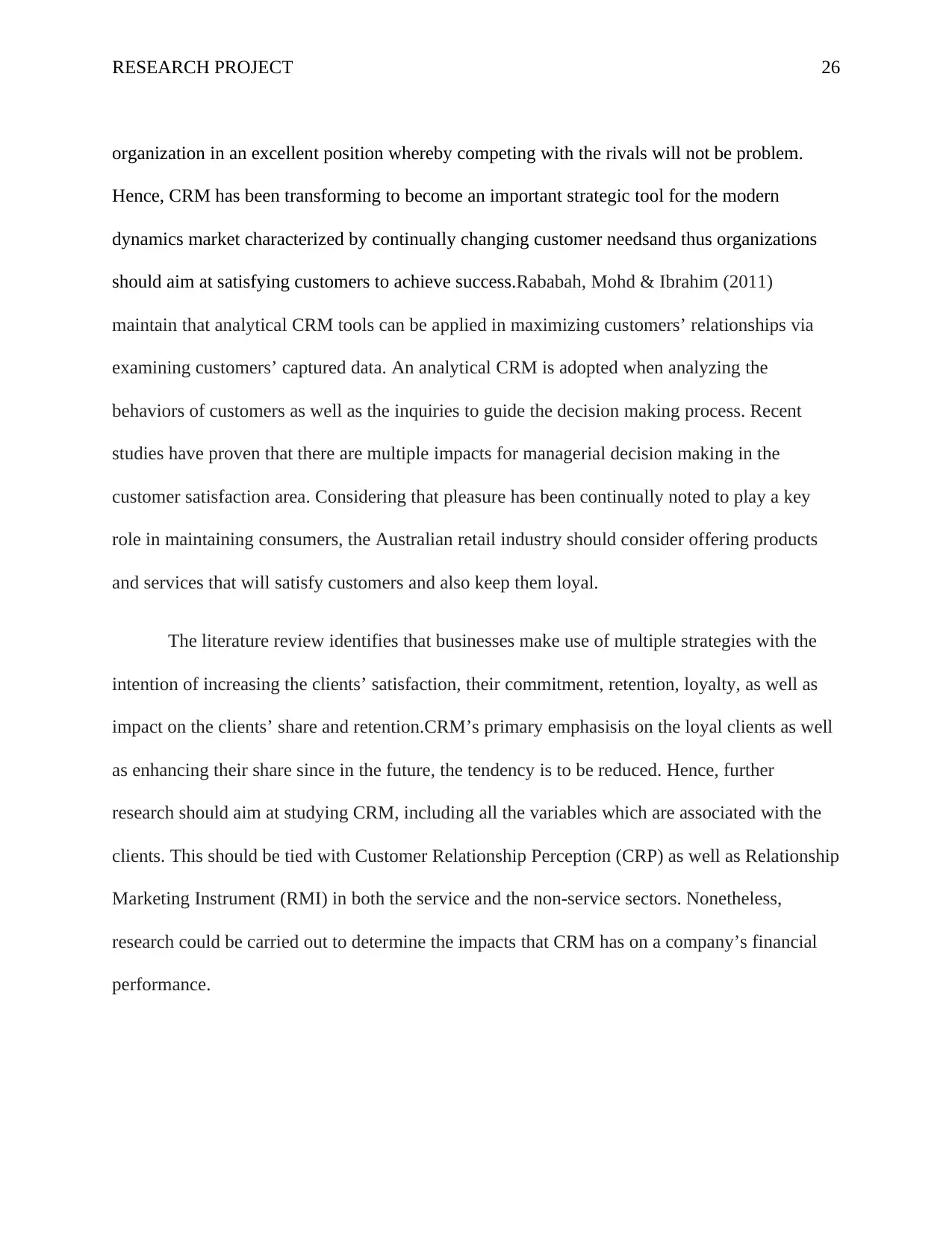
RESEARCH PROJECT 26
organization in an excellent position whereby competing with the rivals will not be problem.
Hence, CRM has been transforming to become an important strategic tool for the modern
dynamics market characterized by continually changing customer needsand thus organizations
should aim at satisfying customers to achieve success.Rababah, Mohd & Ibrahim (2011)
maintain that analytical CRM tools can be applied in maximizing customers’ relationships via
examining customers’ captured data. An analytical CRM is adopted when analyzing the
behaviors of customers as well as the inquiries to guide the decision making process. Recent
studies have proven that there are multiple impacts for managerial decision making in the
customer satisfaction area. Considering that pleasure has been continually noted to play a key
role in maintaining consumers, the Australian retail industry should consider offering products
and services that will satisfy customers and also keep them loyal.
The literature review identifies that businesses make use of multiple strategies with the
intention of increasing the clients’ satisfaction, their commitment, retention, loyalty, as well as
impact on the clients’ share and retention.CRM’s primary emphasisis on the loyal clients as well
as enhancing their share since in the future, the tendency is to be reduced. Hence, further
research should aim at studying CRM, including all the variables which are associated with the
clients. This should be tied with Customer Relationship Perception (CRP) as well as Relationship
Marketing Instrument (RMI) in both the service and the non-service sectors. Nonetheless,
research could be carried out to determine the impacts that CRM has on a company’s financial
performance.
organization in an excellent position whereby competing with the rivals will not be problem.
Hence, CRM has been transforming to become an important strategic tool for the modern
dynamics market characterized by continually changing customer needsand thus organizations
should aim at satisfying customers to achieve success.Rababah, Mohd & Ibrahim (2011)
maintain that analytical CRM tools can be applied in maximizing customers’ relationships via
examining customers’ captured data. An analytical CRM is adopted when analyzing the
behaviors of customers as well as the inquiries to guide the decision making process. Recent
studies have proven that there are multiple impacts for managerial decision making in the
customer satisfaction area. Considering that pleasure has been continually noted to play a key
role in maintaining consumers, the Australian retail industry should consider offering products
and services that will satisfy customers and also keep them loyal.
The literature review identifies that businesses make use of multiple strategies with the
intention of increasing the clients’ satisfaction, their commitment, retention, loyalty, as well as
impact on the clients’ share and retention.CRM’s primary emphasisis on the loyal clients as well
as enhancing their share since in the future, the tendency is to be reduced. Hence, further
research should aim at studying CRM, including all the variables which are associated with the
clients. This should be tied with Customer Relationship Perception (CRP) as well as Relationship
Marketing Instrument (RMI) in both the service and the non-service sectors. Nonetheless,
research could be carried out to determine the impacts that CRM has on a company’s financial
performance.
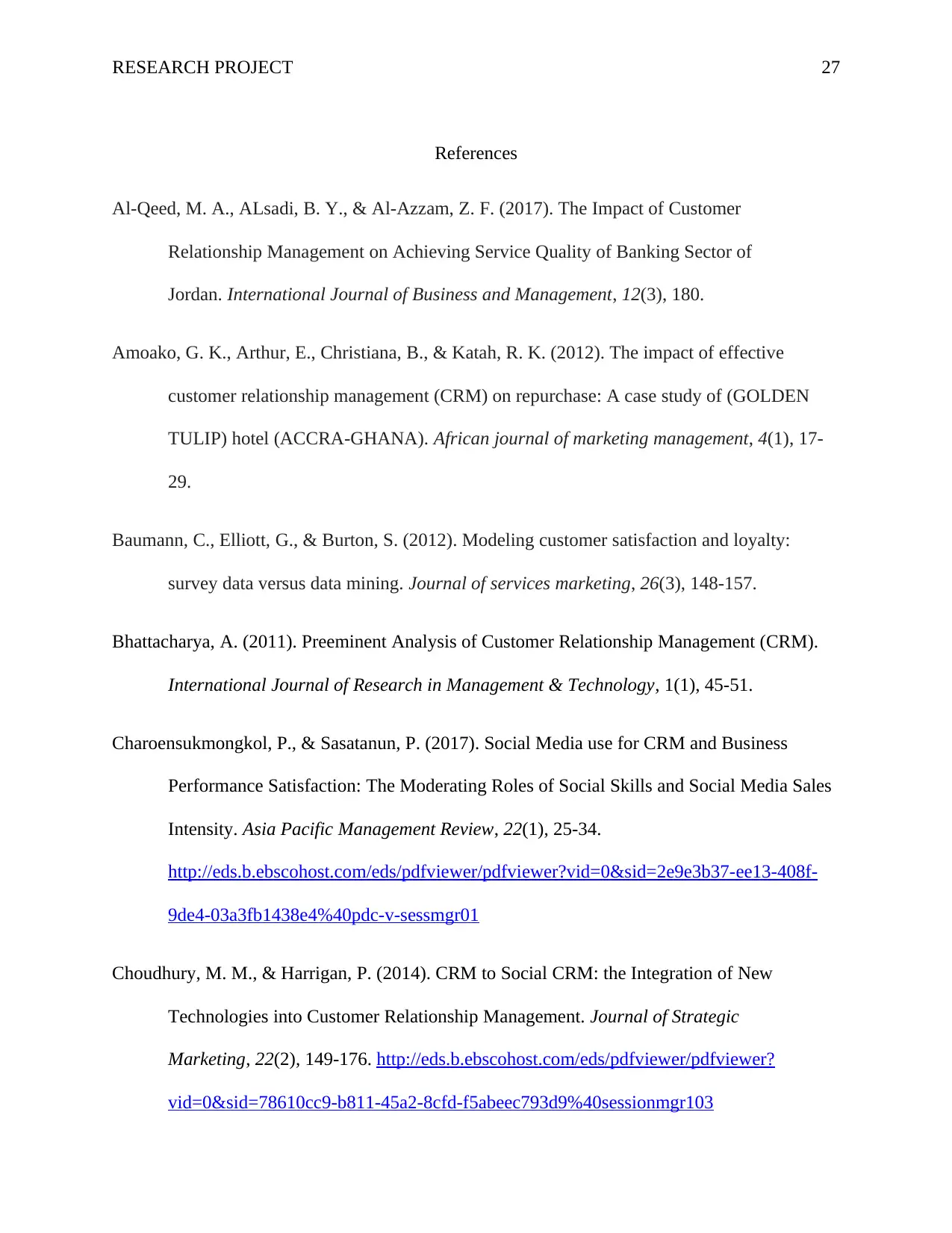
RESEARCH PROJECT 27
References
Al-Qeed, M. A., ALsadi, B. Y., & Al-Azzam, Z. F. (2017). The Impact of Customer
Relationship Management on Achieving Service Quality of Banking Sector of
Jordan. International Journal of Business and Management, 12(3), 180.
Amoako, G. K., Arthur, E., Christiana, B., & Katah, R. K. (2012). The impact of effective
customer relationship management (CRM) on repurchase: A case study of (GOLDEN
TULIP) hotel (ACCRA-GHANA). African journal of marketing management, 4(1), 17-
29.
Baumann, C., Elliott, G., & Burton, S. (2012). Modeling customer satisfaction and loyalty:
survey data versus data mining. Journal of services marketing, 26(3), 148-157.
Bhattacharya, A. (2011). Preeminent Analysis of Customer Relationship Management (CRM).
International Journal of Research in Management & Technology, 1(1), 45-51.
Charoensukmongkol, P., & Sasatanun, P. (2017). Social Media use for CRM and Business
Performance Satisfaction: The Moderating Roles of Social Skills and Social Media Sales
Intensity. Asia Pacific Management Review, 22(1), 25-34.
http://eds.b.ebscohost.com/eds/pdfviewer/pdfviewer?vid=0&sid=2e9e3b37-ee13-408f-
9de4-03a3fb1438e4%40pdc-v-sessmgr01
Choudhury, M. M., & Harrigan, P. (2014). CRM to Social CRM: the Integration of New
Technologies into Customer Relationship Management. Journal of Strategic
Marketing, 22(2), 149-176. http://eds.b.ebscohost.com/eds/pdfviewer/pdfviewer?
vid=0&sid=78610cc9-b811-45a2-8cfd-f5abeec793d9%40sessionmgr103
References
Al-Qeed, M. A., ALsadi, B. Y., & Al-Azzam, Z. F. (2017). The Impact of Customer
Relationship Management on Achieving Service Quality of Banking Sector of
Jordan. International Journal of Business and Management, 12(3), 180.
Amoako, G. K., Arthur, E., Christiana, B., & Katah, R. K. (2012). The impact of effective
customer relationship management (CRM) on repurchase: A case study of (GOLDEN
TULIP) hotel (ACCRA-GHANA). African journal of marketing management, 4(1), 17-
29.
Baumann, C., Elliott, G., & Burton, S. (2012). Modeling customer satisfaction and loyalty:
survey data versus data mining. Journal of services marketing, 26(3), 148-157.
Bhattacharya, A. (2011). Preeminent Analysis of Customer Relationship Management (CRM).
International Journal of Research in Management & Technology, 1(1), 45-51.
Charoensukmongkol, P., & Sasatanun, P. (2017). Social Media use for CRM and Business
Performance Satisfaction: The Moderating Roles of Social Skills and Social Media Sales
Intensity. Asia Pacific Management Review, 22(1), 25-34.
http://eds.b.ebscohost.com/eds/pdfviewer/pdfviewer?vid=0&sid=2e9e3b37-ee13-408f-
9de4-03a3fb1438e4%40pdc-v-sessmgr01
Choudhury, M. M., & Harrigan, P. (2014). CRM to Social CRM: the Integration of New
Technologies into Customer Relationship Management. Journal of Strategic
Marketing, 22(2), 149-176. http://eds.b.ebscohost.com/eds/pdfviewer/pdfviewer?
vid=0&sid=78610cc9-b811-45a2-8cfd-f5abeec793d9%40sessionmgr103
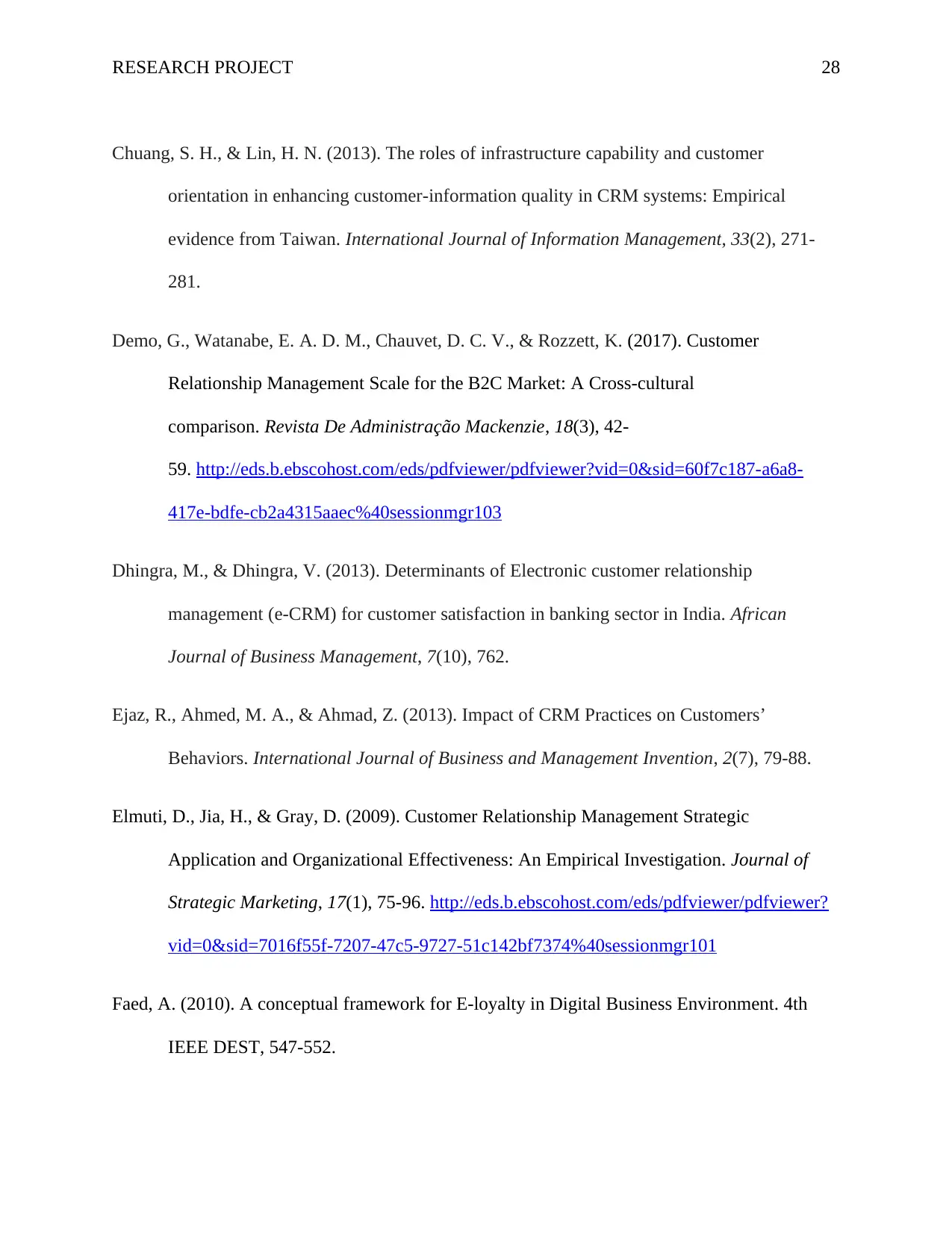
RESEARCH PROJECT 28
Chuang, S. H., & Lin, H. N. (2013). The roles of infrastructure capability and customer
orientation in enhancing customer-information quality in CRM systems: Empirical
evidence from Taiwan. International Journal of Information Management, 33(2), 271-
281.
Demo, G., Watanabe, E. A. D. M., Chauvet, D. C. V., & Rozzett, K. (2017). Customer
Relationship Management Scale for the B2C Market: A Cross-cultural
comparison. Revista De Administração Mackenzie, 18(3), 42-
59. http://eds.b.ebscohost.com/eds/pdfviewer/pdfviewer?vid=0&sid=60f7c187-a6a8-
417e-bdfe-cb2a4315aaec%40sessionmgr103
Dhingra, M., & Dhingra, V. (2013). Determinants of Electronic customer relationship
management (e-CRM) for customer satisfaction in banking sector in India. African
Journal of Business Management, 7(10), 762.
Ejaz, R., Ahmed, M. A., & Ahmad, Z. (2013). Impact of CRM Practices on Customers’
Behaviors. International Journal of Business and Management Invention, 2(7), 79-88.
Elmuti, D., Jia, H., & Gray, D. (2009). Customer Relationship Management Strategic
Application and Organizational Effectiveness: An Empirical Investigation. Journal of
Strategic Marketing, 17(1), 75-96. http://eds.b.ebscohost.com/eds/pdfviewer/pdfviewer?
vid=0&sid=7016f55f-7207-47c5-9727-51c142bf7374%40sessionmgr101
Faed, A. (2010). A conceptual framework for E-loyalty in Digital Business Environment. 4th
IEEE DEST, 547-552.
Chuang, S. H., & Lin, H. N. (2013). The roles of infrastructure capability and customer
orientation in enhancing customer-information quality in CRM systems: Empirical
evidence from Taiwan. International Journal of Information Management, 33(2), 271-
281.
Demo, G., Watanabe, E. A. D. M., Chauvet, D. C. V., & Rozzett, K. (2017). Customer
Relationship Management Scale for the B2C Market: A Cross-cultural
comparison. Revista De Administração Mackenzie, 18(3), 42-
59. http://eds.b.ebscohost.com/eds/pdfviewer/pdfviewer?vid=0&sid=60f7c187-a6a8-
417e-bdfe-cb2a4315aaec%40sessionmgr103
Dhingra, M., & Dhingra, V. (2013). Determinants of Electronic customer relationship
management (e-CRM) for customer satisfaction in banking sector in India. African
Journal of Business Management, 7(10), 762.
Ejaz, R., Ahmed, M. A., & Ahmad, Z. (2013). Impact of CRM Practices on Customers’
Behaviors. International Journal of Business and Management Invention, 2(7), 79-88.
Elmuti, D., Jia, H., & Gray, D. (2009). Customer Relationship Management Strategic
Application and Organizational Effectiveness: An Empirical Investigation. Journal of
Strategic Marketing, 17(1), 75-96. http://eds.b.ebscohost.com/eds/pdfviewer/pdfviewer?
vid=0&sid=7016f55f-7207-47c5-9727-51c142bf7374%40sessionmgr101
Faed, A. (2010). A conceptual framework for E-loyalty in Digital Business Environment. 4th
IEEE DEST, 547-552.
Secure Best Marks with AI Grader
Need help grading? Try our AI Grader for instant feedback on your assignments.
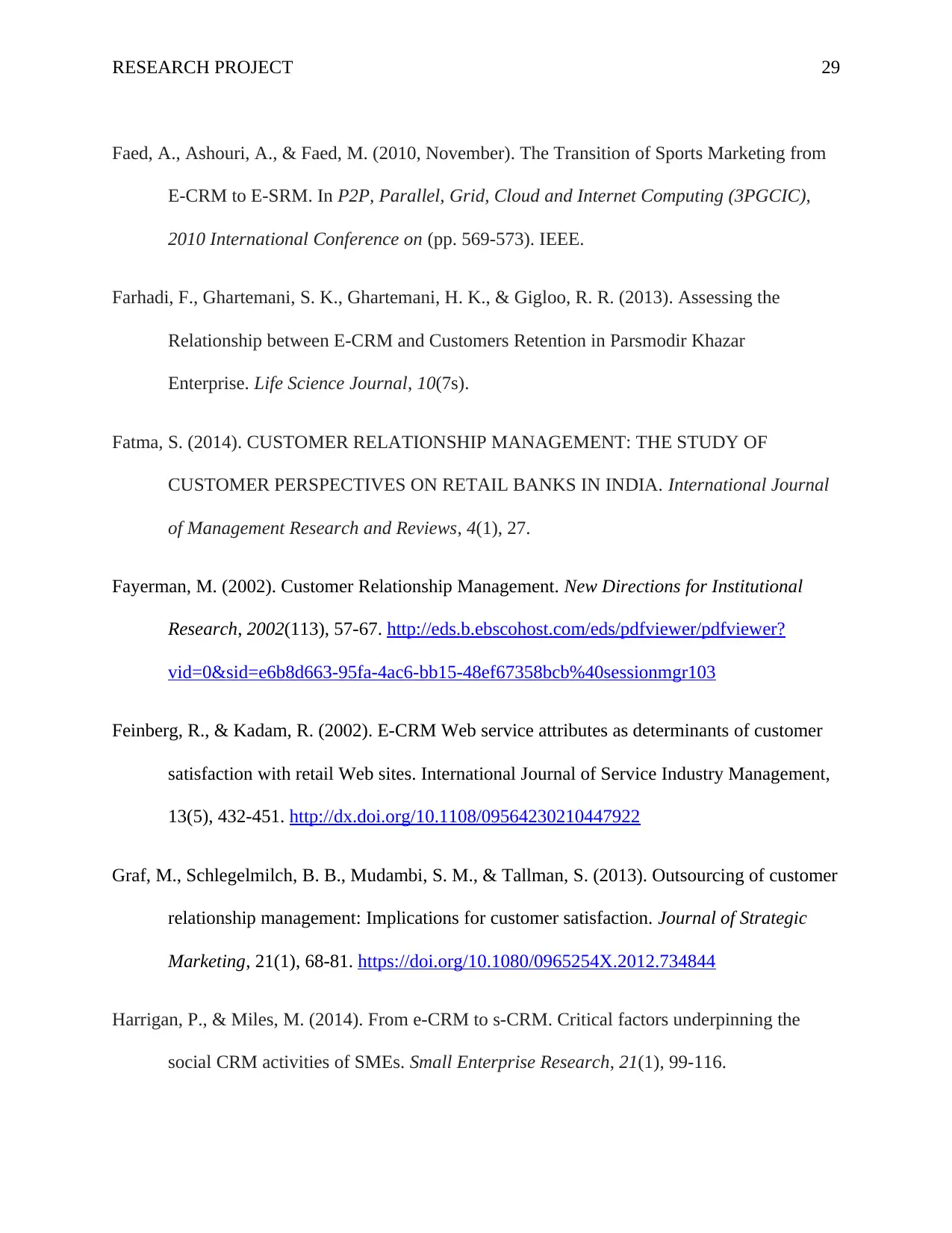
RESEARCH PROJECT 29
Faed, A., Ashouri, A., & Faed, M. (2010, November). The Transition of Sports Marketing from
E-CRM to E-SRM. In P2P, Parallel, Grid, Cloud and Internet Computing (3PGCIC),
2010 International Conference on (pp. 569-573). IEEE.
Farhadi, F., Ghartemani, S. K., Ghartemani, H. K., & Gigloo, R. R. (2013). Assessing the
Relationship between E-CRM and Customers Retention in Parsmodir Khazar
Enterprise. Life Science Journal, 10(7s).
Fatma, S. (2014). CUSTOMER RELATIONSHIP MANAGEMENT: THE STUDY OF
CUSTOMER PERSPECTIVES ON RETAIL BANKS IN INDIA. International Journal
of Management Research and Reviews, 4(1), 27.
Fayerman, M. (2002). Customer Relationship Management. New Directions for Institutional
Research, 2002(113), 57-67. http://eds.b.ebscohost.com/eds/pdfviewer/pdfviewer?
vid=0&sid=e6b8d663-95fa-4ac6-bb15-48ef67358bcb%40sessionmgr103
Feinberg, R., & Kadam, R. (2002). E-CRM Web service attributes as determinants of customer
satisfaction with retail Web sites. International Journal of Service Industry Management,
13(5), 432-451. http://dx.doi.org/10.1108/09564230210447922
Graf, M., Schlegelmilch, B. B., Mudambi, S. M., & Tallman, S. (2013). Outsourcing of customer
relationship management: Implications for customer satisfaction. Journal of Strategic
Marketing, 21(1), 68-81. https://doi.org/10.1080/0965254X.2012.734844
Harrigan, P., & Miles, M. (2014). From e-CRM to s-CRM. Critical factors underpinning the
social CRM activities of SMEs. Small Enterprise Research, 21(1), 99-116.
Faed, A., Ashouri, A., & Faed, M. (2010, November). The Transition of Sports Marketing from
E-CRM to E-SRM. In P2P, Parallel, Grid, Cloud and Internet Computing (3PGCIC),
2010 International Conference on (pp. 569-573). IEEE.
Farhadi, F., Ghartemani, S. K., Ghartemani, H. K., & Gigloo, R. R. (2013). Assessing the
Relationship between E-CRM and Customers Retention in Parsmodir Khazar
Enterprise. Life Science Journal, 10(7s).
Fatma, S. (2014). CUSTOMER RELATIONSHIP MANAGEMENT: THE STUDY OF
CUSTOMER PERSPECTIVES ON RETAIL BANKS IN INDIA. International Journal
of Management Research and Reviews, 4(1), 27.
Fayerman, M. (2002). Customer Relationship Management. New Directions for Institutional
Research, 2002(113), 57-67. http://eds.b.ebscohost.com/eds/pdfviewer/pdfviewer?
vid=0&sid=e6b8d663-95fa-4ac6-bb15-48ef67358bcb%40sessionmgr103
Feinberg, R., & Kadam, R. (2002). E-CRM Web service attributes as determinants of customer
satisfaction with retail Web sites. International Journal of Service Industry Management,
13(5), 432-451. http://dx.doi.org/10.1108/09564230210447922
Graf, M., Schlegelmilch, B. B., Mudambi, S. M., & Tallman, S. (2013). Outsourcing of customer
relationship management: Implications for customer satisfaction. Journal of Strategic
Marketing, 21(1), 68-81. https://doi.org/10.1080/0965254X.2012.734844
Harrigan, P., & Miles, M. (2014). From e-CRM to s-CRM. Critical factors underpinning the
social CRM activities of SMEs. Small Enterprise Research, 21(1), 99-116.
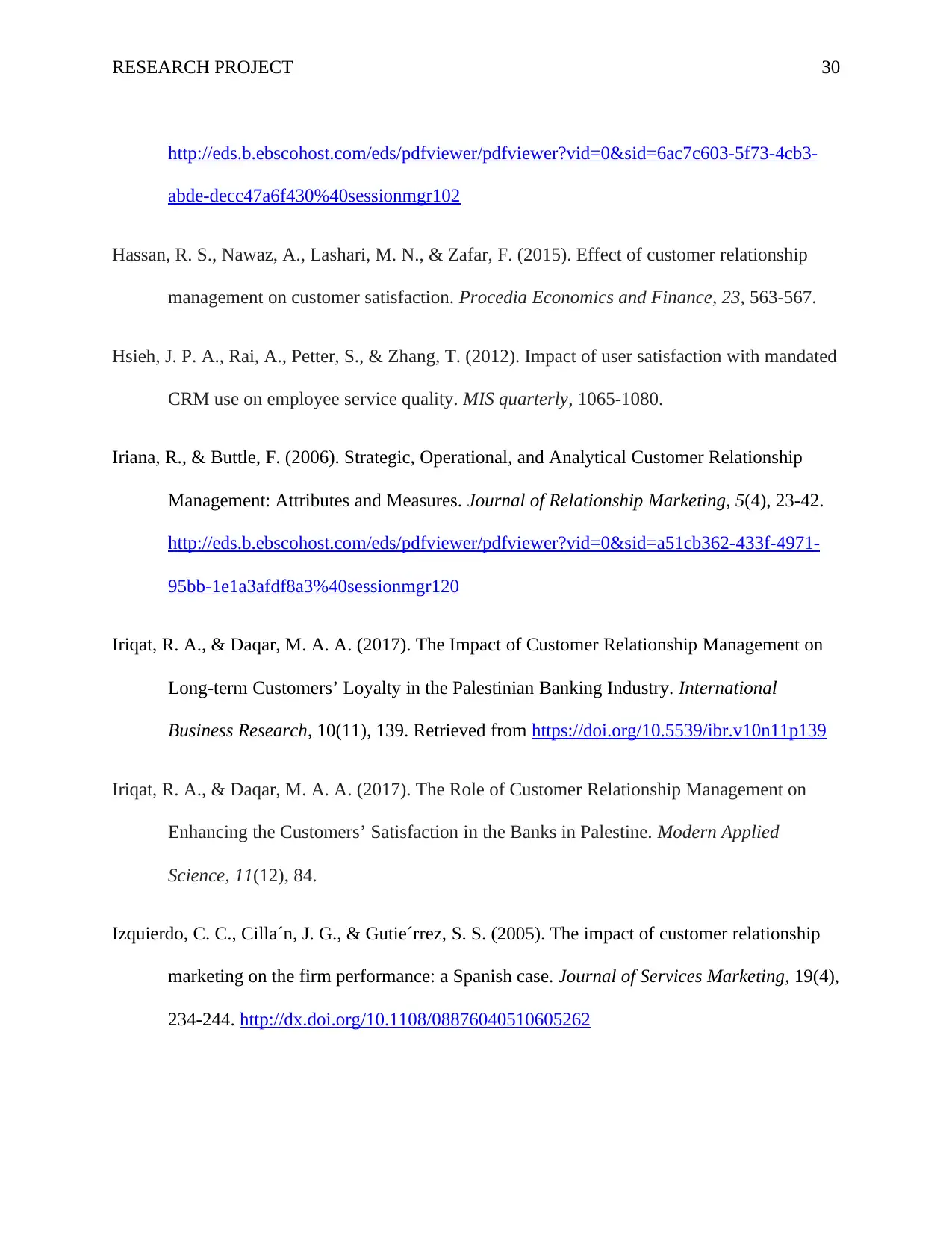
RESEARCH PROJECT 30
http://eds.b.ebscohost.com/eds/pdfviewer/pdfviewer?vid=0&sid=6ac7c603-5f73-4cb3-
abde-decc47a6f430%40sessionmgr102
Hassan, R. S., Nawaz, A., Lashari, M. N., & Zafar, F. (2015). Effect of customer relationship
management on customer satisfaction. Procedia Economics and Finance, 23, 563-567.
Hsieh, J. P. A., Rai, A., Petter, S., & Zhang, T. (2012). Impact of user satisfaction with mandated
CRM use on employee service quality. MIS quarterly, 1065-1080.
Iriana, R., & Buttle, F. (2006). Strategic, Operational, and Analytical Customer Relationship
Management: Attributes and Measures. Journal of Relationship Marketing, 5(4), 23-42.
http://eds.b.ebscohost.com/eds/pdfviewer/pdfviewer?vid=0&sid=a51cb362-433f-4971-
95bb-1e1a3afdf8a3%40sessionmgr120
Iriqat, R. A., & Daqar, M. A. A. (2017). The Impact of Customer Relationship Management on
Long-term Customers’ Loyalty in the Palestinian Banking Industry. International
Business Research, 10(11), 139. Retrieved from https://doi.org/10.5539/ibr.v10n11p139
Iriqat, R. A., & Daqar, M. A. A. (2017). The Role of Customer Relationship Management on
Enhancing the Customers’ Satisfaction in the Banks in Palestine. Modern Applied
Science, 11(12), 84.
Izquierdo, C. C., Cilla´n, J. G., & Gutie´rrez, S. S. (2005). The impact of customer relationship
marketing on the firm performance: a Spanish case. Journal of Services Marketing, 19(4),
234-244. http://dx.doi.org/10.1108/08876040510605262
http://eds.b.ebscohost.com/eds/pdfviewer/pdfviewer?vid=0&sid=6ac7c603-5f73-4cb3-
abde-decc47a6f430%40sessionmgr102
Hassan, R. S., Nawaz, A., Lashari, M. N., & Zafar, F. (2015). Effect of customer relationship
management on customer satisfaction. Procedia Economics and Finance, 23, 563-567.
Hsieh, J. P. A., Rai, A., Petter, S., & Zhang, T. (2012). Impact of user satisfaction with mandated
CRM use on employee service quality. MIS quarterly, 1065-1080.
Iriana, R., & Buttle, F. (2006). Strategic, Operational, and Analytical Customer Relationship
Management: Attributes and Measures. Journal of Relationship Marketing, 5(4), 23-42.
http://eds.b.ebscohost.com/eds/pdfviewer/pdfviewer?vid=0&sid=a51cb362-433f-4971-
95bb-1e1a3afdf8a3%40sessionmgr120
Iriqat, R. A., & Daqar, M. A. A. (2017). The Impact of Customer Relationship Management on
Long-term Customers’ Loyalty in the Palestinian Banking Industry. International
Business Research, 10(11), 139. Retrieved from https://doi.org/10.5539/ibr.v10n11p139
Iriqat, R. A., & Daqar, M. A. A. (2017). The Role of Customer Relationship Management on
Enhancing the Customers’ Satisfaction in the Banks in Palestine. Modern Applied
Science, 11(12), 84.
Izquierdo, C. C., Cilla´n, J. G., & Gutie´rrez, S. S. (2005). The impact of customer relationship
marketing on the firm performance: a Spanish case. Journal of Services Marketing, 19(4),
234-244. http://dx.doi.org/10.1108/08876040510605262
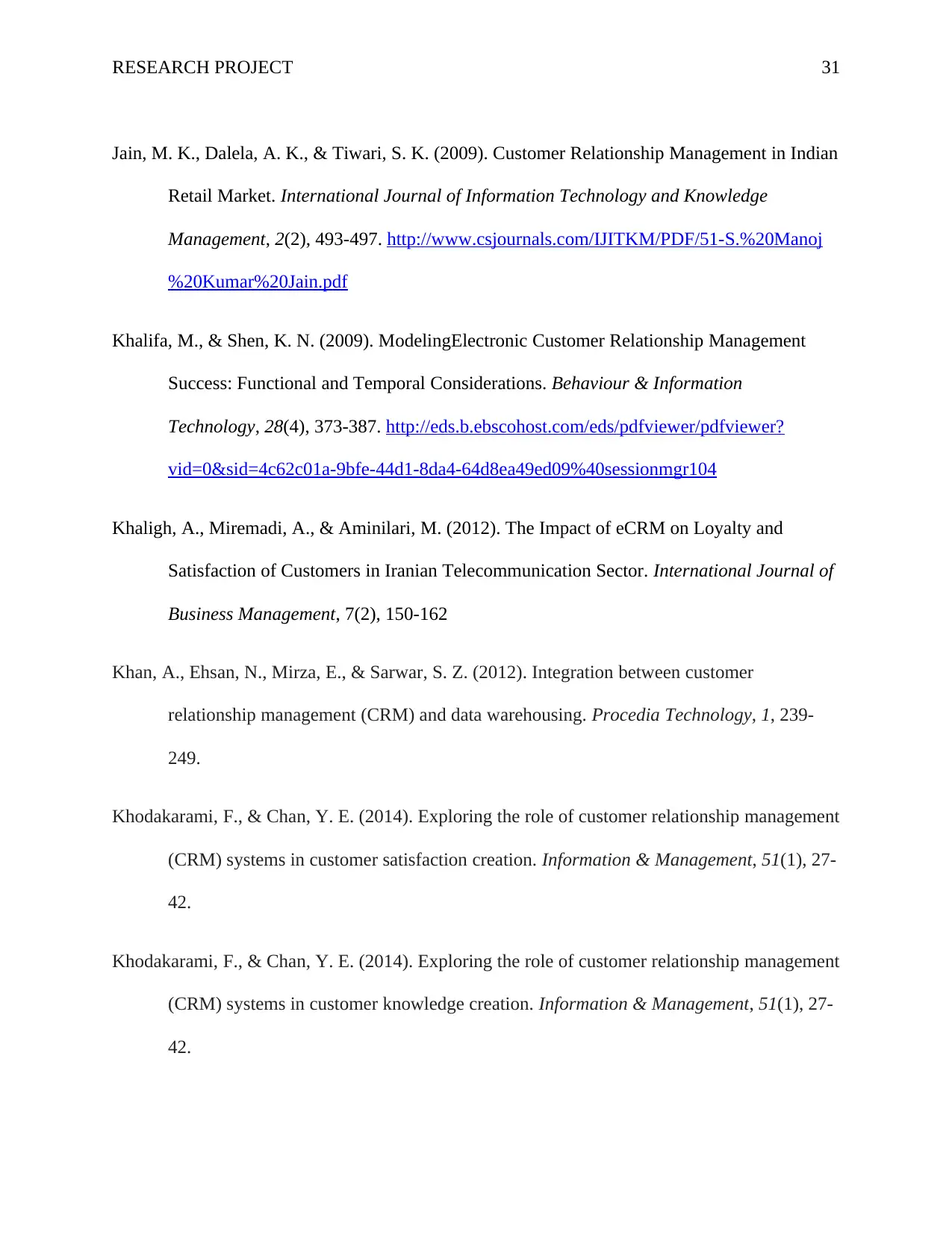
RESEARCH PROJECT 31
Jain, M. K., Dalela, A. K., & Tiwari, S. K. (2009). Customer Relationship Management in Indian
Retail Market. International Journal of Information Technology and Knowledge
Management, 2(2), 493-497. http://www.csjournals.com/IJITKM/PDF/51-S.%20Manoj
%20Kumar%20Jain.pdf
Khalifa, M., & Shen, K. N. (2009). ModelingElectronic Customer Relationship Management
Success: Functional and Temporal Considerations. Behaviour & Information
Technology, 28(4), 373-387. http://eds.b.ebscohost.com/eds/pdfviewer/pdfviewer?
vid=0&sid=4c62c01a-9bfe-44d1-8da4-64d8ea49ed09%40sessionmgr104
Khaligh, A., Miremadi, A., & Aminilari, M. (2012). The Impact of eCRM on Loyalty and
Satisfaction of Customers in Iranian Telecommunication Sector. International Journal of
Business Management, 7(2), 150-162
Khan, A., Ehsan, N., Mirza, E., & Sarwar, S. Z. (2012). Integration between customer
relationship management (CRM) and data warehousing. Procedia Technology, 1, 239-
249.
Khodakarami, F., & Chan, Y. E. (2014). Exploring the role of customer relationship management
(CRM) systems in customer satisfaction creation. Information & Management, 51(1), 27-
42.
Khodakarami, F., & Chan, Y. E. (2014). Exploring the role of customer relationship management
(CRM) systems in customer knowledge creation. Information & Management, 51(1), 27-
42.
Jain, M. K., Dalela, A. K., & Tiwari, S. K. (2009). Customer Relationship Management in Indian
Retail Market. International Journal of Information Technology and Knowledge
Management, 2(2), 493-497. http://www.csjournals.com/IJITKM/PDF/51-S.%20Manoj
%20Kumar%20Jain.pdf
Khalifa, M., & Shen, K. N. (2009). ModelingElectronic Customer Relationship Management
Success: Functional and Temporal Considerations. Behaviour & Information
Technology, 28(4), 373-387. http://eds.b.ebscohost.com/eds/pdfviewer/pdfviewer?
vid=0&sid=4c62c01a-9bfe-44d1-8da4-64d8ea49ed09%40sessionmgr104
Khaligh, A., Miremadi, A., & Aminilari, M. (2012). The Impact of eCRM on Loyalty and
Satisfaction of Customers in Iranian Telecommunication Sector. International Journal of
Business Management, 7(2), 150-162
Khan, A., Ehsan, N., Mirza, E., & Sarwar, S. Z. (2012). Integration between customer
relationship management (CRM) and data warehousing. Procedia Technology, 1, 239-
249.
Khodakarami, F., & Chan, Y. E. (2014). Exploring the role of customer relationship management
(CRM) systems in customer satisfaction creation. Information & Management, 51(1), 27-
42.
Khodakarami, F., & Chan, Y. E. (2014). Exploring the role of customer relationship management
(CRM) systems in customer knowledge creation. Information & Management, 51(1), 27-
42.
Paraphrase This Document
Need a fresh take? Get an instant paraphrase of this document with our AI Paraphraser
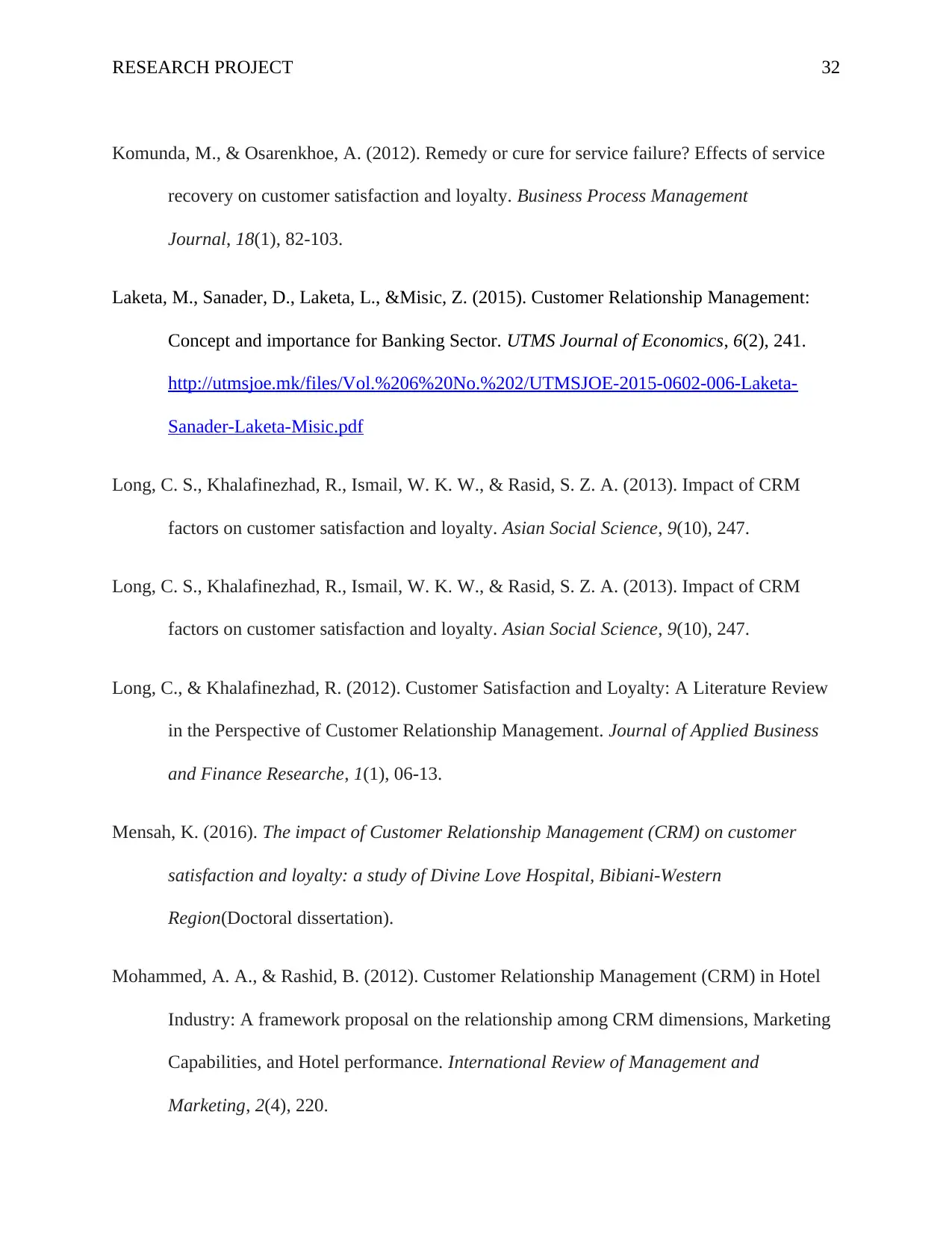
RESEARCH PROJECT 32
Komunda, M., & Osarenkhoe, A. (2012). Remedy or cure for service failure? Effects of service
recovery on customer satisfaction and loyalty. Business Process Management
Journal, 18(1), 82-103.
Laketa, M., Sanader, D., Laketa, L., &Misic, Z. (2015). Customer Relationship Management:
Concept and importance for Banking Sector. UTMS Journal of Economics, 6(2), 241.
http://utmsjoe.mk/files/Vol.%206%20No.%202/UTMSJOE-2015-0602-006-Laketa-
Sanader-Laketa-Misic.pdf
Long, C. S., Khalafinezhad, R., Ismail, W. K. W., & Rasid, S. Z. A. (2013). Impact of CRM
factors on customer satisfaction and loyalty. Asian Social Science, 9(10), 247.
Long, C. S., Khalafinezhad, R., Ismail, W. K. W., & Rasid, S. Z. A. (2013). Impact of CRM
factors on customer satisfaction and loyalty. Asian Social Science, 9(10), 247.
Long, C., & Khalafinezhad, R. (2012). Customer Satisfaction and Loyalty: A Literature Review
in the Perspective of Customer Relationship Management. Journal of Applied Business
and Finance Researche, 1(1), 06-13.
Mensah, K. (2016). The impact of Customer Relationship Management (CRM) on customer
satisfaction and loyalty: a study of Divine Love Hospital, Bibiani-Western
Region(Doctoral dissertation).
Mohammed, A. A., & Rashid, B. (2012). Customer Relationship Management (CRM) in Hotel
Industry: A framework proposal on the relationship among CRM dimensions, Marketing
Capabilities, and Hotel performance. International Review of Management and
Marketing, 2(4), 220.
Komunda, M., & Osarenkhoe, A. (2012). Remedy or cure for service failure? Effects of service
recovery on customer satisfaction and loyalty. Business Process Management
Journal, 18(1), 82-103.
Laketa, M., Sanader, D., Laketa, L., &Misic, Z. (2015). Customer Relationship Management:
Concept and importance for Banking Sector. UTMS Journal of Economics, 6(2), 241.
http://utmsjoe.mk/files/Vol.%206%20No.%202/UTMSJOE-2015-0602-006-Laketa-
Sanader-Laketa-Misic.pdf
Long, C. S., Khalafinezhad, R., Ismail, W. K. W., & Rasid, S. Z. A. (2013). Impact of CRM
factors on customer satisfaction and loyalty. Asian Social Science, 9(10), 247.
Long, C. S., Khalafinezhad, R., Ismail, W. K. W., & Rasid, S. Z. A. (2013). Impact of CRM
factors on customer satisfaction and loyalty. Asian Social Science, 9(10), 247.
Long, C., & Khalafinezhad, R. (2012). Customer Satisfaction and Loyalty: A Literature Review
in the Perspective of Customer Relationship Management. Journal of Applied Business
and Finance Researche, 1(1), 06-13.
Mensah, K. (2016). The impact of Customer Relationship Management (CRM) on customer
satisfaction and loyalty: a study of Divine Love Hospital, Bibiani-Western
Region(Doctoral dissertation).
Mohammed, A. A., & Rashid, B. (2012). Customer Relationship Management (CRM) in Hotel
Industry: A framework proposal on the relationship among CRM dimensions, Marketing
Capabilities, and Hotel performance. International Review of Management and
Marketing, 2(4), 220.
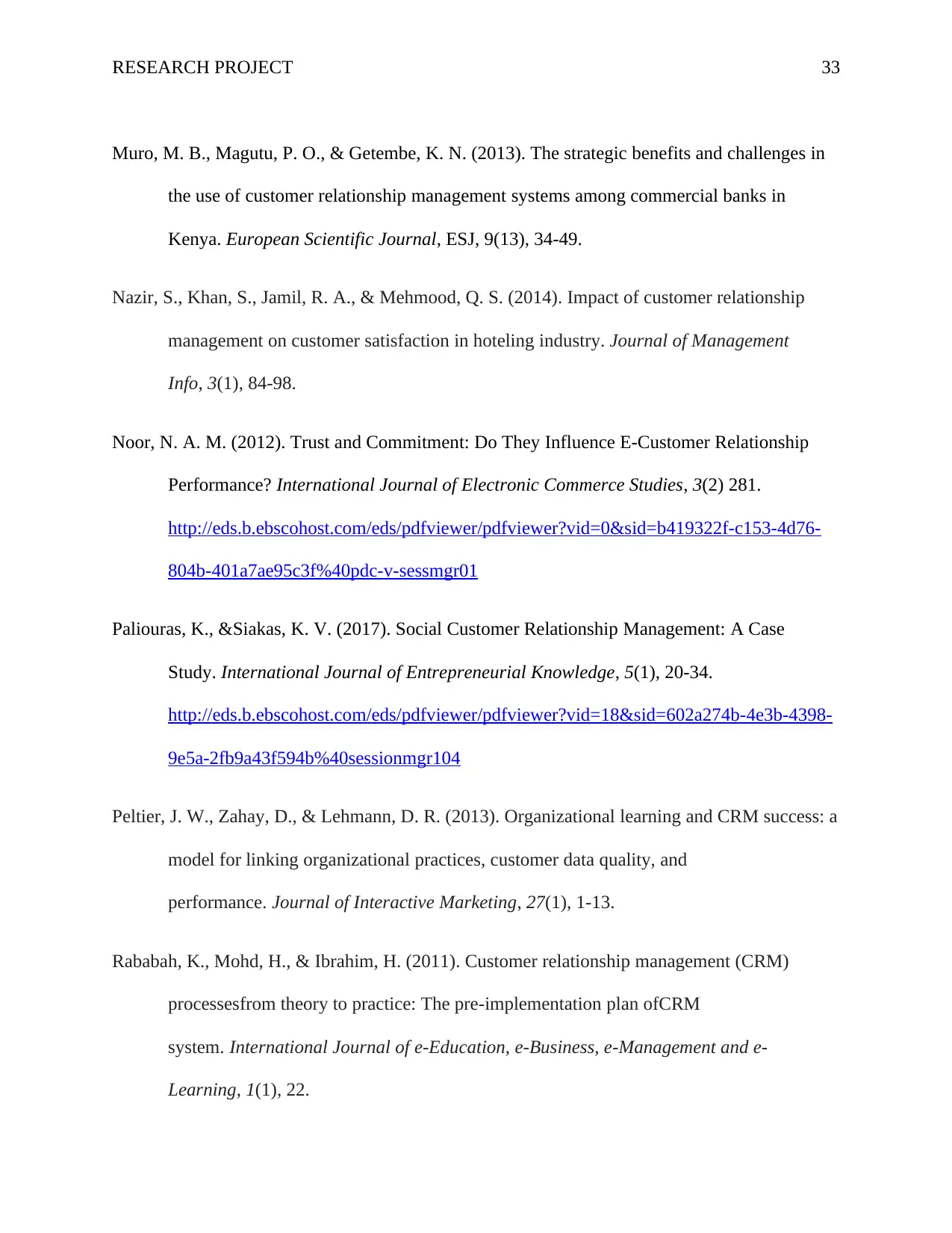
RESEARCH PROJECT 33
Muro, M. B., Magutu, P. O., & Getembe, K. N. (2013). The strategic benefits and challenges in
the use of customer relationship management systems among commercial banks in
Kenya. European Scientific Journal, ESJ, 9(13), 34-49.
Nazir, S., Khan, S., Jamil, R. A., & Mehmood, Q. S. (2014). Impact of customer relationship
management on customer satisfaction in hoteling industry. Journal of Management
Info, 3(1), 84-98.
Noor, N. A. M. (2012). Trust and Commitment: Do They Influence E-Customer Relationship
Performance? International Journal of Electronic Commerce Studies, 3(2) 281.
http://eds.b.ebscohost.com/eds/pdfviewer/pdfviewer?vid=0&sid=b419322f-c153-4d76-
804b-401a7ae95c3f%40pdc-v-sessmgr01
Paliouras, K., &Siakas, K. V. (2017). Social Customer Relationship Management: A Case
Study. International Journal of Entrepreneurial Knowledge, 5(1), 20-34.
http://eds.b.ebscohost.com/eds/pdfviewer/pdfviewer?vid=18&sid=602a274b-4e3b-4398-
9e5a-2fb9a43f594b%40sessionmgr104
Peltier, J. W., Zahay, D., & Lehmann, D. R. (2013). Organizational learning and CRM success: a
model for linking organizational practices, customer data quality, and
performance. Journal of Interactive Marketing, 27(1), 1-13.
Rababah, K., Mohd, H., & Ibrahim, H. (2011). Customer relationship management (CRM)
processesfrom theory to practice: The pre-implementation plan ofCRM
system. International Journal of e-Education, e-Business, e-Management and e-
Learning, 1(1), 22.
Muro, M. B., Magutu, P. O., & Getembe, K. N. (2013). The strategic benefits and challenges in
the use of customer relationship management systems among commercial banks in
Kenya. European Scientific Journal, ESJ, 9(13), 34-49.
Nazir, S., Khan, S., Jamil, R. A., & Mehmood, Q. S. (2014). Impact of customer relationship
management on customer satisfaction in hoteling industry. Journal of Management
Info, 3(1), 84-98.
Noor, N. A. M. (2012). Trust and Commitment: Do They Influence E-Customer Relationship
Performance? International Journal of Electronic Commerce Studies, 3(2) 281.
http://eds.b.ebscohost.com/eds/pdfviewer/pdfviewer?vid=0&sid=b419322f-c153-4d76-
804b-401a7ae95c3f%40pdc-v-sessmgr01
Paliouras, K., &Siakas, K. V. (2017). Social Customer Relationship Management: A Case
Study. International Journal of Entrepreneurial Knowledge, 5(1), 20-34.
http://eds.b.ebscohost.com/eds/pdfviewer/pdfviewer?vid=18&sid=602a274b-4e3b-4398-
9e5a-2fb9a43f594b%40sessionmgr104
Peltier, J. W., Zahay, D., & Lehmann, D. R. (2013). Organizational learning and CRM success: a
model for linking organizational practices, customer data quality, and
performance. Journal of Interactive Marketing, 27(1), 1-13.
Rababah, K., Mohd, H., & Ibrahim, H. (2011). Customer relationship management (CRM)
processesfrom theory to practice: The pre-implementation plan ofCRM
system. International Journal of e-Education, e-Business, e-Management and e-
Learning, 1(1), 22.
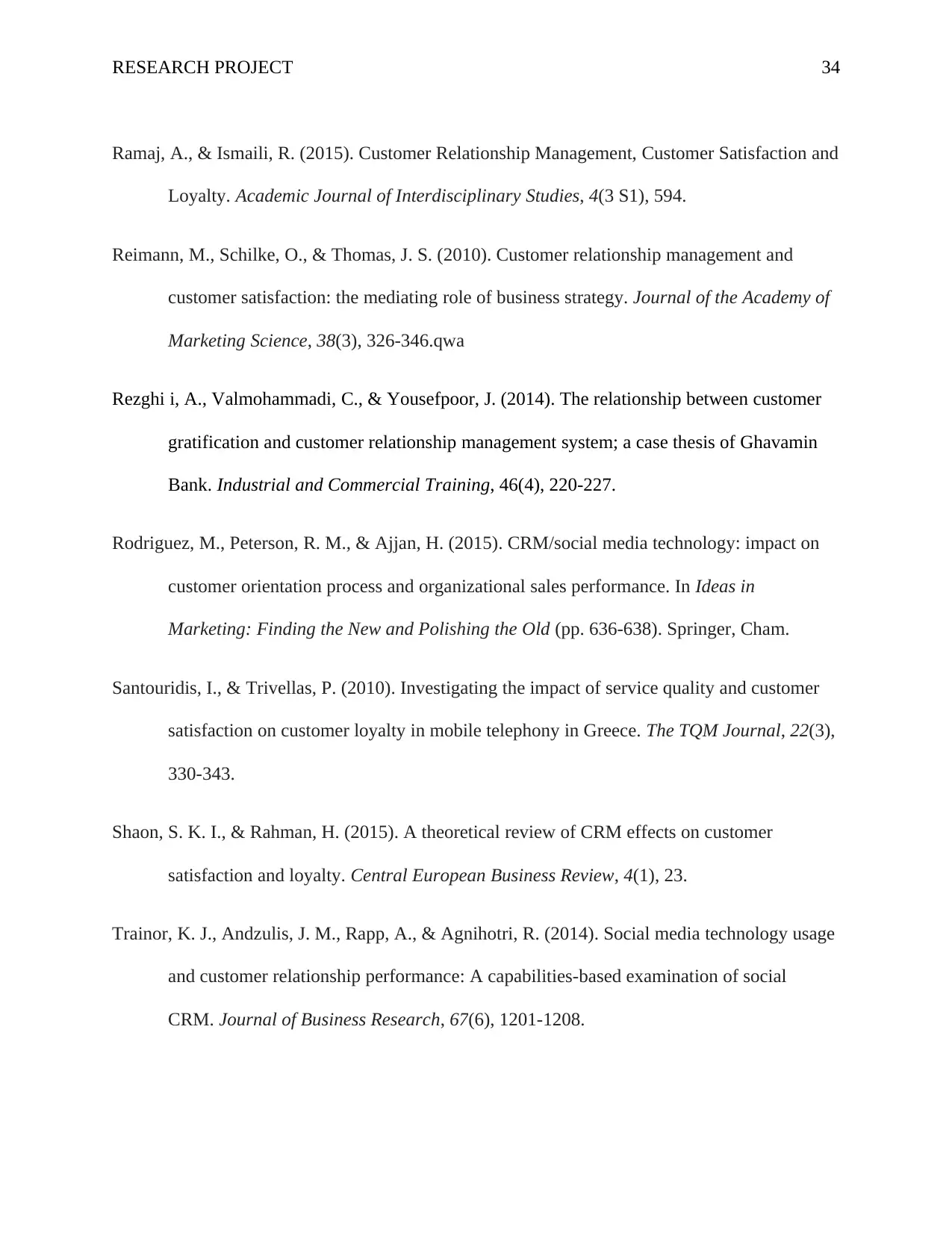
RESEARCH PROJECT 34
Ramaj, A., & Ismaili, R. (2015). Customer Relationship Management, Customer Satisfaction and
Loyalty. Academic Journal of Interdisciplinary Studies, 4(3 S1), 594.
Reimann, M., Schilke, O., & Thomas, J. S. (2010). Customer relationship management and
customer satisfaction: the mediating role of business strategy. Journal of the Academy of
Marketing Science, 38(3), 326-346.qwa
Rezghi i, A., Valmohammadi, C., & Yousefpoor, J. (2014). The relationship between customer
gratification and customer relationship management system; a case thesis of Ghavamin
Bank. Industrial and Commercial Training, 46(4), 220-227.
Rodriguez, M., Peterson, R. M., & Ajjan, H. (2015). CRM/social media technology: impact on
customer orientation process and organizational sales performance. In Ideas in
Marketing: Finding the New and Polishing the Old (pp. 636-638). Springer, Cham.
Santouridis, I., & Trivellas, P. (2010). Investigating the impact of service quality and customer
satisfaction on customer loyalty in mobile telephony in Greece. The TQM Journal, 22(3),
330-343.
Shaon, S. K. I., & Rahman, H. (2015). A theoretical review of CRM effects on customer
satisfaction and loyalty. Central European Business Review, 4(1), 23.
Trainor, K. J., Andzulis, J. M., Rapp, A., & Agnihotri, R. (2014). Social media technology usage
and customer relationship performance: A capabilities-based examination of social
CRM. Journal of Business Research, 67(6), 1201-1208.
Ramaj, A., & Ismaili, R. (2015). Customer Relationship Management, Customer Satisfaction and
Loyalty. Academic Journal of Interdisciplinary Studies, 4(3 S1), 594.
Reimann, M., Schilke, O., & Thomas, J. S. (2010). Customer relationship management and
customer satisfaction: the mediating role of business strategy. Journal of the Academy of
Marketing Science, 38(3), 326-346.qwa
Rezghi i, A., Valmohammadi, C., & Yousefpoor, J. (2014). The relationship between customer
gratification and customer relationship management system; a case thesis of Ghavamin
Bank. Industrial and Commercial Training, 46(4), 220-227.
Rodriguez, M., Peterson, R. M., & Ajjan, H. (2015). CRM/social media technology: impact on
customer orientation process and organizational sales performance. In Ideas in
Marketing: Finding the New and Polishing the Old (pp. 636-638). Springer, Cham.
Santouridis, I., & Trivellas, P. (2010). Investigating the impact of service quality and customer
satisfaction on customer loyalty in mobile telephony in Greece. The TQM Journal, 22(3),
330-343.
Shaon, S. K. I., & Rahman, H. (2015). A theoretical review of CRM effects on customer
satisfaction and loyalty. Central European Business Review, 4(1), 23.
Trainor, K. J., Andzulis, J. M., Rapp, A., & Agnihotri, R. (2014). Social media technology usage
and customer relationship performance: A capabilities-based examination of social
CRM. Journal of Business Research, 67(6), 1201-1208.
1 out of 34
Related Documents
Your All-in-One AI-Powered Toolkit for Academic Success.
+13062052269
info@desklib.com
Available 24*7 on WhatsApp / Email
![[object Object]](/_next/static/media/star-bottom.7253800d.svg)
Unlock your academic potential
© 2024 | Zucol Services PVT LTD | All rights reserved.





